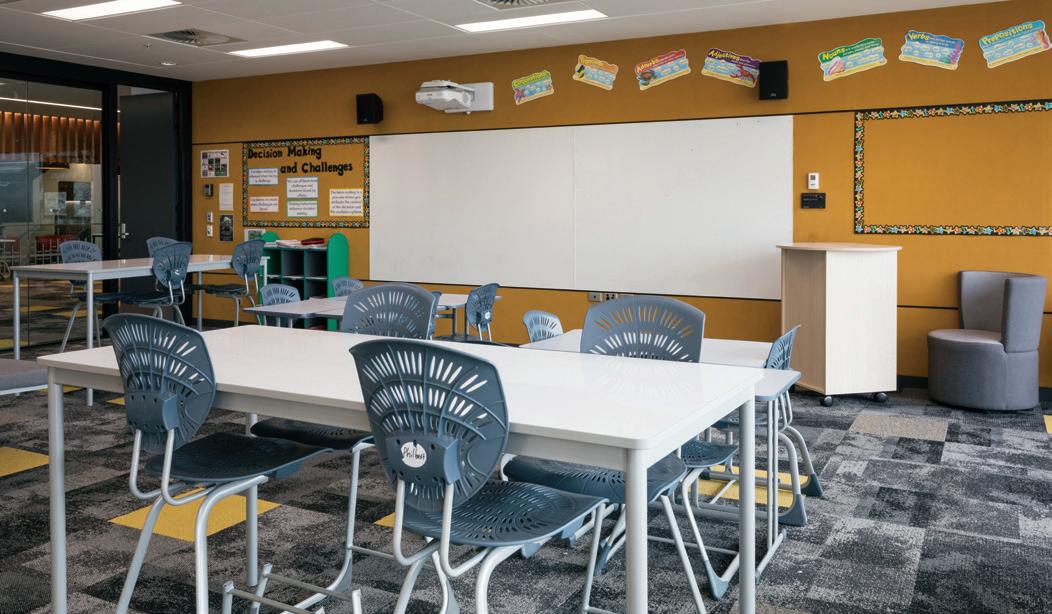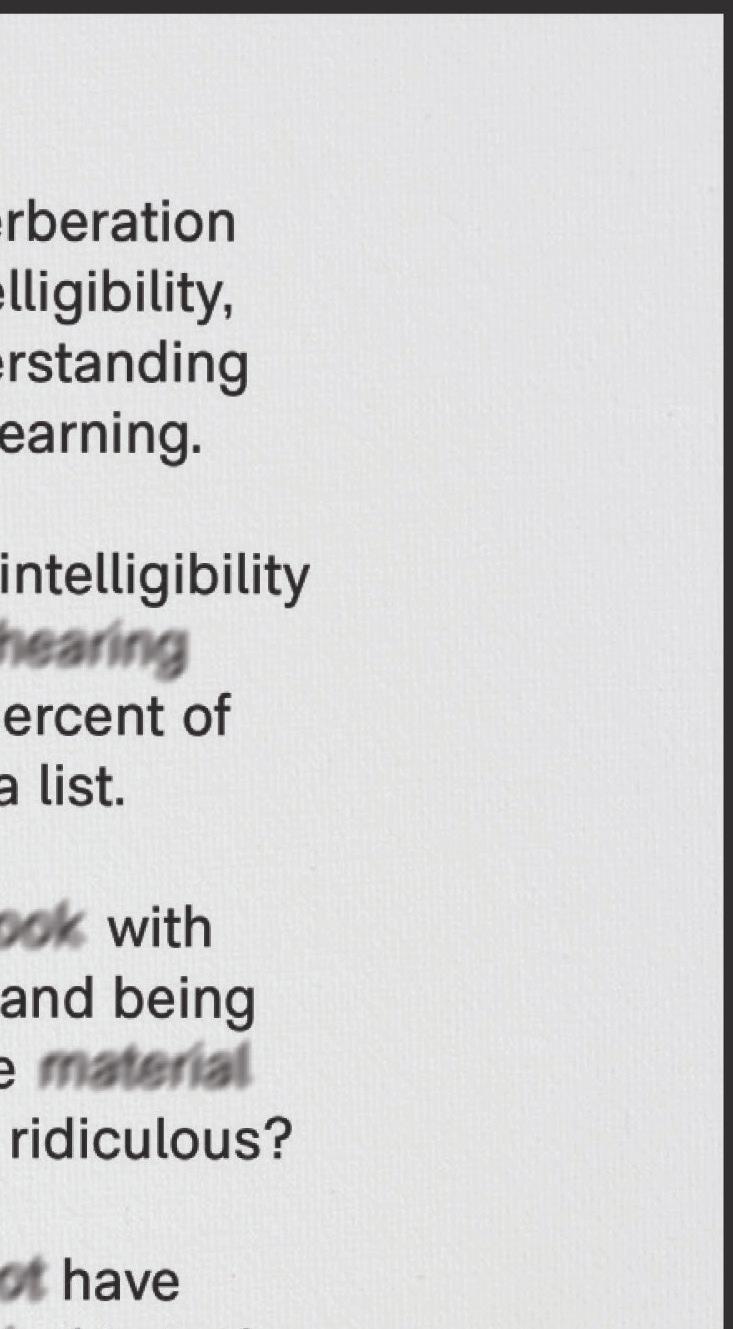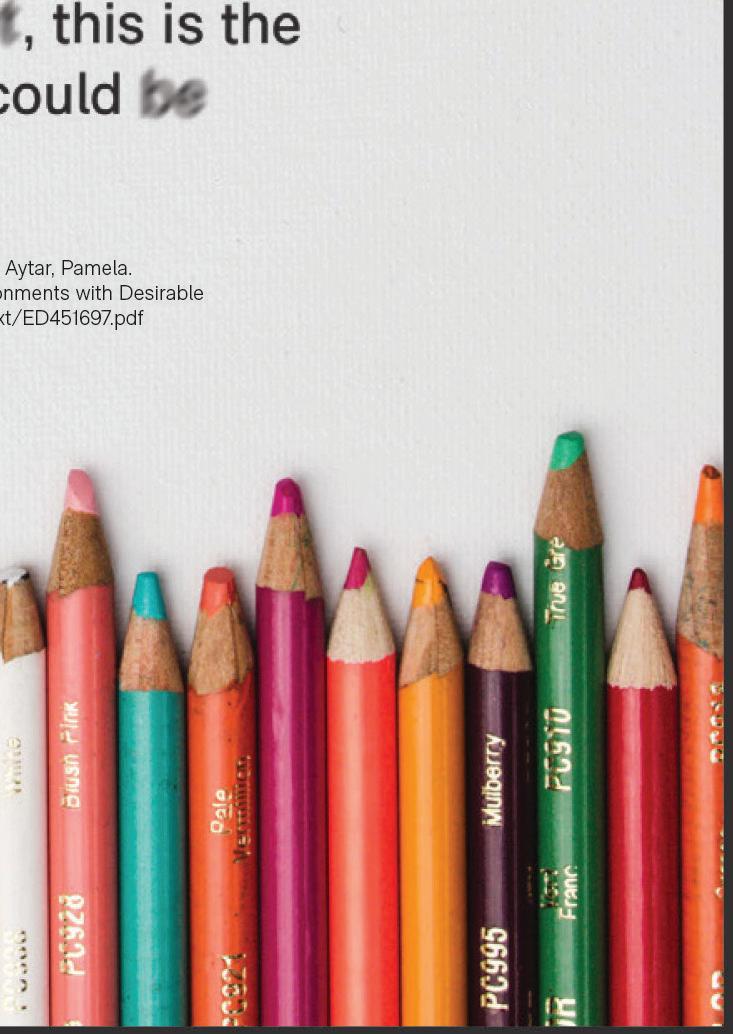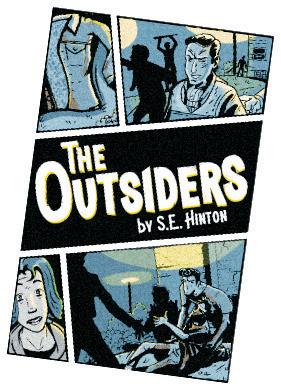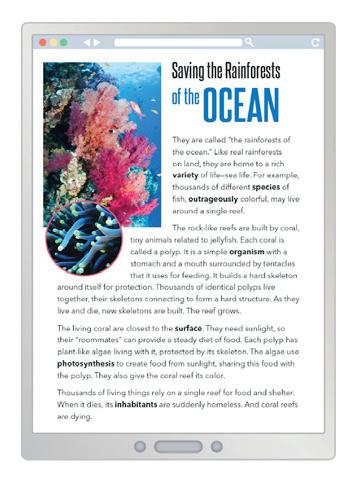ROGER FOR EDUCATION: HEARING FOR EVERYONE



















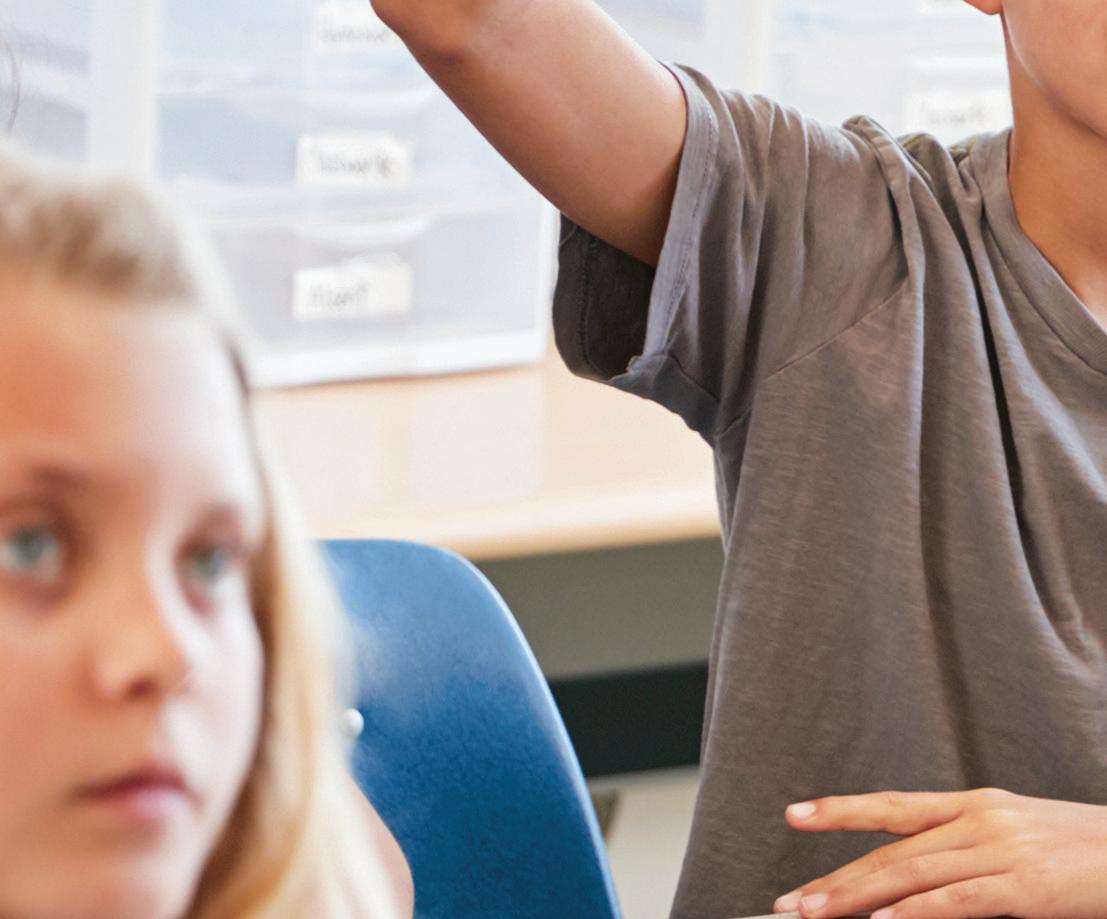







ROGER FOR EDUCATION: HEARING FOR EVERYONE






























EXTENSIVE RESEARCH:
2 years of product development before launch.


RIGOROUS TESTING:

3 years testing of Cushionfall by 3 councils in 5 playgrounds before council approval.

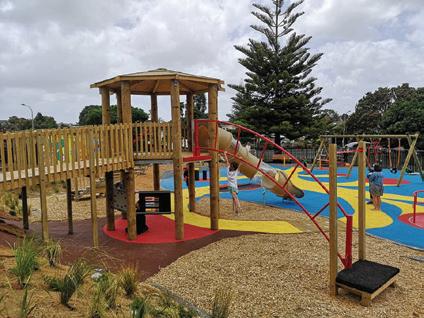


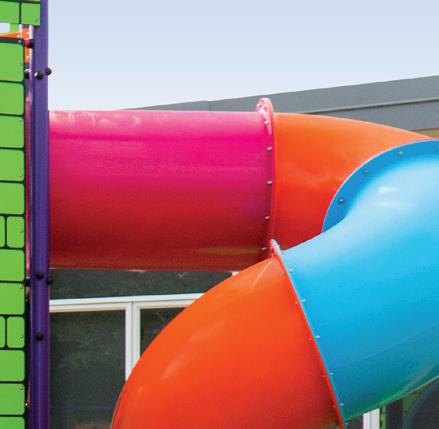
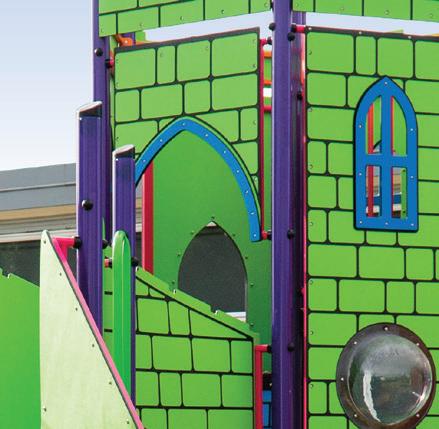
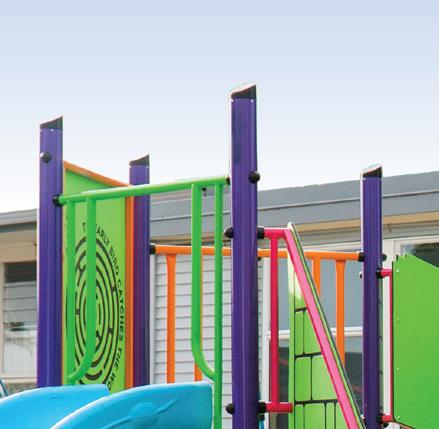
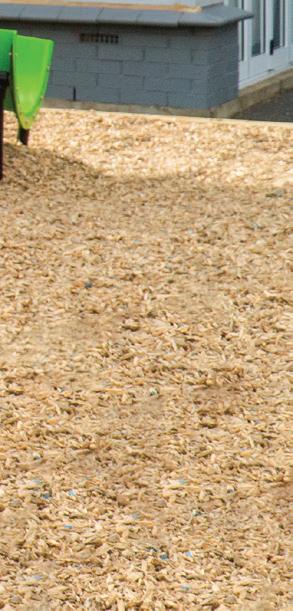


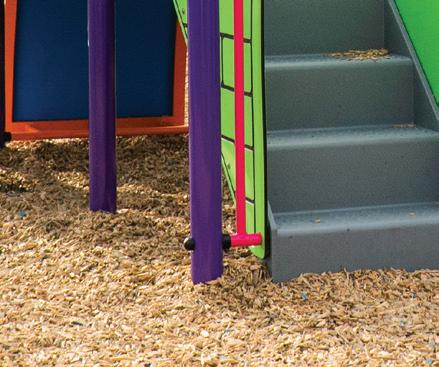
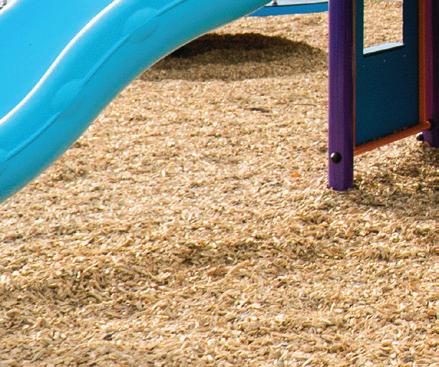

ONGOING QUALITY TESTING:



More than 50 tests in the last 10 years alone!
HIGHEST IMPACT TESTS: In Australasia achieved.
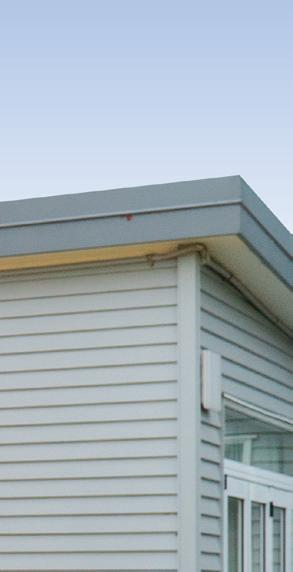



PREFERRED CHOICE:



Councils, the Ministry of Education, Kindergarten Associations, Play Centre Associations and Preschool Centres.


We are so devoted to ensuring supreme quality and safety that we have spent 15 years perfecting our grinder that produces our wood chip so that it removes all traces of nails, staples and hazardous metals/materials, and has no “sharp edges”. Since safety is paramount - we implement an extensive testing regime every two to three years, evaluating the impact e ciency of the wood chips being produced.




School News is distributed to primary, secondary and intermediate schools throughout New Zealand by Multimedia Publishing Limited.

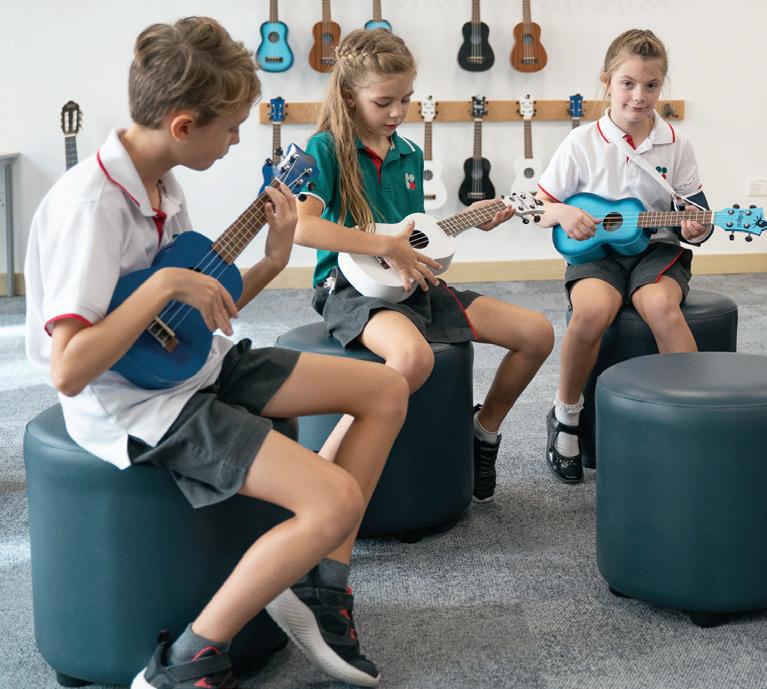

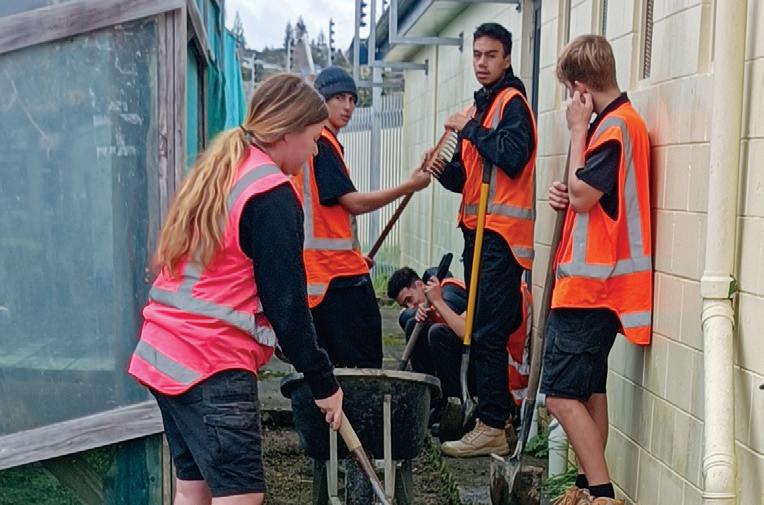
The views and images expressed in School News do not necessarily reflect the views of the publisher. The information contained in School News is intended to act as a guide only, the publisher, authors and editors expressly disclaim all liability for the results of action taken or not taken on the basis of information contained herein. We recommend professional advice is sought before making important business decisions.
The publisher reserves the right to refuse to publish or to republish without any explanation for such action. The publisher, it’s employees and agents will endeavour to place and reproduce advertisements as requested but takes no responsibility for omission, delay, error in transmission, production deficiency, alteration of misplacement. The advertiser must notify the publisher of any errors as soon as they appear, otherwise the publisher accepts no responsibility for republishing such advertisements. If advertising copy does not arrive by the copy deadline the publisher reserves the right to repeat existing material.
Disclaimer
Any mention of a product, service or supplier in editorial is not indicative of any endorsement by the author, editor or publisher. Although the publisher, editor and authors do all they can to ensure accuracy in all editorial content, readers are advised to fact check for themselves, any opinion or statement made by a reporter, editor, columnist, contributor, interviewee, supplier or any other entity involved before making judgements or decisions based on the materials contained herein.
School News its publisher, editor and staff, is not responsible for and does not accept liability for any damages, defamation or other consequences (including but not limited to revenue and/or profit loss) claimed to have occurred as the result of anything contained within this publication, to the extent permitted by law.
Advertisers and Advertising Agents warrant to the publisher that any advertising material placed is in no way an infringement of any copyright or other right and does not breach confidence, is not defamatory, libellous or unlawful, does not slander title, does not contain anything obscene or indecent and does not infringe the Consumer Guarantees Act or other laws, regulations or statutes. Moreover, advertisers or advertising agents agree to indemnify the publisher and its’ agents against any claims, demands, proceedings, damages, costs including legal costs or other costs or expenses properly incurred, penalties, judgements, occasioned to the publisher in consequence of any breach of the above warranties. © 2023 Multimedia Publishing Ltd. It is an infringement of copyright to reproduce in any way all or part of this publication without the written consent of the publisher.
PO Box 5104, Papanui, Christchurch, 8542, NZ Phone: (03) 365 5575 Fax: (03) 365 1655 mail@schoolnews.co.nz www.schoolnews.co.nz

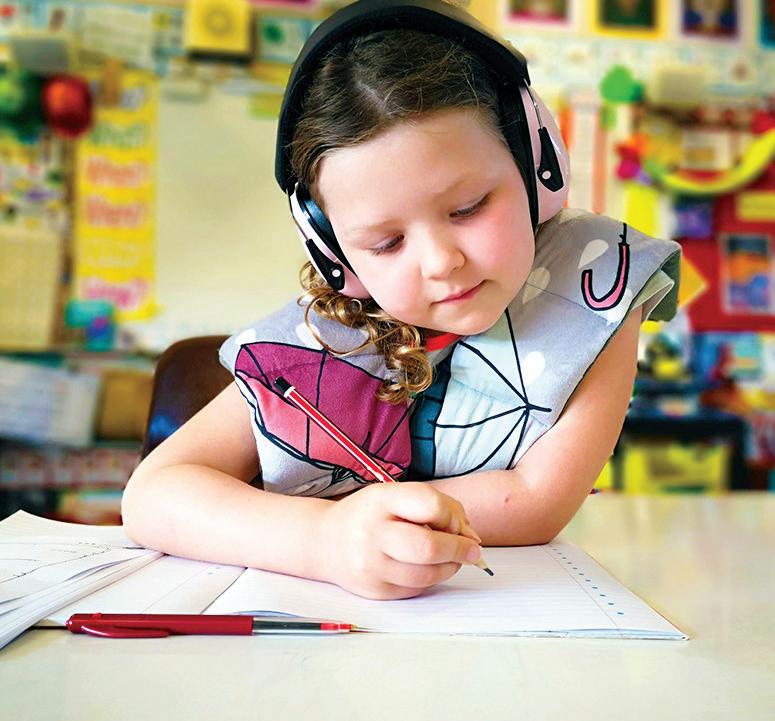
ISSN 1178-9964 (Print) ISSN 1179-2124 (Digital)
EDITOR
Gemma Easton, editor@schoolnews.co.nz
INDUSTRY REPORTERS
Naomii Seah & Sarah Davison
DESIGN & PRODUCTION
Richard McGill, production@schoolnews.co.nz
ADVERTISING
Dee Dawson, advertising@schoolnews.co.nz
CONTRIBUTORS
Carla McNeil and Graeme Norman
KEY
Commercially funded supplier profile or supplier case study
Supplier information or content
Suppliers
When I worked in schools, my colleagues and I found it easy to measure time in blocks –number of sessions or periods left in a day, days left in a week, weeks left in a term. For an average 10-week term, we would count up until week fi ve, and then from week six, the countdown was on. Only four weeks to go! Now three weeks! Only two weeks left !
It is easy to wish the time away, as we look forward to the summer holidays. At this time of year, the amount of work left to get to the finish line can feel overwhelming. And as the planning for end of year activities begins, the mountain of work left to be done can feel insurmountable.
Instead of thinking about what is still to be done, why not reflect on all that you have achieved already this year; focus on the small wins, and all the things you have cleared from your to-do list
Gemma Easton Editor, SchoolNews editor@schoolnews.co.nz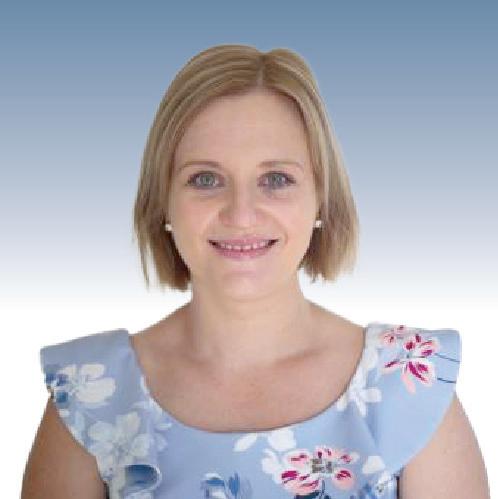
or inbox. Look forward to all the opportunities left to still achieve great things this year. Whether it is a small change or initiative you want to try in your classroom, or a broader department or school-wide program you have been thinking about, seize the opportunity that the rest of the school year brings to make progress. We tell tamariki to give everything their best, so
we should extend the same expectations to ourselves.
Penning our Principal Speaks column this edition is Graeme Norman from Te Kōmanawa Rowley School. Drawing on his own experience in the education sector, Graeme provides insights into equity in Aotearoa New Zealand schools, and suggests practical steps that can be taken to improve equality of access to learning for all students, regardless of their background, culture or personal circumstances.
Investigating diff erent educational pathways, our Profile focusses on Kamo High School’s Trade Academy. Off ering an alternative method of curriculum delivery, the academy focusses on skills development and hands on learning. A departure from the usual classroom set up, students blend elements of science, maths, English and a breadth of other curriculum
areas to complete projects around the school, and for the community. Our industry reporter Naomii Seah visited the school and was given a tour of the facilities, and met some of the students. Eight percent of primary school age ākonga have a disability or diff erent learning need, and 15 percent of intermediate or secondary school age students. Classrooms, then, need to be inclusive of all learning needs. In our editorial feature, we explore ways to make learning accessible to all students, including those with a disability, gifted and talented tamariki, and those for whom English is an additional language or dialect. I hope you enjoy this edition of School News, the second last one for this year. Not that I am counting down, though!
Ngā mihi, Gemma
Rotorua Blue Lake TOP 10 have a wide variety of accommodation options available to suit every budget, from 180 powered and non-powered tent sites to standard and self-contained cabins.
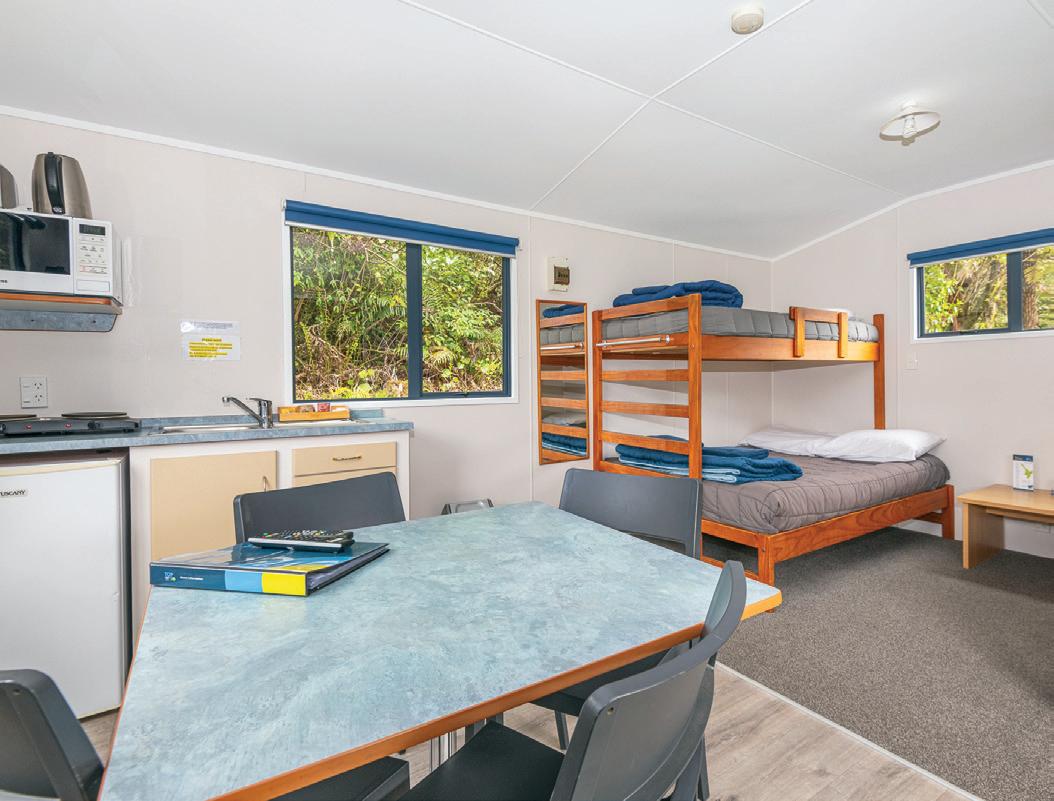
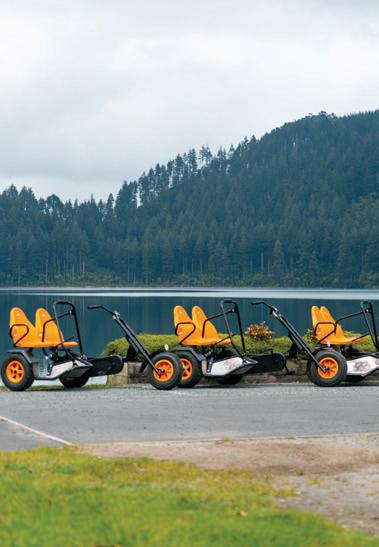
The facilities at the park will keep your group entertained and active. We offer a private or sole use marquee with attached kitchen and BBQ that can accommodate up to 80 people. The park is central to a variety of local attractions.
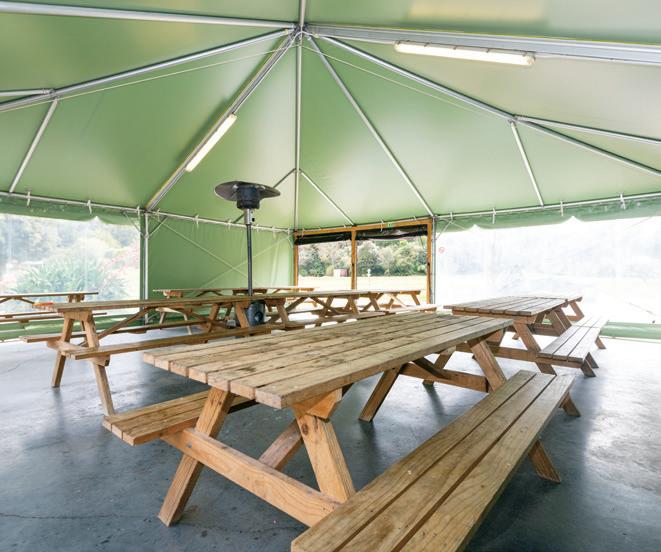
Lakes Tarawera, Okareka and Rotokakahi are all within 2km of the park, and a short 8km drive will find you in the centre of Rotorua.
Rotorua Blue Lake TOP 10 offer large groups heavily
discounted rates from February – November (excluding peak season only) and can work with you to accommodate any size group and any budget.
For more information please call 0800 808 292 or visit www.bluelaketop10.co.nz
With a year of prolonged strike action and continued attention on how to ensure staff recruitment and retention, School News decided to look at the research – how can we keep educators in the sector?
For much of the past year, educators have been fighting for better resourcing, pay and support in the education sector. To attract and retain teachers, educators have been pushing for pay-rates to keep pace with inflation and urging the Ministry of Education to put through provisions to improve working conditions.
Despite this discourse, the data shows that rates of teachers leaving the workforce have been in slight decline from 2004 to 2020, from around 10 percent in 2004 to 7 percent in 2020. However, recent evidence, both statistical and anecdotal, suggests that this rate may have increased over the past two years and may be about to spike.
On the ground, principals and boards are reporting a shortage
of applicants for any vacancies, and issues around retention. Several recent reports back this finding, with PPTA Te Wehengarua finding that one in seven class positions at the secondary level had no applicants at all.
Due to the shortage of suitable candidates, the annual staffing survey conducted by the union found that quality of education may be falling. Around 48 percent of principals employed untrained or unqualified teachers. The availability of relief staff is also the lowest on record, and classes are having to be cancelled or transferred due to a lack of specialist teachers.

Retirement and non-teaching jobs remain at the top of the list for teachers leaving the profession, and unions have stated that more teachers may leave for non-teaching jobs should pay remain low when compared to jobs with comparable skill-sets.
Attracting new teachers to the profession looks set to remain an issue, too. Tertiary institutions have reported a huge drop in enrolments for teacher-education programmes this year, and some fear the numbers may not be enough to cover even the demand in Auckland schools.

Speaking to RNZ, Auckland Secondary Schools Principals
Association president Greg Pierce said “I think there are approximately 700 nationally, secondary graduates, and we have over 100 secondary schools in Auckland and if they are averaging recruiting say 10 firstyear teachers, that’s already 1000 let alone the rest of the country.”
Pierce added that he believed an increase in starting salary would help attract more teachers to the profession.
But it’s not about the money for some. Penny Sinclair, who had been a teacher for more than 30 years when she quit the profession in 2022, told Newshub Nation that she was “exhausted”.
“I taught at the most incredible school, amazing kids, just the best staff, a brilliant principal, but I couldn’t do it anymore.”
Like many other teachers, Sinclair says she experienced major burnout, leading to her decision to leave the job.
And it’s not just teachers who are suffering a recruitment crisis. In June, NZEI Te Riu Roa released the findings of their Principal Sentiment Snapshot Survey, which surveyed a third of primary principals in the profession. The union similarly characterised these findings as a “crisis” in leadership. Principals reported a lack of support, making the position unsustainable. One key finding was that around half of all new principals intended on leaving the role within five years.
Speaking to Newshub, New Zealand Principals’ Federation president Leanne Otene said that principal turnover was high.
“Principals feel battered. Battered by politicians and battered by the public. Everyone is overwhelmed – principals and teachers alike – at the magnitude of the job. Our bread and butter is teaching and learning and that’s certainly not all we do.”
Education cannot survive on passion and goodwill alone


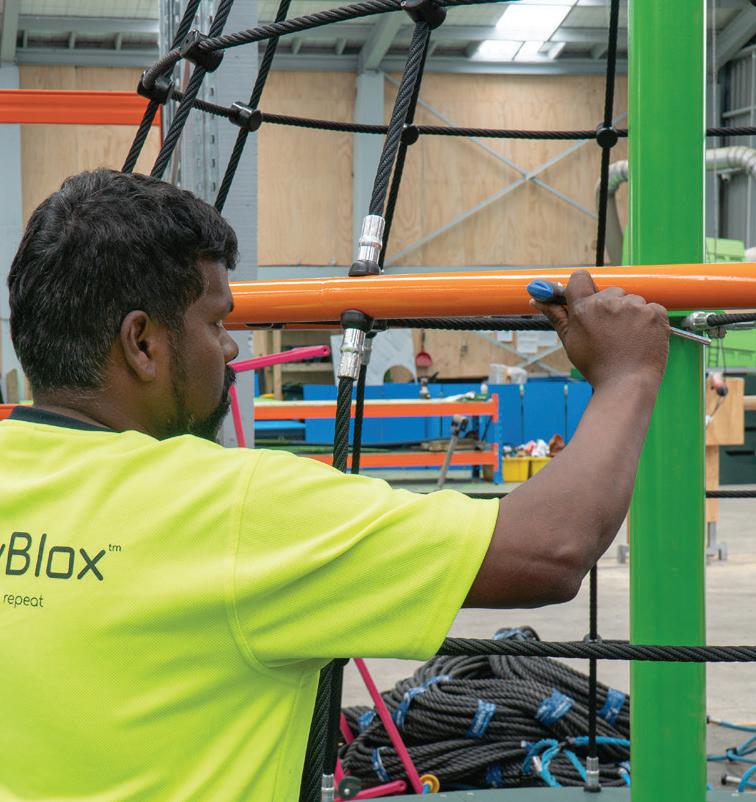



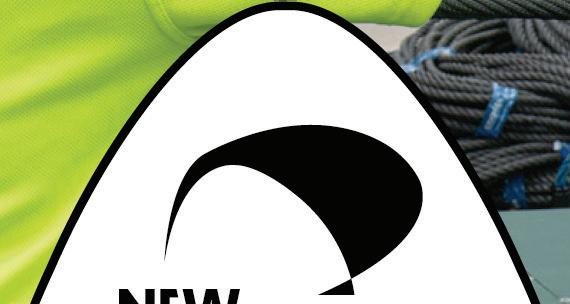






Despite the grim nature of the evidence, all hope is not lost. There are several policy decisions, or even school-level interventions that have been shown to make a difference in teacher retention.

In the UK, rates of teachers leaving the profession are similar to New Zealand at around 10 percent a year. Teacher recruitment targets are also continually being missed in the UK, which mirrors New Zealand’s pattern of declining teaching graduates in tertiary education. Recently, a survey of 300 teachers was carried out in the UK to identify what factors are contributing to teachers leaving the profession. The survey found that a reduction in hours was one of the most effective interventions.1 Teachers were also more likely to stay if the quality of school leadership was high. Additionally, pay was a significant factor, though only if a raise was more than 10 percent. The survey also found that those on the higher end of the pay scale were less likely to leave than those on the lower end.
Significantly, the recent collective agreement settled on between the Ministry of Education and primary educators’ union NZEI Te Riu Roa sees a pay increase well below that 10 percent threshold. In fact, the latest offer doesn’t meet inflation, being around a six percent increase per year. Current annual inflation
in New Zealand remains high at around 7.7 percent. That means this recent offer may not be enough to incentivise primary teachers to stay in the job.
On top of incentivising teachers to remain in their profession, pay-rises can also have a measurable impact on motivation, recruitment and quality of teachers.1,2 Over an academic year, a 10 percent increase in teaching wages has been shown to have beneficial academic effect for students – the same as a one pupil decrease in class-size or an extra hour teaching time.2
Crucially, the UK survey found that other interventions were perhaps more effective than a pay rise at improving teacher retention. Senior leadership was found to have a big impact on teachers’ intentions to leave. A good leadership team may be more effective at improving teacher retention than a five percent pay rise.1
Working hours was another major factor for teacher retention. The same survey concluded that simply reducing working hours by five a week (where most teachers worked an average of 52 hours a week), would improve retention by almost the same measure as a 10 percent pay rise.1
Of course, many of the above interventions rely on the Ministry of Education to implement national policies. Without adequate supports and funding, reducing workload
for teachers, pay-rises and improving outcomes for tamariki and kaiako could remain out of reach. However, there are also some interventions possible at the individual school level which may help to retain teachers, especially new teachers, of which over a third leave before their third year of teaching.3
A 2007 study conducted by NZCER looked at a large cohort of New Zealand teachers of “particular promise”.3 Teachers described induction experiences and identified supportive practices that made them more likely to remain in their role. Although 2007 was a while ago, the principles likely still apply to current beginner teachers. The data, though, did not include follow-ups so it is not certain how many of the teachers in this study remained in the profession.
The study’s results indicated that, teachers with principals that protected beginner teachers from burnout (ensuring access to PRT, preventing internal absence cover, extraneous duties) were more likely to feel supported. Selecting good tutor teachers (mentors) was also critical, as was ensuring that the mentor support was accessible via proximity and release time. PLD opportunities and a strong community amongst colleagues were also important factors to support new teachers. Of course, implementing these school-level supports is somewhat dependent on the
national conversation around education. Without adequate resourcing and support for principals, for example, those in the leadership positions may not be able to offer the above supports to beginner teachers. Ultimately, teachers enter and remain in the profession largely due to a love of the community and the work. Education is a difficult and often thankless sector, and those who are drawn to the profession often find their vocation here.
Still, the research is clear. Education and indeed other professions cannot survive on passion and goodwill alone. Structural incentives both on the national and school-wide level do make a difference to retaining and recruiting teachers. With the current climate in education, paying attention to these factors may just be the difference between a thriving school system, and one which continually struggles to meet the demands of our growing country.
References
1 Fullard, Joshua. (2023). Labour Market Expectations and Occupational Choice: Evidence from Teaching. http:// dx.doi.org/10.2139/ssrn.4384928
2 Fullard, Joshua. (2021). Does money motivate teachers? BERA Blog. Accessed 14/06/2023 from” bera.ac.uk/ blog/does-money-motivate-teachers
3 Cameron, Marie, Susan Lovett and Jennifer Garvey Berger. (2007). Starting out in teaching: Surviving or thriving as a new teacher. Set: Research Information for Teachers, (3), 32–37. doi:10.18296/set.0553
Healthier food options for New Zealand’s hungry learners.








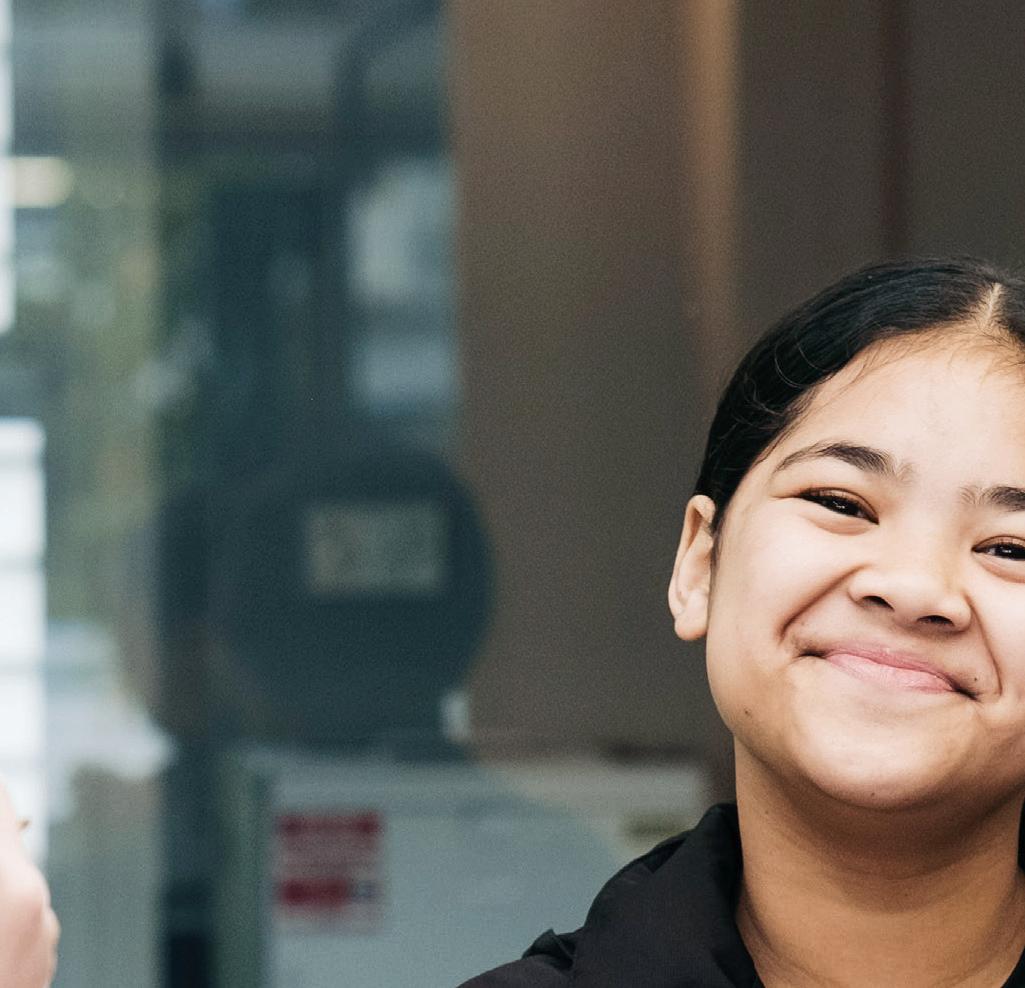

• Top quality, freshly made lunches for learners.




• On-site or delivery service, tailored to suit you.





• Professionally audited food control plan.


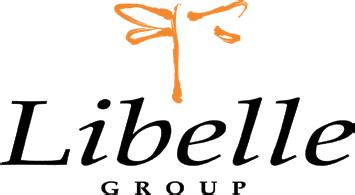
• Trained, qualified, local sta .
It’s simple: Let our professionals feed hungry students, while your professionals feed hungry minds.




education system, creating an even playing field for everybody. Currently, we do not have equal access to funding and resources which ensure the children in our care get a good education. My wish is for anyone from anywhere – any economic, social background, any cultural background – to have equitable access to education in New Zealand.
SchoolPrincipal

Rowley School addresses equity, inclusion and access in this Term’s edition of Principal Speaks.

I wanted to take this opportunity to talk about equity in education. There have been concerns about inequities in funding for primary schools for a long time. While generally our system works, disparities in funding and resourcing can contribute to unequal opportunities and outcomes for students.
Despite efforts to create an equitable system, I still have concerns about funding inequities. I would argue that the current funding system is not sufficient to address the underlying disparities in resources and opportunities between schools. I acknowledge that additional funding or resourcing alone may not be enough to tackle the complex issues that contribute to inequity in education outcomes for all.
Our system talks about equity, but I don’t believe that it is totally equitable for everybody. We need to be looking at this, and addressing it within the
I have been in education since 2002, with the past nine years as principal. Currently, I’m at Te Kōmanawa Rowley School. Our school is in a low socioeconomic area. During my time here as principal, I’ve seen the inequities of our school system first-hand. One of my observations is that money is distributed inequitably under our current model. The equity funding system treats one low socioeconomic school much the same as another. It doesn’t matter what area you are from or what needs there might be in your community, current funding

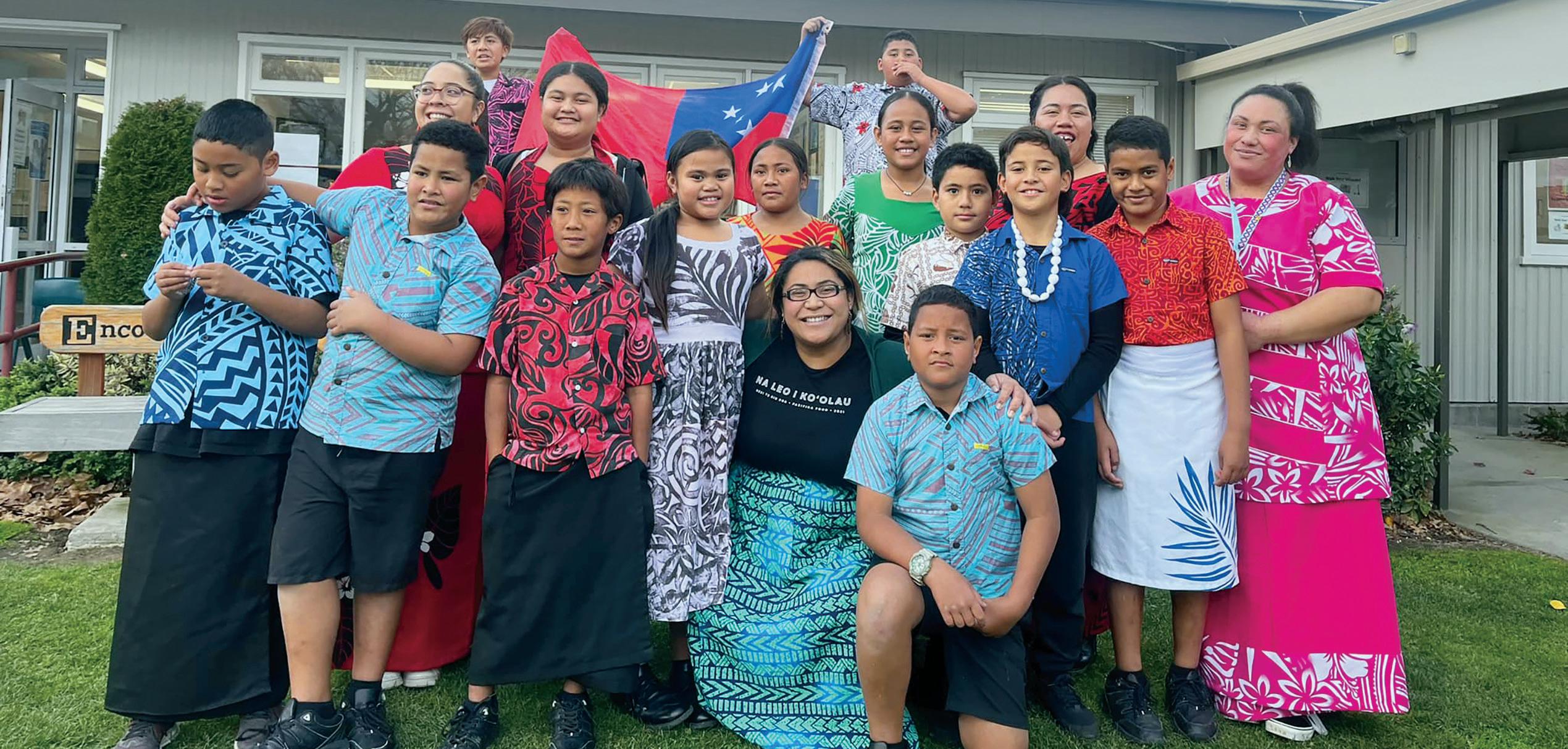
models don’t look adequately at the needs of specific schools. Our school needs more Learning Support Assistance. Currently, we have more than half our school on our support register, but this is not recognised in the current system, so we need to fund eight LSAs to support our children. Because we see children’s learning and wanting to be at school as a priority, we must sacrifice other things. I recognise that we do get more money through the equity system but it’s not enough to cover these costs.
Another example of inequity in our system is that we don’t have access to a Kāhui Ako and
cannot join a Kāhui Ako. I came to this school just after they stopped letting new schools join. There is extensive funding and resources that aren’t available to us because of this – if we were in a Kāhui Ako we would be able to access more resources and we could get a Learning Support Coordinator. We have students with very high needs, and they would benefit from having access to these resources, yet I cannot. How is this fair and equitable?
There are also regional specific needs that aren’t addressed through the current system. It doesn’t matter if you’re in Auckland, Wellington or
A higher degree of trust is needed between the Ministry and local principals
Invercargill, everyone gets the same. Everyone’s needs, though, are different and this should be considered. In Hawkes Bay at present, for example, they should have a different funding model that adapts to needs following the trauma of the cyclone. This kind of allowance needs to be built into the system, rather than as a one-off disaster response. By doing this we would make it more equitable for the children in disaster affected areas for a number of years.
Within regions, there can be variations in the needs of each
school community. We are in a low socioeconomic area, but our school operates within a specific context that creates unique needs. These needs may be different from a school operating on the other side of town that is of similar social economic background.
An example of this is the composition of our student body. Although Te Kōmanawa Rowley is a school in Christchurch, we have a very high Māori and Pacific roll, with 40 percent Pacific and 38 percent Māori. That’s unusual in Christchurch, or even in the South
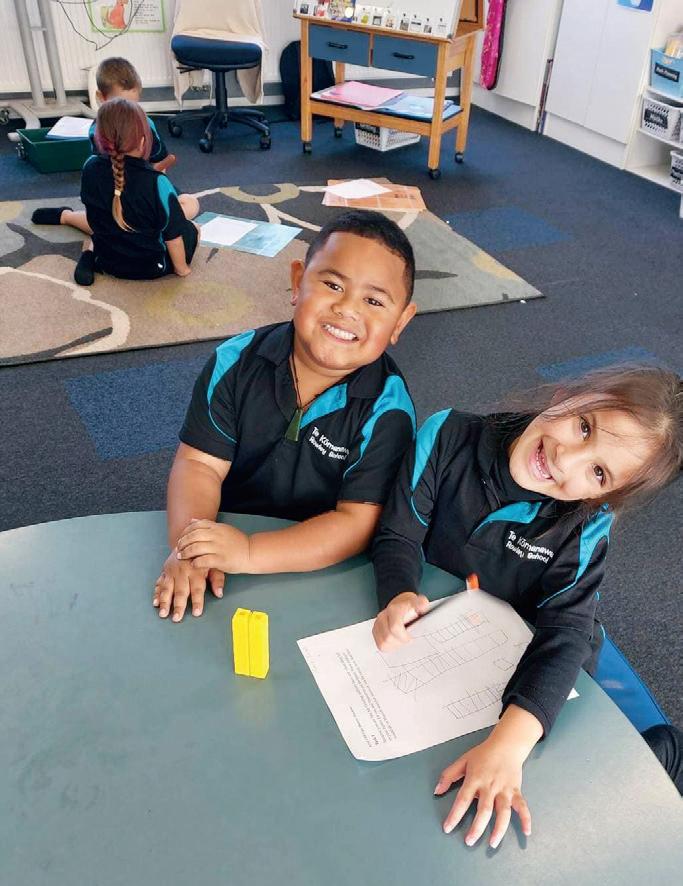

Island. This means the needs of the schools are different, as we cater for children from different cultural contexts and try to adapt our programme. An example of this is we run Gagana Samoan lessons across our school.
We’re in a cost-of-living crisis, which affects everyone. But for the lowest socioeconomic where there’s no disposable income, it’s hitting the hardest. The barriers we see for these families sending their children to school are immense and varied. We’re lucky that we get
school lunches, but there are schools down the road that don’t, though they have children in need. Even some schools considered high decile under the old system aren’t getting what they need to support their families in this economic crisis. To make it equitable, everyone should get school lunches. That’s how it’s done around the rest of the world. To be truly equitable, people need equal access.
Currently, I have children still coming to school in shorts and T-shirts, and we have had three days in a row of 0-degree starts.
• All-weather canopies provide year-round protection for learning and play.
• Covered walkways, sandpits, decking and playgrounds.
99.9% UV protection.
• Outdoor curtains to enclose the space. sourced materials.
Archgola™ has an unbeatable reputation for offering a quality all-inclusive package. installing a cost effective, long lasting and high-quality solution for shade and shelter. of the Ministry of Education design standards for shade structures.
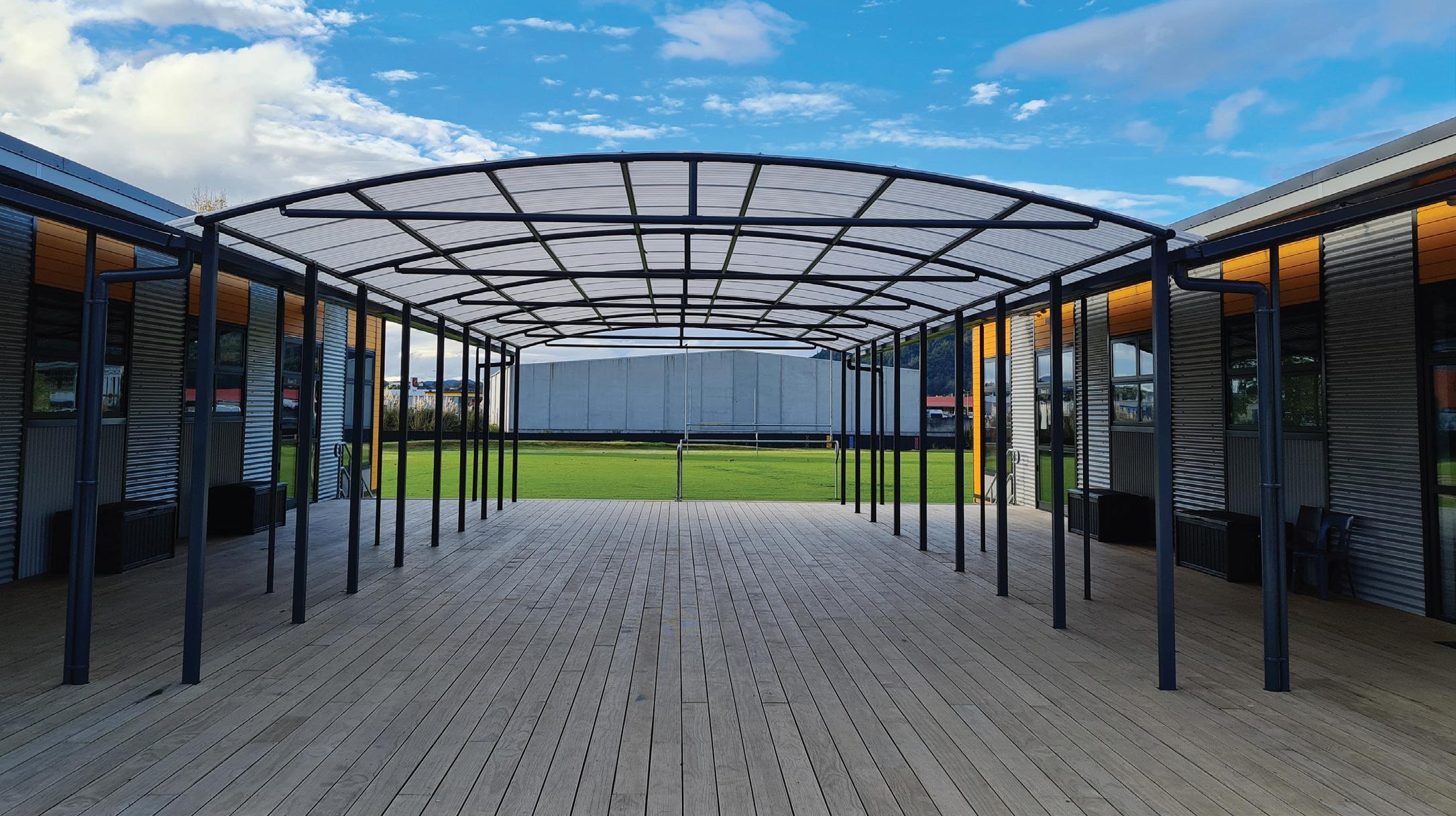
Sometimes parents aren’t sending their children because they don’t have the uniform or the shoes –even though we provide them for free. This could be because they’re embarrassed, afraid or unsure how to ask for help. Because of that, their children are missing out. I can knock on the door and give them a uniform, or even knock on the door and ask what the barriers are, but I don’t have the time to personally go in every instance.
By creating a relationship with that family and a local solution for the problem we have started solving some of these issues.
Earlier this year there was money given out to services to help with attendance. At Te Kōmanawa Rowley School we have put a lot of money into improving our attendance rates. Over the past three years, we have lifted our attendance rate from 40 to 60 percent, to currently being at 83 percent. This was done by using solutions that worked for our community. This comes at a cost, though, and funds that could have been used elsewhere have had to be diverted to this.
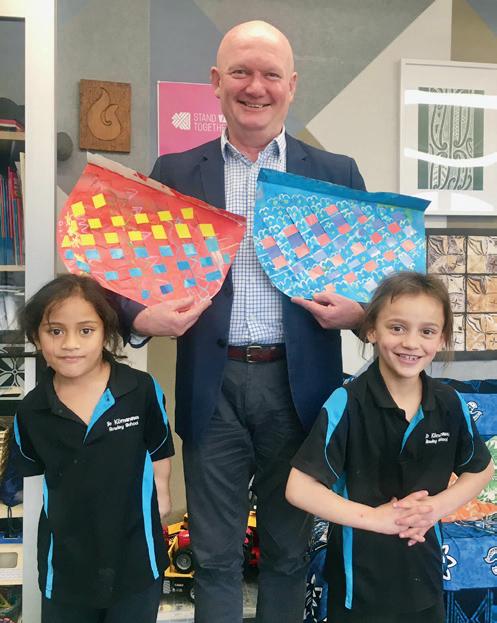



Teachers have had to spend more time making resources that could have been brought and I have had to work longer hours to catch up on my core work.
To make it equitable from one side of town to another, solutions need to be local. We spend so much time building trust with the community, and that’s important. When we go and knock on their door, they’re more likely to open it than they are to a stranger from attendance services.
We have a lot of families who have English as their second language, so communication in English can be challenging. I have people who can come along with me and interpret so the right message is getting across. To bring an interpreter, though, takes money and resources. And attendance services may not know which households need an interpreter. We know our communities and how best to serve them so give us the money to come up with local solutions. The circumstances of each whānau are different too, even among families in ostensibly similar socioeconomic brackets. In some families, parents may work night shifts, and home visits at certain times just aren’t possible. Other families may be struggling to find employment. And with each of these scenarios, there can be quite a difference in disposable income, which needs to be accounted for when finding solutions to help these families.
These are just some examples of how local principals know best where the money needs
to be invested so that it can be used wisely and effectively to come up with solutions to help with attendance.
Another area of inequity I believe needs to be addressed is that of class size. Under the current staffing model smaller schools lose out. We need to hold 25 students before we get another teacher whereas a bigger school only needs to hold on to three students before they get .1 of a teacher. For every 15 students they hold, they can employ .5 of a teacher to help take the pressure off. Currently, I have 150 students with seven teachers in their classrooms.
Our senior classes currently sit at 28 and 29 students. If I get another 5 senior students next term this will mean these classes will end up with 31 students in them each. It’s only at 175 students that I get another teacher.
It’s not equitable, particularly if I get an influx of students in one year group where the class may already be at capacity.
With the transient nature of low socioeconomic schools, classes sometimes balloon to 35 or 36. Yet we don’t get another teacher. So while there is a plan to reduce class sizes, it needs to be made equitable for all schools. The current way teachers are funded needs to be looked at and addressed to make it equitable for all. Finally, although we’re slowly adapting to Māori learners, learners from Pacific nations, and learners from all over the world, our school system is still
focused on the European model. We’re trying to make people fit into a system that wasn’t made for the context of Aotearoa New Zealand as a multicultural society. The whole curriculum, the whole education system needs to be examined and adapted to make it a New Zealand system. We need to get right away from the Eurocentric system and start again, with a system that’s fit for purpose here. Only then can it be truly equitable and accessible for everybody.
We want children at school, but

then we try and educate them in a system not fit for purpose and tell them they’ve failed when they are not meeting a standard. Would you want to be educated in a system that tells you that you’re failing because it is forcing you to fit into their way? I believe the solution lies in putting trust back into teachers. We’re the ones seeing children grow and improve. We don’t need tests, we just need to see that growth, what’s happening with each individual learner. That requires trust in our teachers to make good judgement.
To address these needs, I believe that a higher degree of trust is needed between the Ministry
and local principals. Currently, there are a lot of hoops that principals and boards must go through to secure any extra funding to meet needs as they come up. To achieve a more equitable system, we need to make it easier to access funds and resources and ensure that these funds and resources are going to the right place. For me, true equity is about responding to specific needs. That means regional-specific needs, school or kura-specific needs, community-specific needs, whānau-specific needs and individual learners’ specific needs. One shoe will not and does not fit all.


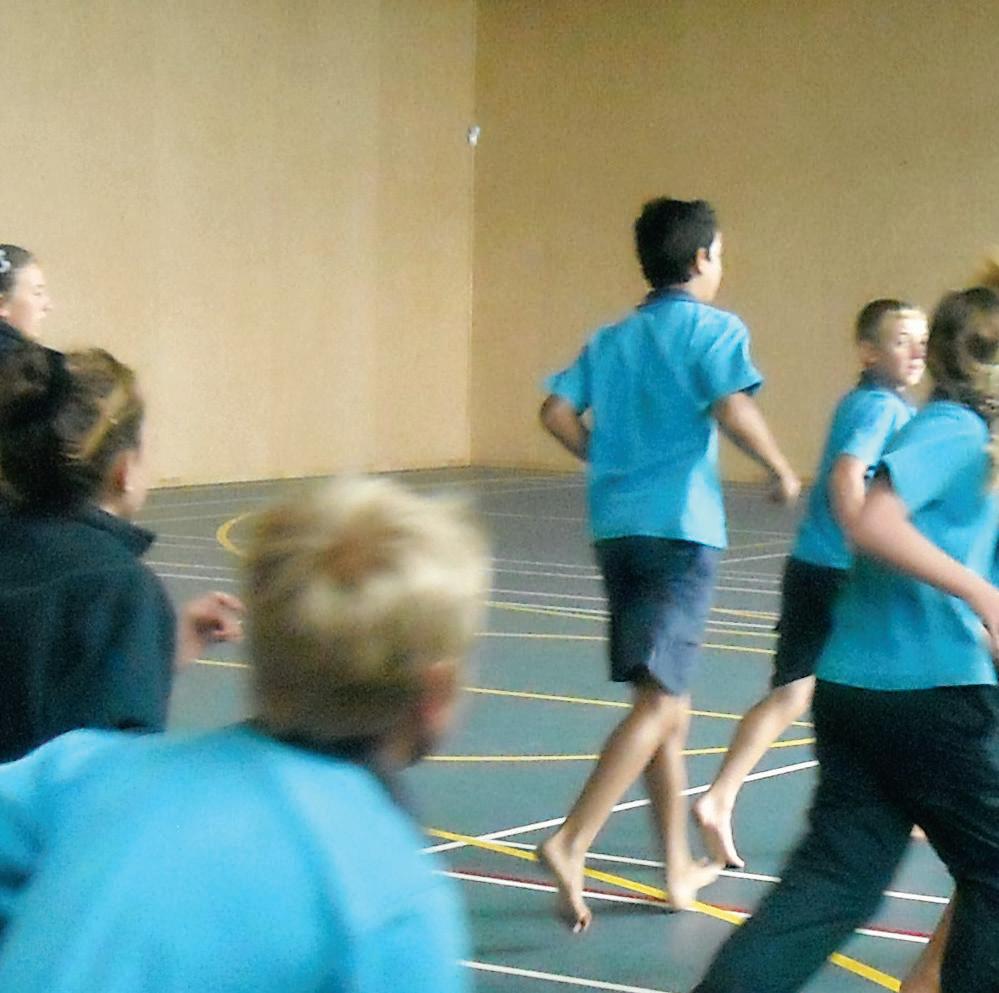


Pulastic shock absorbing sports floors reduce sports injuries and o er a high level of comfort for athletes of all ages.
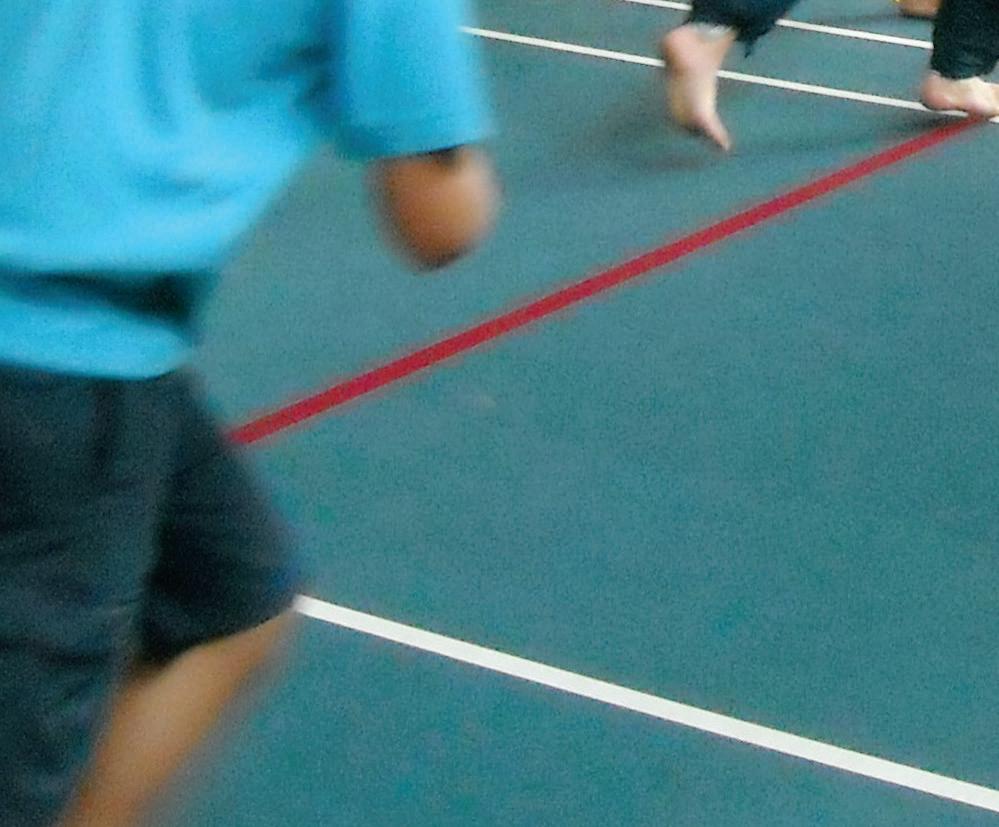
Pulastic floors are also extremely durabletheir life expectancy exceeds wooden gym floors. For more info Scan the QR Code or call Sika on 0800 745 269.





For some students, NCEA and other similar academic standards just aren’t meeting their needs. Happily, initiatives like Kamo High School’s Trades Academy are providing an engaging, rigorous, and highly acclaimed alternative.
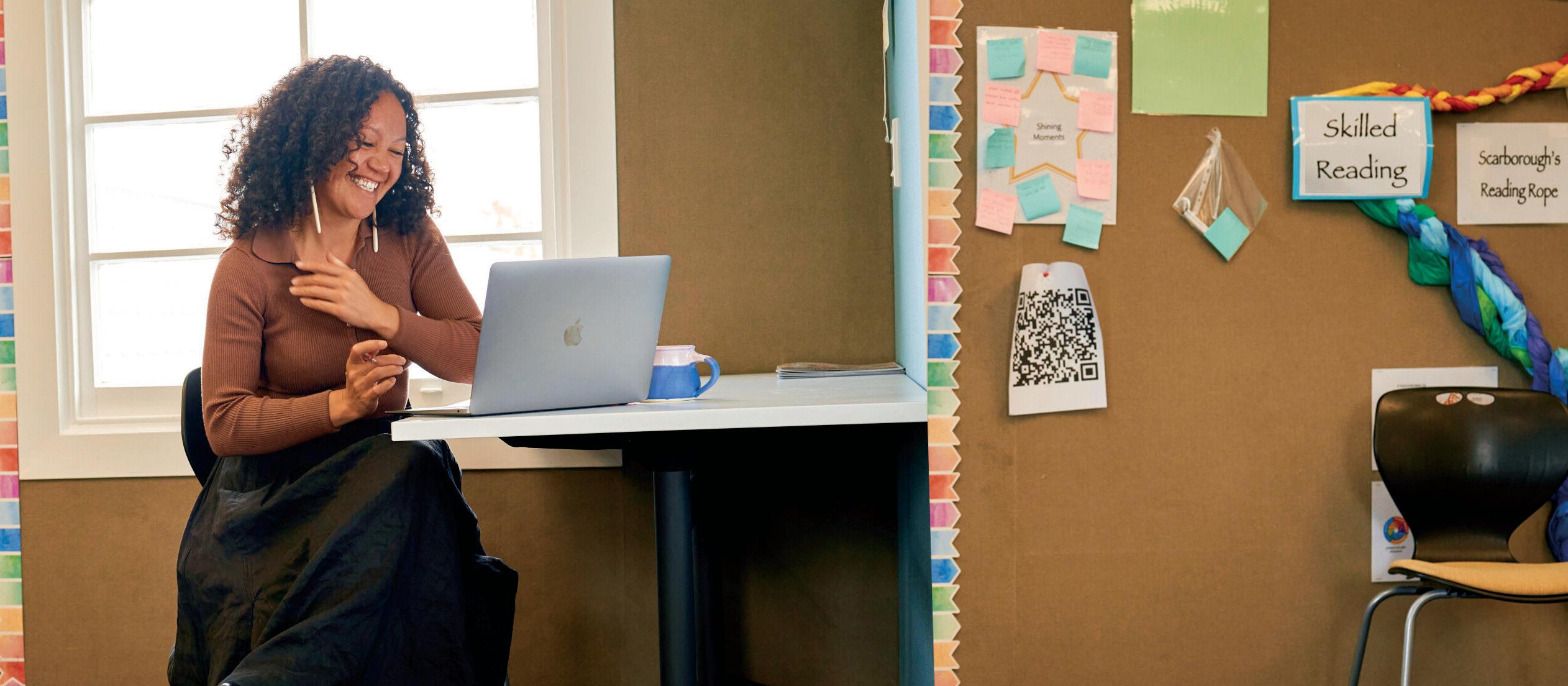
Down the back of Kamo High School or Te Kura Tuarua o Te Kamo – a mid-to-large secondary school in Whangārei – is a cheerful complex of prefabricated classrooms and a large workshop space set amidst a few plots of vegetable and herb gardens.
Once housing the agriculture programme, the space is out of the way of the main school. Walking through the grounds toward it, the crowds of teenagers begin to thin out. As you approach the side of the workshop, a brightly painted sign reading “Trades” becomes visible. As I would later learn, everything from the concrete paths to timber ramps, corrugated fencing, and wooden picnic tables around the site was evidence of the busy students at work here.
This is the site of the Kamo













High School Trades Academy. Each year, forty or so students –compared to the main school’s 700 to 800 – come to learn construction. The academy teaches using the BCITO (Building Construction Industry Training Organisation) standards at NCEA Level 2 and 3.
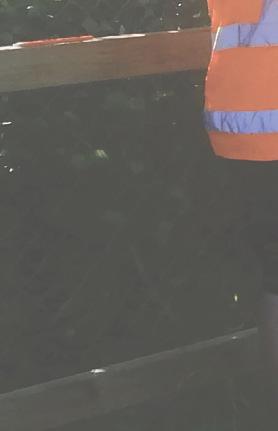
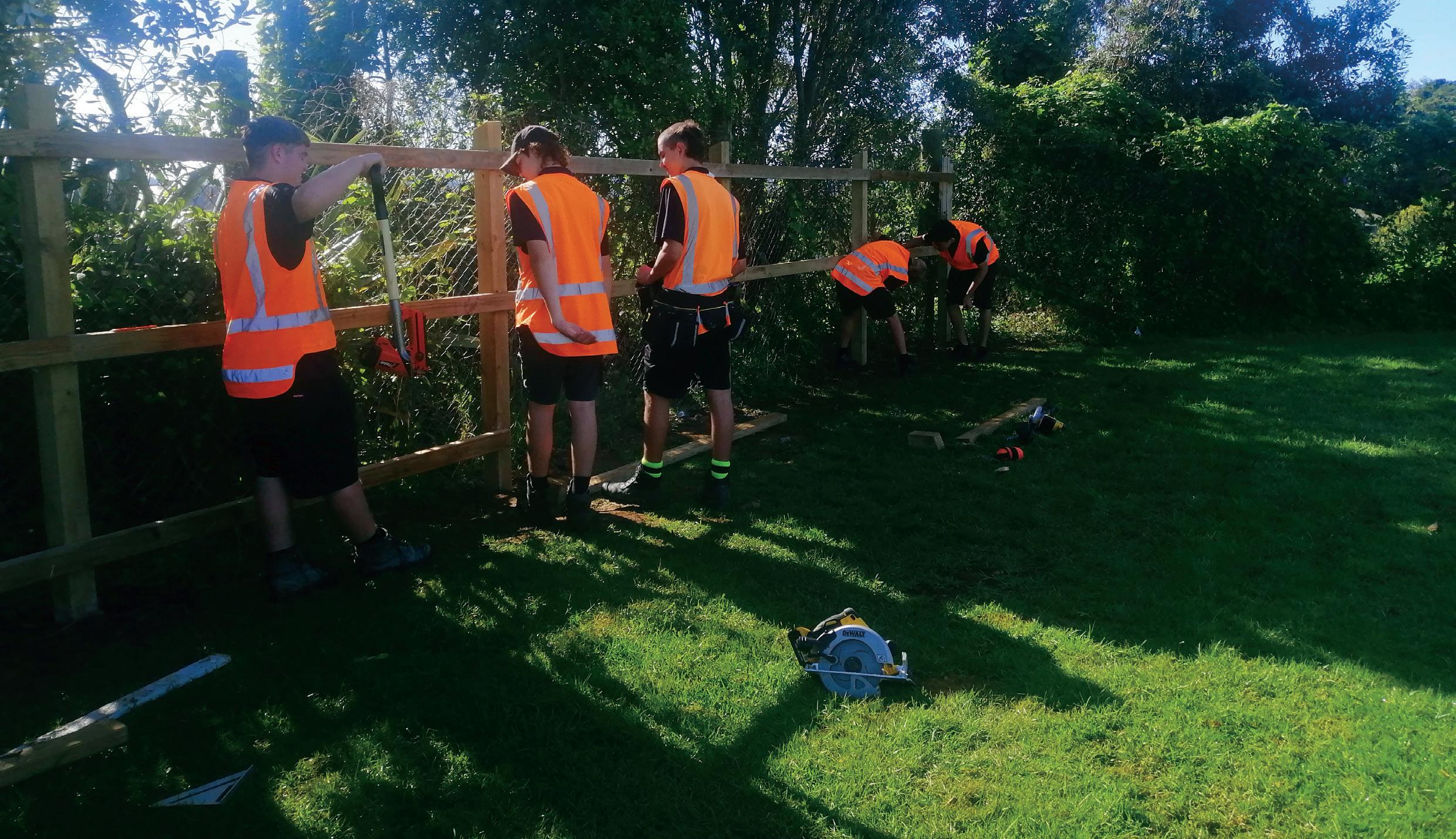
At Level 1, ākonga gain standard NCEA Literacy and Numeracy qualifications in addition to their building and construction standards. At the academy, students also gain work experience, and can participate
in externally taught courses such as Health and Safety, First Aid and Driver Licensing.
The programme at Kamo High School is part of the wider Te Tai Tokerau Trades Academy, which helps run trades programmes in many high schools around Northland. The initiative has seen widespread success, and garnered praise for providing – and raising the profile of –an alternate pathway to the traditional academic route.
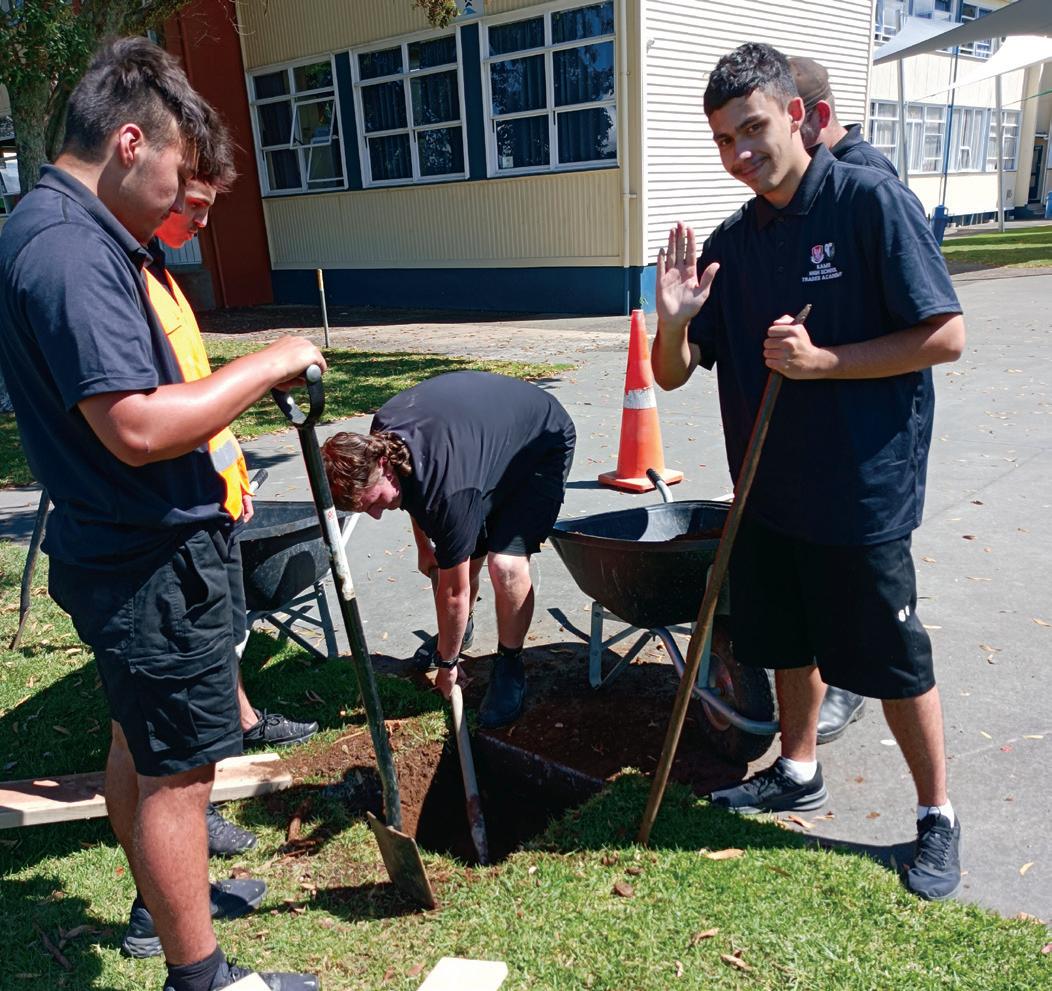
At Te Kura Tuarua o Te Kamo, the
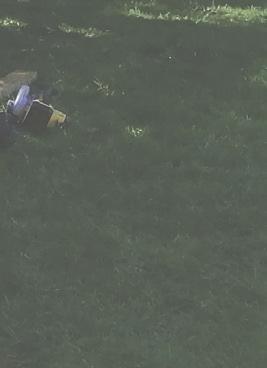
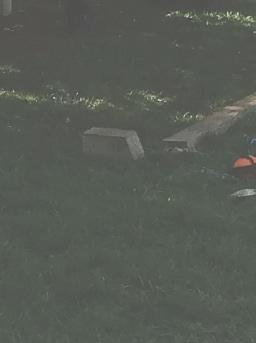


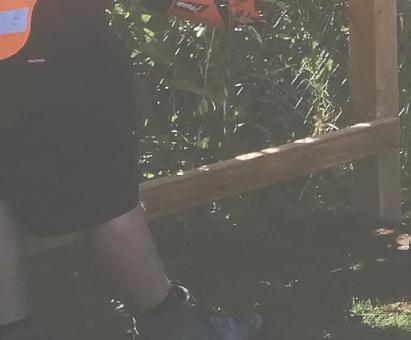
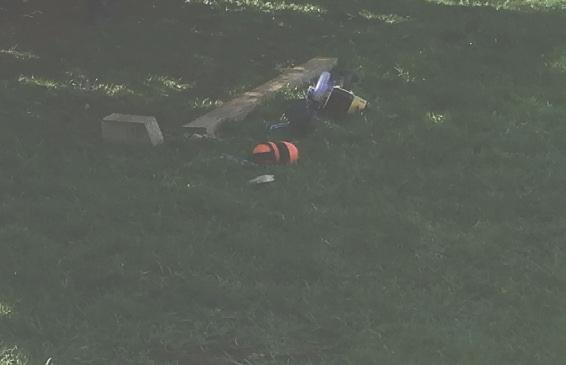


Trades Academy is facilitated by Adrian Moyle, and overseen by Janelle McKenzie, who is Head of Department. Both are passionate about the trades programme, and proud of the students and the work that comes out of it. For Moyle, who had his start in the tertiary training space, taking on the Kamo High Trades Academy programme was about building strong, confident students who could find their feet in the trades after graduation.
“Our goal is to help our students build a strong work ethic,” said Moyle. “When they leave here, the objective is that they hit the ground running. I want a place for tradesmen to come and say: ‘do you have any top students that would make excellent apprentices?’”
As Moyle leads me outside to show me the students’ current projects, it’s clear that there are more than a few excellent students in the Trades Academy. He begins with a tour of some partially constructed cabins. Everything is done by the students, Moyle explains, even running the wires and installing insulation. Of course, Moyle and other qualified tradespeople supervise and sign off on the work. During the year or on completion of the project, the cabins are sold, and the money is put into materials and costs for next year’s students.

A new suite of Initial Teacher Education (ITE) programmes demand.
“When I was a principal at an area a group of people in my community who would be excellent were already invested in the community and involved in the

whose role is to facilitate learning experiences for the mentor teachers.

Enrolments in these programmes are open now.
Graduate Diploma Education)


regionalpc@openpolytechnic.ac.nz
Graduate Diploma in Initial Teacher Education Programme Overview
Graduate Diploma in Education)



www.openpolytechnic.ac.nz
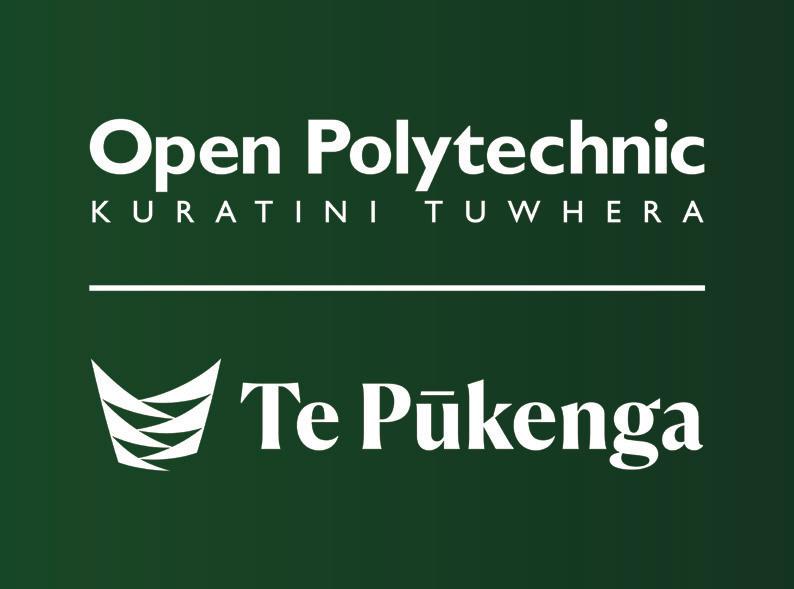
The school also receives donations such as timber, and where possible makes use of recycled components. This year, some of the cabins are using windows reclaimed from a recently demolished school. In the past, completed projects have gone to members of the community who have bid on them, and one was donated to the Railway Club at the Maunu Museum as a tearoom. The projects, then, aren’t just a way of getting students to meet the NCEA standards, they’re also a form of community service.
“That sense of giving back is something they take a lot of pride in,” said McKenzie. Beside two partially erected cabins, a group of Year 13 students are working on the flooring of a third cabin. Moyle briefly pauses to comment on their work – he suggests the group adjusts their measurements to leave a layer of air between the floor and the underfloor insulation. One female student lights up. “I told you guys!” she exclaims.
Later, Moyle notes that he believes Kamo Trades Academy can provide particular benefit to women looking to get into trades. “It’s nice to give them a start here, in an environment that can be regulated so it’s safe for them,” said Moyle.
“By and large, the female students have really benefitted. One became a builder, and that’s nice to see. Even the young men that later go on to be builders, there’s a certain glow about them,” Moyle says, taking on a glow himself.
“I didn’t have this opportunity when I was younger,” says Moyle. “If I had my time again, I’d like an opportunity like this.”
Moyle admits that he was never very good at traditional academic subjects. But when he began trades school, Moyle says that his grades went up significantly, and with that increase came a corresponding increase in self-esteem. Now, having been in the trades for
decades, Moyle wants to pass on that feeling of satisfaction and pride to his students.
“Instead of building houses, I can help build people, personalities, and abilities and skills and pass it on.”
At the school, although the subject at hand is construction, Moyle says the soft skills students learn serve them well in all manner of future careers. Although some go on to become builders, others become electricians and plumbers. Others use their skills in other fields outside of trades altogether.
Moyle himself worked as a mechanic for a period after years in the building industry,
applying the critical thinking he had learnt as a builder to the task of converting cars from right- to left-hand drives. Now, Moyle applies those principles of flexible thinking and key skills to the programme at the Trades Academy. Building and construction is particularly suited to teaching these kinds of soft skills because the industry is so varied, said Moyle.
“Every job is different. You have to think in principles rather than laws, and you’ve got to be thinking all the time and thinking ahead.”
When the students first come into the trade school in Year 11, Moyle and his colleagues start building their practical skills. That means hands-on small projects which help build muscle memory and hand-skills. In the latter half of the year, the students are introduced to power tools.
At Year 12, students begin more in-depth courses, undertaking complex projects like cabinets, decks, mixing concrete and building fences. Moyle said the aim is to apply the skills they learnt in previous years in different applications.


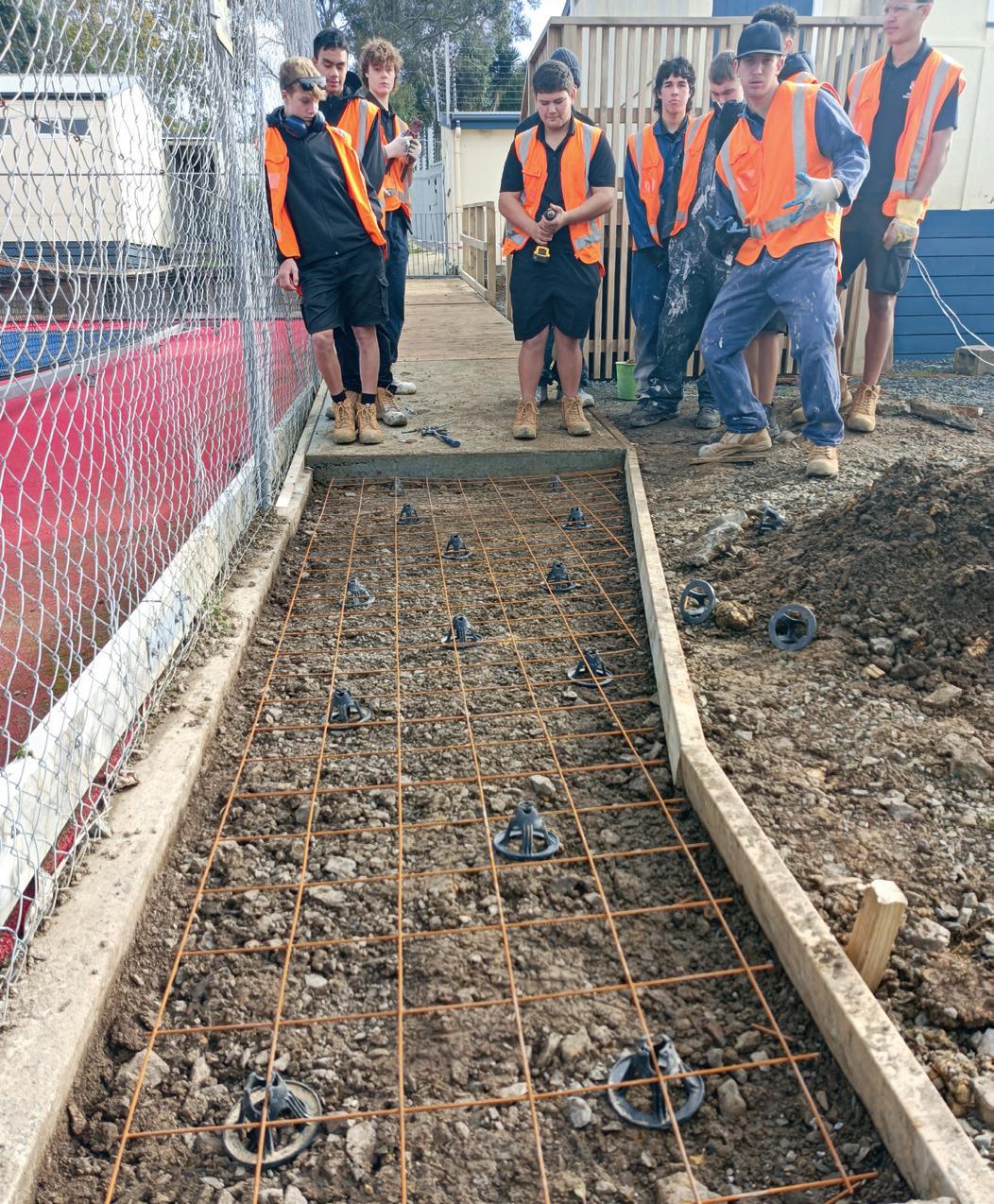
Finally, the Year 13s undertake a programme that is “like a university course,” said Moyle.
In their final year, students take on a larger project from start to finish – design, quantities, and pricing. When design issues come
If I had my time again, I’d like an opportunity like thisStudents construct a ramp to NZ national standards at the school. Students measure a planned pathway around the school buildings. All images courtesy of Kamo High School
up, students have to problem solve, record their changes and present their final project.
As evident from the design of the Year 13 course, the Trades Academy is also an academically rigorous course, though the students might not view it that way, Moyle said with a smile. Recently, a group of students constructed an accessibility ramp on the school site. That project involved mixing and pouring reinforced concrete. That requires chemical and material knowledge and an understanding of ratios, noted Moyle.
Additionally, designing the ramp to New Zealand building code meant understanding angles – building standards in New Zealand and Australia dictate accessibility ramps should have a slope of 1:14. For every metre of height, the ramp must extend 14 metres horizontally. And it’s not just math – it’s a practical application of physics theory, too. Finally, the students had to build around existing staircases, creating late additions to the project such as a platform to join the ramp to existing steps.
In the one project then, students synthesise math, physics and chemistry knowledge, as well as using logic and problem-solving skills. In the past, Moyle said that the Trades Academy was treated as a sort of “dumping ground” for students who might not succeed in mainstream school. There was an impression that the Trades Academy wasn’t academically rigorous or that it would be an “easy” year.
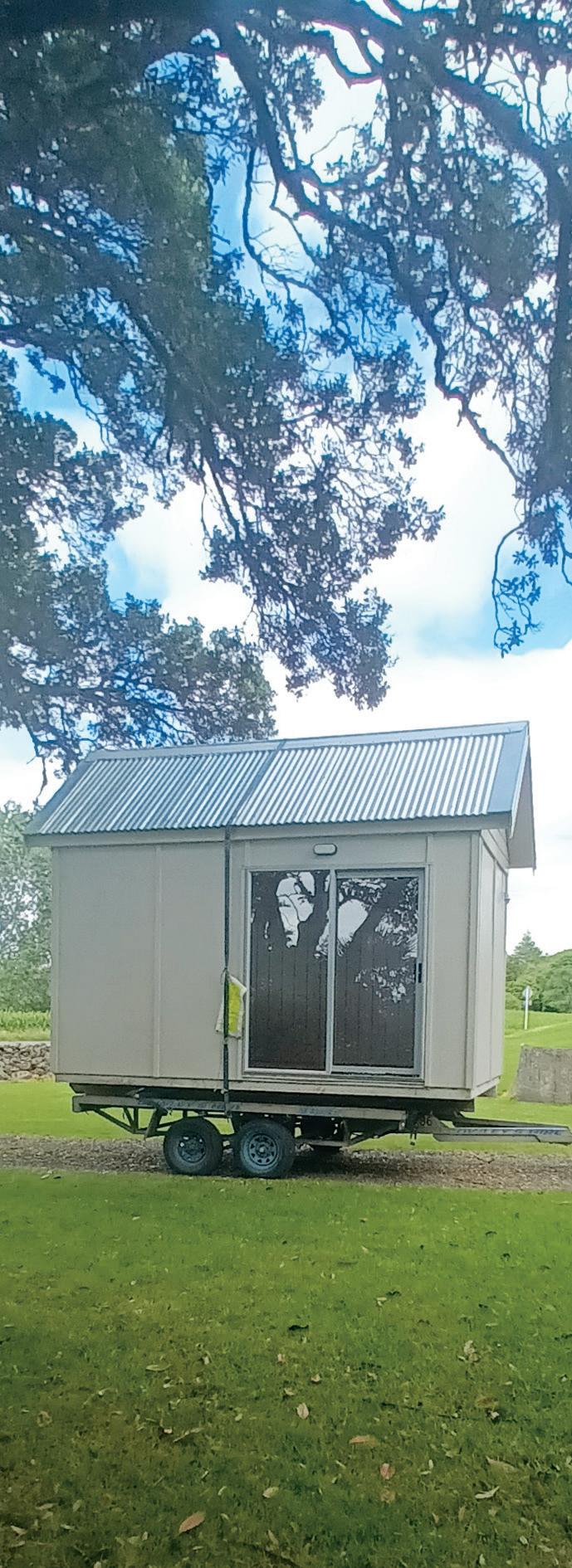
But that’s not the case at all, said Moyle. Getting into the trades school involves an application and an interview, though



WITH free ONLINE TEACHER SUPPORT
McKenzie said that students who’d like to attend on a trial basis are welcomed too. The goal is to ensure that students who come to the Trades Academy want to be there. As Moyle puts it, that “creates an environment where students can bloom.”
“A lot of the students used to think of [the Trades Academy] as a soft option,” adds McKenzie. “But it’s not. It’s work – we’re getting them ready for the big wide world out there. And by the time they leave, and they’ve done their work placements, the skills they learn are quite amazing.”
Ultimately, the teachers at Kamo High School Trades Academy want to see their students thrive and succeed. The relatively small class size and hands-on nature of the course goes some way toward achieving that goal, note McKenzie and Moyle. For McKenzie, “it’s not just the desire to get the students through the standards, it’s making connections with them and knowing who they are.
“They’re in this little environment down here which is still part of the school, but different. It’s a good place to be.”

Give your students the best advantage to excel at maths. They use our textbooks, while you have all our free online teacher support. YOUR STUDENTS DESERVE THIS!
mel@caxed.co.nz www.caxed.co.nz
CaxEd publishes the popular NZ Curriculum Mathematics –Stages numeracy series and the award-winning NZ Curriculum Mathematics – Connecting All Strands series, which weaves all the NZ Curriculum strands into one Student Text per year (Years 3-8) establishing a solid backbone for your maths programme.





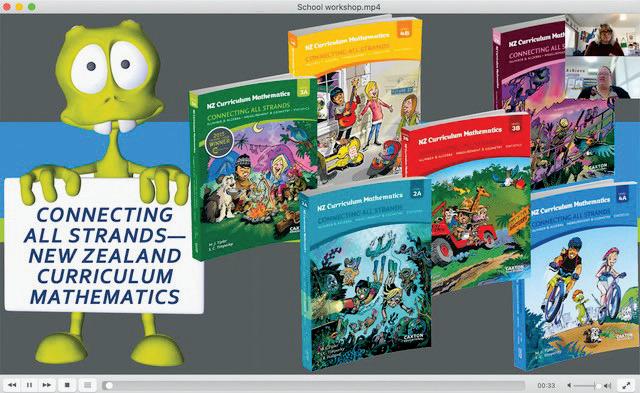
CaxEd off ers Online Teacher Support via their website to complement the Connecting All Strands texts.



Printable masters, interactive games, teaching strategies, and extra tasks for every
chapter add more excellent activities for extension or extra practice to the highquality tasks in the books.



Schools that have purchased this series can access these online resources at no cost.





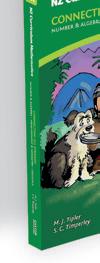







The Ministry of Education’s latest study shows that textbooks outperform computer or tablet-based learning.
Email mel@caxed.co.nz or visit www.caxed.co.nz.
Our goal is to help our students build a strong work ethicA completed Kamo Trades Academy cabin














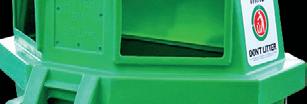
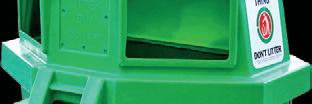
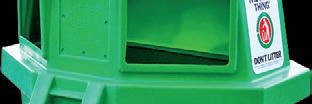
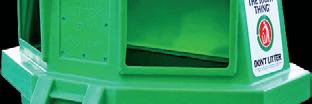








































































 By Gemma Easton, Editor
By Gemma Easton, Editor




































































































































We have all, at some point, been asked this question. Very young children may have some whimsical answers – a fairy, a king, superman. As students get older, though, it is important to equip them with the tools for finding the career that best suits them.

















































Career education can start from a young age. A first step is exposing students to examples of as many careers as possible. Early primary,
and even kindergarten students should be encouraged to believe they can become whatever they want. Stereotypes around which types of people can or usually do a job should be broken down. All children, regardless of gender, culture, circumstances or abilities should believe that they can have any job they want.

As students progress through high school, career education becomes more valuable. Exploring career options should involve consideration of what a student enjoys, what their strengths are, and what sort of commitments or

























































sacrifices they are willing to make to get the perfect job. Students should think about whether they are prepared to move away from home to undertake training or study, or if they can afford a financial outlay for essential tools and equipment necessary for their chosen career path.
A careers counsellor may be useful in helping students be aware of career options, and planning out a route to employment. You may have one in-house at your school, or seek the expertise of an outside provider. Students should be given opportunities to thoroughly explore careers in fields that interest them. The more professionals they can engage with, the more aware they can become of potential career options.

To facilitate this, your school could visit a local career fair, or consider hosting one yourself. Exhibitors
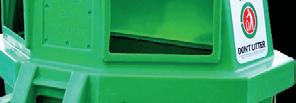










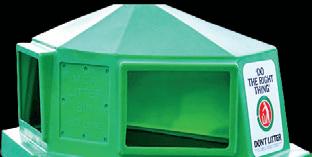

and presenters at a career fair could include representatives from local universities and training colleges, as well as industry professionals. Be sure to include a wide range of professionals, spanning all interests.


Work experience is another great way for students to gain real-world experience in their chosen field. Partnering with local businesses or higher education facilities can help students understand the pros and cons of a particular job. Beyond experiencing the job for themselves, they can also speak to professionals currently employed in that field. While traditional pathways through university or training colleges exist for many professions, students should also be aware of alternate pathways. Options like bridging courses or on the job training should be explored.

Students should believe they can become whatever they want.
Connections with the world of work allow young people to discover, explore and experience different career pathway options.
Showing relevance in what students learn in school promotes meaningful learning, facilitates knowledge of transfer, supports career and future planning, increases engagement, and improves retention of information.
A recent example of connecting student learning to the “future of learning and work” was seen at Nelson College in a Year 10 Science class.
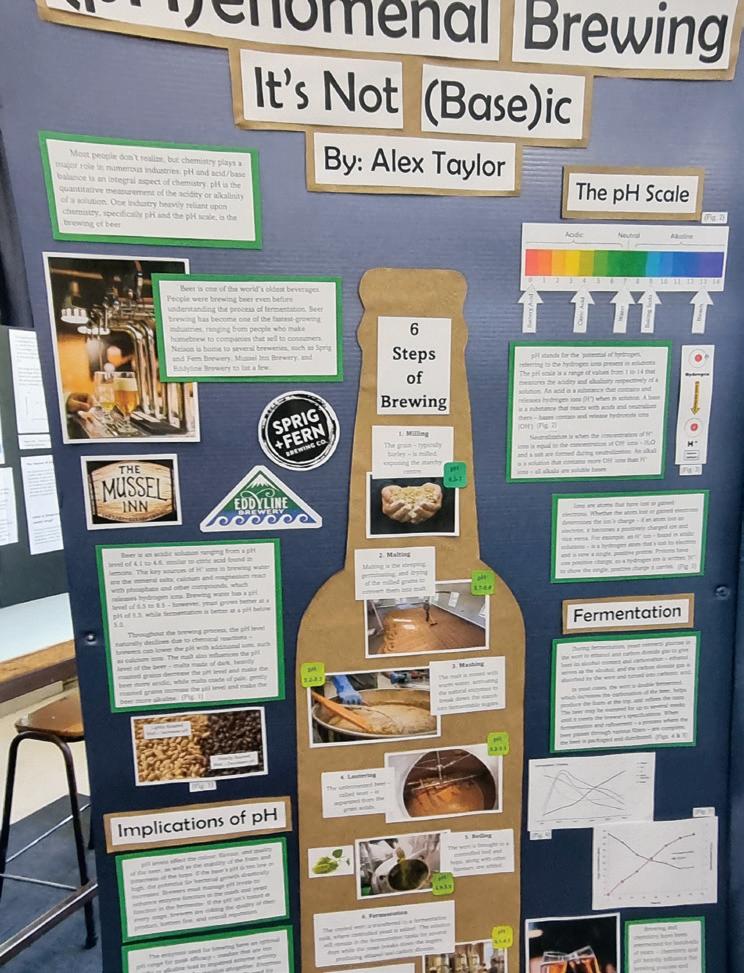

The chemistry unit chosen focused on pH, ions, acids, bases, and neutralisation. Alongside this, there was an emphasis on real-life connections and consequences of changes in pH for humans, society and/or the environment. The science teachers taught the basic concepts of acids and bases, but to bring the unit alive and to link with local employers, the following activities and tasks were included in the programme of work:-
Students were asked to rate how much they enjoyed science and how important it is for the future to have people who study science. Students were then asked to draw a picture of a scientist and to describe what they thought a scientist did in their job every day.
Students then went through an Instagram site, #scientistswhoselfie, on Twitter or Instagram. They looked at all the different types of scientists posted or real living scientists as most people cannot name living scientists, only those from history. Students identified things they learnt about the different scientists, listing the things they found unexpected or that went against their expectations.
Towards the end of the unit of work, an Inspiring Futures Event was held.
Six role models that use acid and bases in their work every day attended the event to share their stories with the students. These included a Baker, Winemaker, Water Engineer, Pharmacist, Spat Farmer and Fertiliser Consultant. They engaged with students through several activities.
The role models, wearing casual clothes, sit in a row in front of the students. Students try to guess what job they each do by asking up to 20 questions. Role models can only answer with “yes” or “no”, “sometimes” or “maybe”.
The role models then leave the room and change into their work clothes or collect a prop that represents the job they do.
Role models return to the room wearing their work clothes or holding their props.
They each reveal their job and talk for 2 to 3 minutes about how they use acids and bases in their work.
Students are separated into as many groups as there are role models. Each group visits each role model in turn. Students ask questions and learn more about their career pathways and the work they do.
Students using a local industry or everyday context of their choice, develop a conference poster presentation where they discuss and evaluate the implications and importance of acids and bases on society when used to make a product or solve a problem or issue. These were displayed in the school hall, and

students presented their findings to the Year 7 and 8 students.
The Science teachers were very invested in the programme and believed that students started to see the connection between what they were learning and what happens in the real world. Dr Deb Stuart said, “This is how I want to teach; the programme has exceeded my expectations.”
The aim of the different activities was to open young people’s eyes to different industries and career roles available in the Nelson region, where science is a part of the work they do. Students were keen to learn about the different industries and showcase their knowledge to the younger students.
Identifying and recognising the special learning needs of each student is essential to ensure all tamariki reach their potential.
Published in 2020, the Ministry of Education’s Education Counts report found that eight percent of primary school age children had a disability or different learning need, and 15 percent of intermediate or secondary school age students. Disabled learners can include students with a physical disability, as well as sensory, hearing and sight impairments, memory problems, social or behavioural problems, and different learning abilities.
As a group, students with different learning needs are half as likely to achieve NCEA Level 3 as non-disabled students, and more than twice as likely to attain no qualification at school.
The Ministry of Education requires schools to provide an inclusive education. All leaners are welcome at their local early learning centre and school, and should be supported to play, learn, participate and contribute in all aspects of life at the school.
The Education and Training Act 2020 enforces the need for inclusivity. It states: “people who have special education needs (whether because of disability or otherwise) have the same rights to enrol and receive education at state schools as people who do not”.
Increasingly, students with different learning needs are attending mainstream schools. To accommodate the diverse needs of students, adjustments to learning and teaching, classroom set up, communication, and learning environments may be required.

Classroom set up, working in peer supported groups, and adjusting learning models as needed are practical starting points for supporting students with different
educational needs. In some instances, though, specialist tools may be needed to provide the optimum learning environment. Depending on student requirements, sensory objects, aids to assist sight and hearing, and software to adapt learning programs can be implemented.

Access to specialist teachers and teacher aides is important in supporting both students and teachers. These specialists, though, may not be available in all classrooms all the time. Equipping all teachers to cater for the individual needs of their students is paramount, with ongoing professional development essential.
Want to ensure your classroom is inclusive of all learning needs?
Consider these tips from industry experts.
Sian Robinson, Special Needs Education Consultant at Sensory Sam said there are some practical measures educators can take to assist students with special learning needs.
“Students requiring additional support respond well to break out areas that are both calm and engaging. A well thought out sensory room or corner can give an over-stimulated child a chance to self-regulate, and re-set themselves in a safe environment away from their peers.
“Workspaces that are uncomplicated and allow the student to have space to work are ideal as well as taking time to consider peers that can be both encouraging and less distracted by those students.
“Sensory tools are a great way of assisting the student to engage and focus and can be a great aid to self-regulate after an event. They are also a great way to encourage social learning skills such as turn taking and negotiating, and can aid increased motor skills.”
Ms Robinson said planning is hugely important to support students with different learning needs. “Pre-set activities and workspaces that are ready to go greatly aid limited attention. Thoughtful seating plans and quiet areas that can be used by the student when overstimulated can create a more relaxed environment, especially
The diversity of students, including students with disability, those who are gifted and talented and those for whom English is an additional language or dialect, can present both extraordinary promise and potential challenges for schools.Images courtesy of Sensory Sam
when working in mainstream classrooms. Having a Kete of small, mixed sensory items on hand that the students can access, can help with focus and engagement.”
Min Roh from Phonak said the lively, dynamic nature of classrooms can prove challenging for some students.
“The typical classroom environment is often noisy, has poor acoustics, and teachers speak from a distance. The combination of these can result




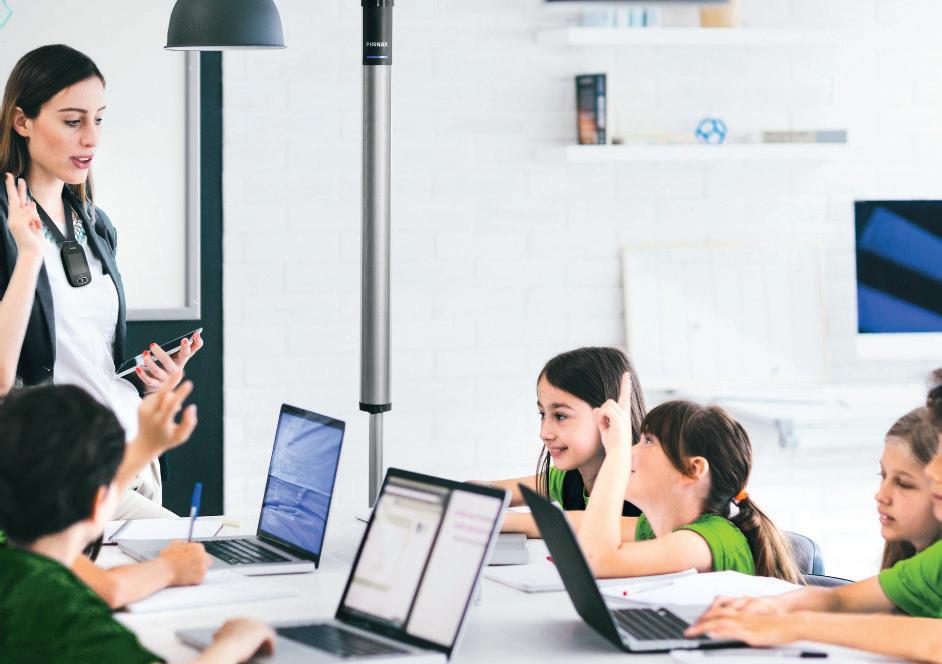
in significant hearing challenges for all children, but particularly those with hearing loss.












“We need to ensure hearing impaired children are wearing adequate and functioning amplification, for example, no flat batteries in the hearing aid or tubing not blocked with wax. Listening strategies like lip reading, providing written information and context can also be incorporated into lessons.

“Improve signal to noise ratio (SNR), by either increasing




the signal (through soundfield systems) or reducing ambient noise will also help – this helps with incidental learning from peers, and helps to reduce listening-related fatigue. Quiet rooms are better for learning than louder classrooms with amplification,” Mr Roh said. “Ambient noise can be reduced by closing windows when feasible to limit noise from outside. Introducing acoustically friendly furniture can help to improve reverberation time and reduce ambient noise.
“Better acoustics assist not only children with a sensory hearing impairment, but with other difficulties such as auditory processing disorder, autism spectrum disorder, attention deficit hyperactivity disorder, developmental delay, downs syndrome, and developmental verbal ataxia. In fact, all children, regardless of their hearing ability, will benefit from better acoustics and a higher SNR due to the auditory system not being fully developed.”
documents a position statement that outlines solutions to maximise sound quality in a classroom promoting direct (from teacher) and indirect (from peers) learning3. The overall goal is to increase signal and decrease noise; that is, to maximise SNR:
It is well accepted that children need a higher signal-to-noise ratio (SNR) than adults to hear speech in the presence of noise1, mainly due to the maturation of the auditory system as well as differences in linguistic knowledge, memory, and attention. Furthermore, children with a hearing loss require even more SNR than normal hearing peers2, which makes it even trickier for these populations to hear and understand adequate speech information.
Classrooms are a dynamic and often noisy place, and to fully participate every child needs to hear not only the teacher, but also classmates around the room. The New Zealand Audiological Society (NZAS)
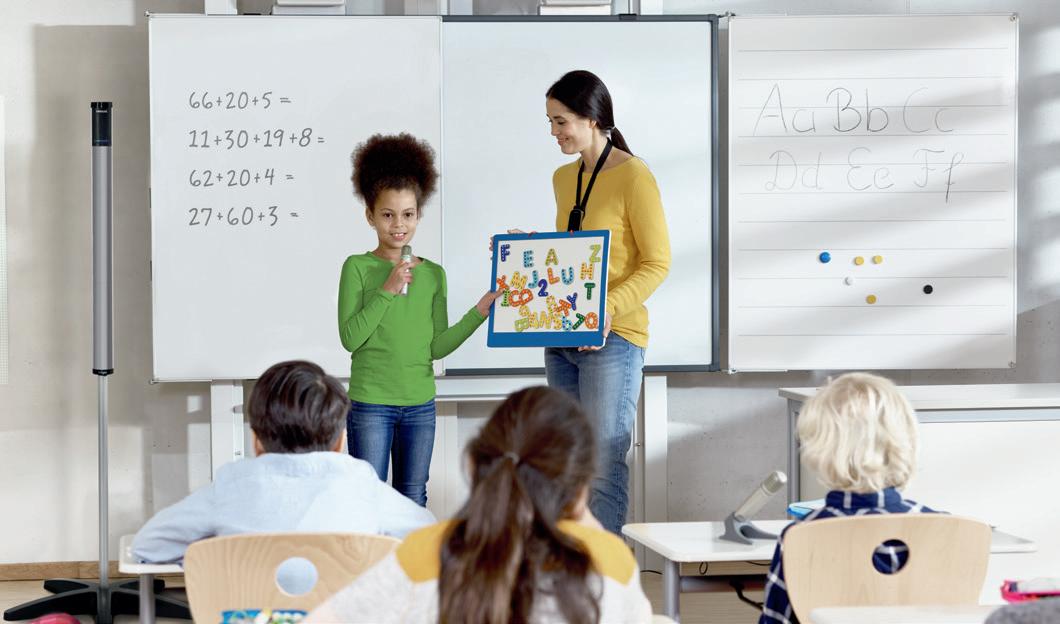
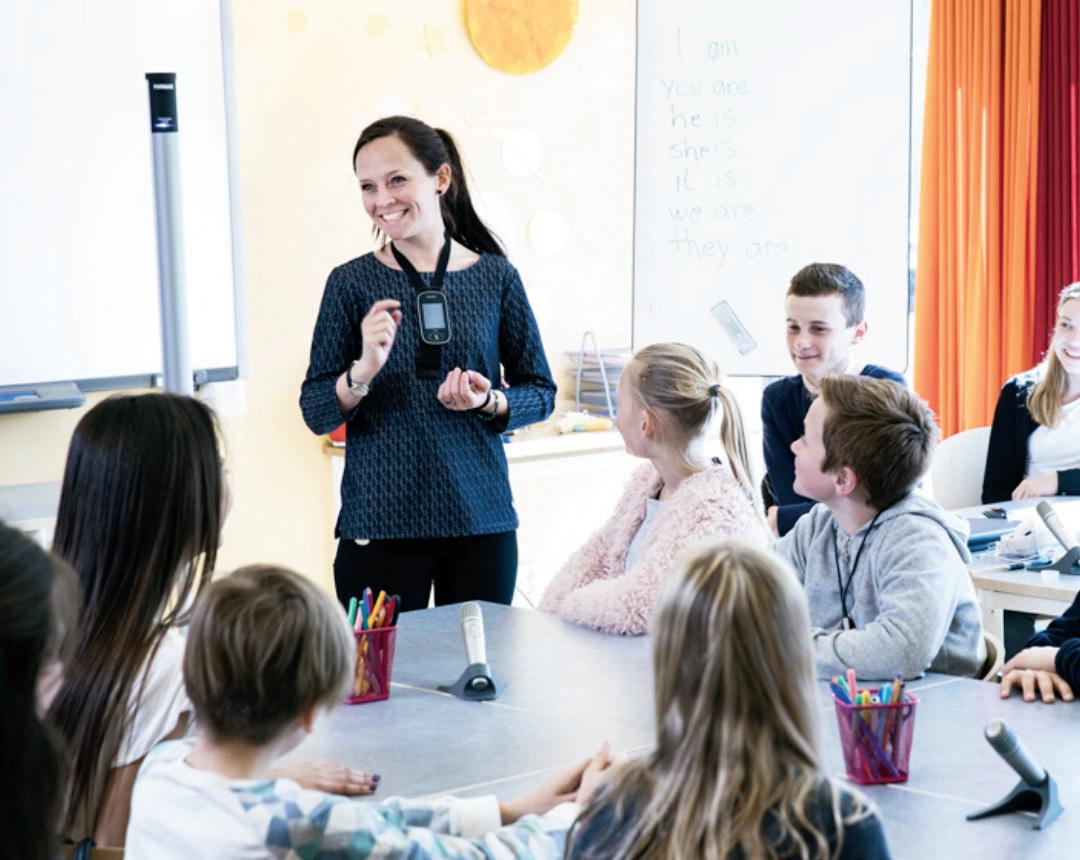
Consideration of acoustics at the design and build stages of new classrooms can have a huge impact on overall sound quality by decreasing ambient noise, reducing reverberation time, and lowering distance between the teacher’s voice and child.
For classrooms with poor acoustics, refurbishment options such as the addition of acoustic panels to absorb internal sounds and insulate external sounds (with sound insulation, or even by closing windows can help!). Alternatively, planning the activities occurring around larger learning environments in light of noise levels can help alleviate overall classroom noise.

If no refurbishments options are available, improvements in sound quality are achievable using appropriate soundfield equipment. The Roger for Education solutions are designed to address these challenges and create an optimal learning environment for everyone.
Employing a Roger ecosystem in your classroom allows:
• Better speech recognition for all students4
• Improved opportunities for learning and communication for students5
• Reduced vocal strain for teachers6
• Engagement in various classroom activities with ease
• Connectivity to any multimedia device


• Compatibility with virtually all hearing aids or cochlear implants

Roger microphones are dynamic and adaptive, meaning that the sound will be adjusted based on the ambient noise level as well as the microphone position in space, in order to provide a consistent boost in SNR,
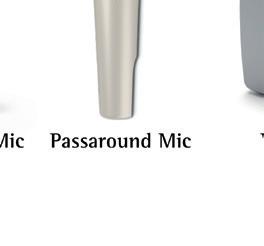

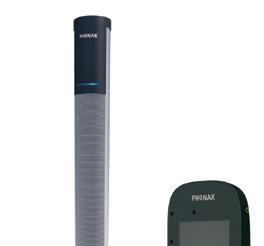
even in a significant amount of background noise. This ability to perform in the dynamic classroom environment truly puts Roger in a class of its own.
This technology greatly benefits hearing impaired children with hearing aids. In fact, all children, regardless of their hearing ability, will benefit from better acoustics and a higher SNR.
For more information regarding our Roger™ for Education, contact min.roh@phonak.com.


1 Nittrouer S & Boothroyd A (1990). Context effects in phoneme and word recognition by young children and older adults. Journal of the Acoustical Society of America, 87(6), 2705–2715.
2 Crandell CC, Smaldino JJ. Classroom Acoustics for Children With Normal Hearing and With Hearing Impairment. Lang Speech Hear Serv Sch. 2000 Oct 1;31(4):362-370
3 New Zealand Audiological Society (2019). Classroom Acoustics: Position Statement – September 2019.
4 Wolfe, J., Morais, M., Neumann, S., Schafer, E., Mülder, H., Wells., N., John, A. & Hudson, M. (2013). Evaluation of Speech Recognition with Personal FM and Classroom Audio Distribution Systems. Journal of Educational Audiology, 19, 65-79.
5 Cornwell, S. & Evans, C.J. (2001). The effects of soundfield amplification on attending behaviours. Journal of Speech-Language Pathology and Audiology, 25(3), 135–144.
6 Cruz, A. D. da, Silvério, K. C. A., Ribeiro, V. V. & Jacob, R. T. de S. (2016). Dynamic soundfield system impact on the teacher’s voice: case report. Revista CEFAC, 18(5), 1260–1270.
Hearing is a vital part of learning in the educational setting, and plays a critical role in the development of language and psychosocial skills for children. It is therefore important for all children to hear well at school for effective learning.





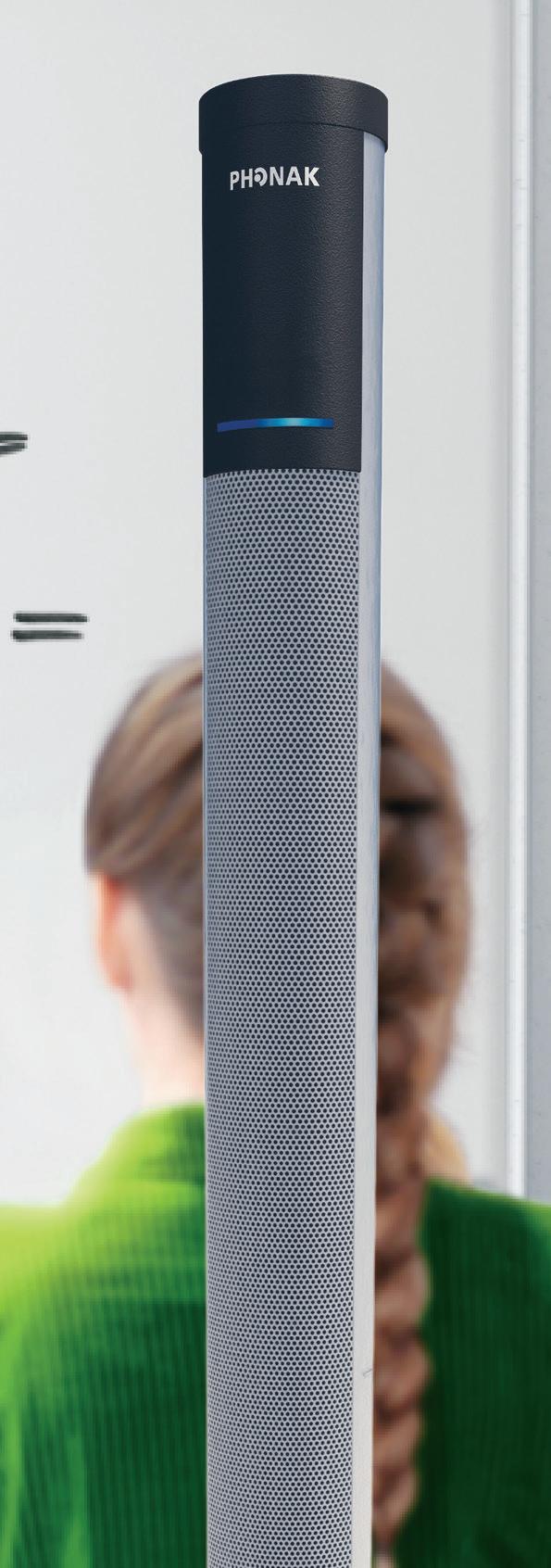



When it comes to literacy learning differences such as dyslexia, we must employ the most effective, evidence-based approach for all students across all year levels.

The approach the International Dyslexia Association identifies as one that “not only helps students with dyslexia but there is substantial evidence that it is more effective for all readers” is Structured Literacy. Where this practice has been normalised in the schools we work with, we are observing increased benefits for students with literacy learning differences.
I like to quote Bill Hansberry when he says, “Teach them all as if they’re dyslexic and you teach them better”. Rather than
exclusively targeting students with dyslexia, teaching the most effective approach to all students ensures that everyone benefits from evidence-based strategies, and everyone is included.

Consistency is key to feeling like you belong both in and out of the classroom. To create a fully inclusive environment, it is essential to implement intervention support that aligns with the instructional approach taught in the classroom. We also know learning doesn’t happen in one exposure and this consistent approach enables teachers to provide opportunities for retrieval and recall of what has been taught.
Educators play a vital role in supporting students with literacy learning differences. When we match our instruction to what the science says about how the brain learns to read, we will enable literacy success for students. As Louisa Moats stated, “Informed teachers are our best insurance against reading failure. While programs are very helpful tools, programs don’t teach; teachers do”. Equipping educators with knowledge and skills to effectively teach students with dyslexia enables them to adapt instruction and meet diverse needs. We can gamify it, make it social, and storify it while teaching consistently to ensure an evidence-based educational pathway is in place.
Implementing a Structured Literacy approach fosters inclusion for students with dyslexia. With evidence-based strategies and explicit instruction, this approach provides a systematic framework for reading and writing skill development. This inclusive approach ensures that students with dyslexia
are engaged and empowered in the learning process.
When looking at implementing this approach for inclusive literacy education, several key elements are needed:
• Ongoing professional development and training for educators to stay updated on best practices in supporting students with literacy learning differences such as dyslexia.
• Adequate resources and support for effective implementation of Structured Literacy, ensuring accessibility of teaching materials across tiers.
• A consistent lesson sequence, scaffolded teaching based on student needs, and alignment between intervention (Tier 2 and 3) and Tier 1 instruction.
• Encouraging collaborative efforts among educators, school leaders, and stakeholders for a wholeschool approach to inclusive literacy education.
• Establishing clear expectations for teaching time and well-planned roadmaps to prioritise instructional sessions.
• Developing a comprehensive framework for assessment and progress monitoring to guide instructional decisions and targeted interventions.
Ensuring inclusive literacy education requires a multifaceted approach that addresses the needs of every learner, including those with dyslexia. By teaching the most effective instructional approach to all students, aligning intervention with classroom instruction, providing teacher education, and implementing the necessary elements for success, we can create inclusive learning environments where all students can thrive and feel empowered in their literacy journey.
Ensuring every child receives the necessary support to develop the foundational literacy skills to access their learning can be a complex endeavour, particularly when addressing diverse needs.







































Win 1 of 6 Prize Packs Worth Over $850 Each*










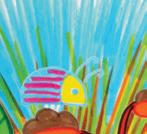


ADD STAEDTLER PRODUCTS TO YOUR BACK TO SCHOOL YEAR PACK LISTS FOR 2023-2024 FOR THE CHANCE TO WIN ONE OF SIX PRIZE PACKS


























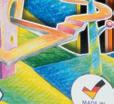






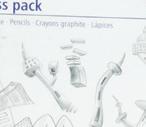



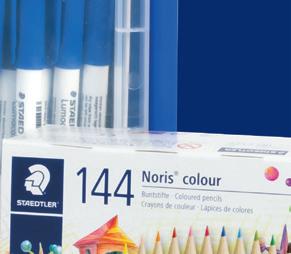





























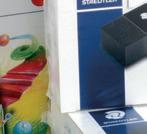






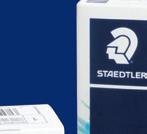



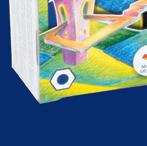



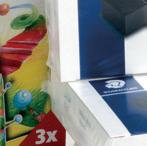





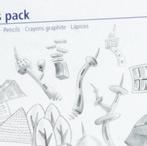



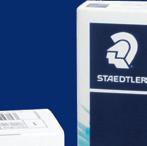


















To be in to win one of these awesome prize packs, simply look through the STAEDTLER Back to School catalogue and add any suitable products for your class year to your schools 2023-24 Back to School pack lists.


Please ensure STAEDTLER is mentioned against the product when adding OR if there are STAEDTLER products already on your Back to School pack lists please make sure that the word STAEDTLER is mentioned beside them.






























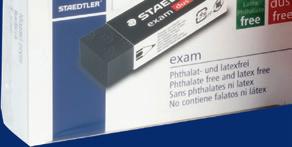

























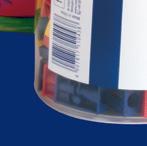
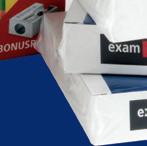
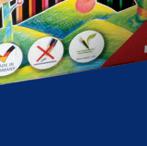

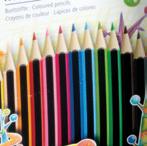







For every STAEDTLER product mentioned (Per school year) your school will receive 1 entry into the draw. I.e., 4 products listed = 4 entries. Scan and send all your Back to School year pack lists to d.dawson@multimediapublishing.co.nz




Please include the school name, your name, position and telephone number.













Entries open from 3rd April and close 31st August 2023. No restrictions to the number of entries permitted, remember the more STAEDTLER products added, the more entries you’ll receive. For full T&Cs please email write.nz@staedtler.com



The prizes will be drawn on the 2nd of October and winning schools will be contacted by School News








Please note by entering this competition you will give permission for School News to share your details with STAEDTLER (NZ) Ltd, who will use for internal purposes only and will not share with 3rd parties.



It all started with a simple question. Could a well-designed ergonomic chair enhance concentration and learning in the classroom?
We visited classrooms throughout New Zealand, measured 20,000 students and studied their behaviours in classrooms. By the end of that extensive research, we found that most school chairs inhibited movement and restricted blood flow, resulting in unproductive fidgeting and off-task time.
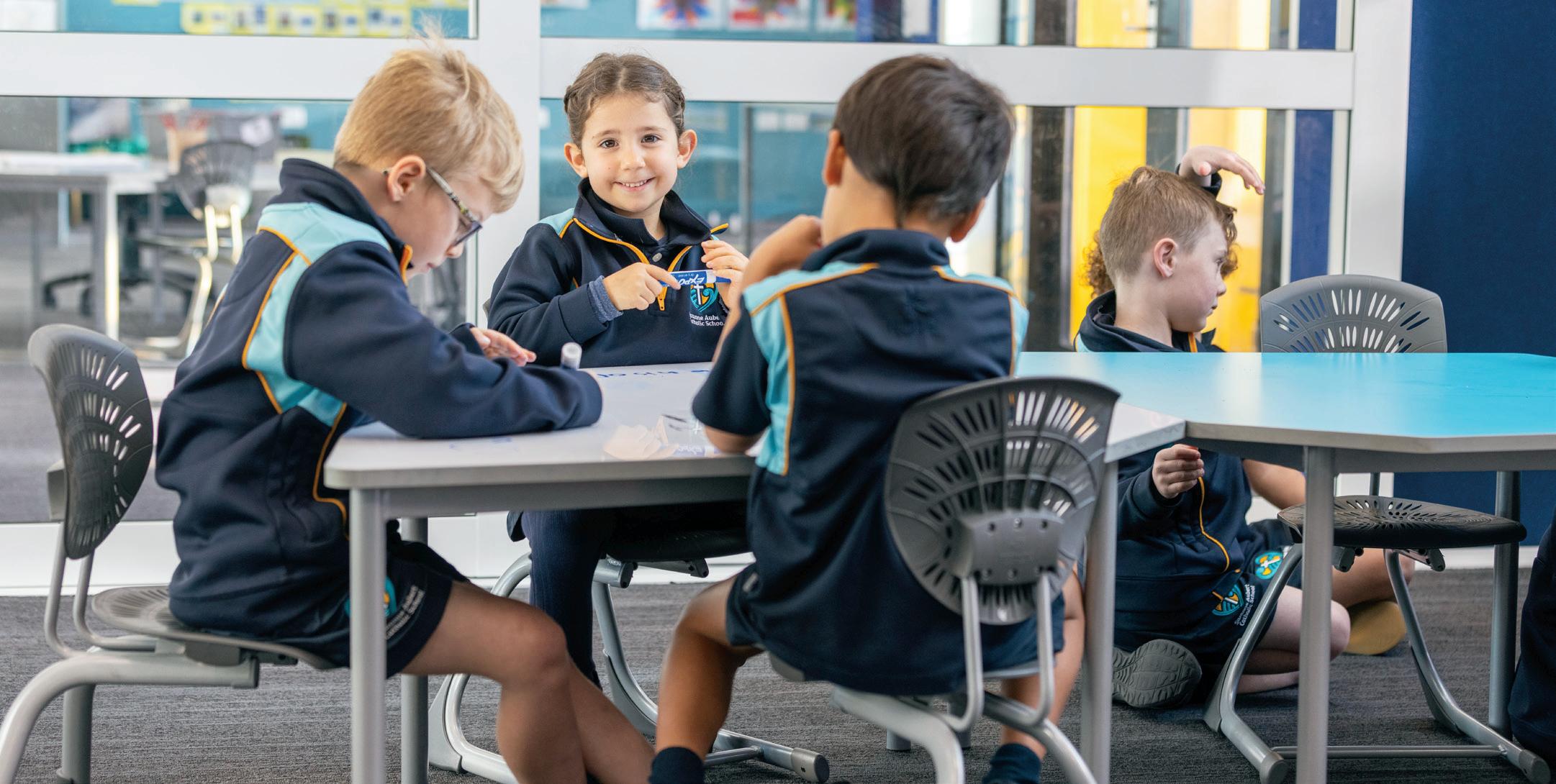
If students are not comfortable, they struggle to concentrate, fidget, and lose focus. We believed the right chair can make a world of difference!
It was time to design a school chair that offered students the best chance to concentrate, with maximum ergonomic comfort. Through years of research, development and design, the revolutionary Bodyfurn® system was born. The world’s first dynamic seating solution that offered right support without restricting circulation, keeping students comfortable.

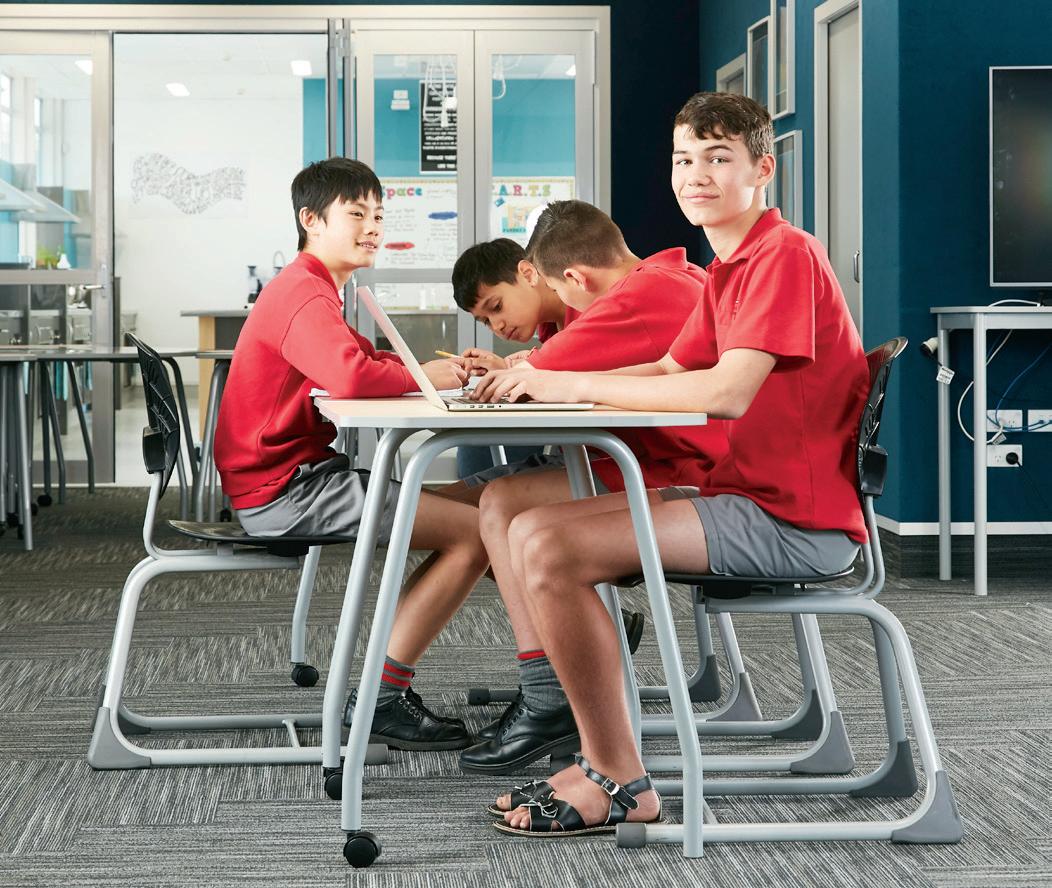
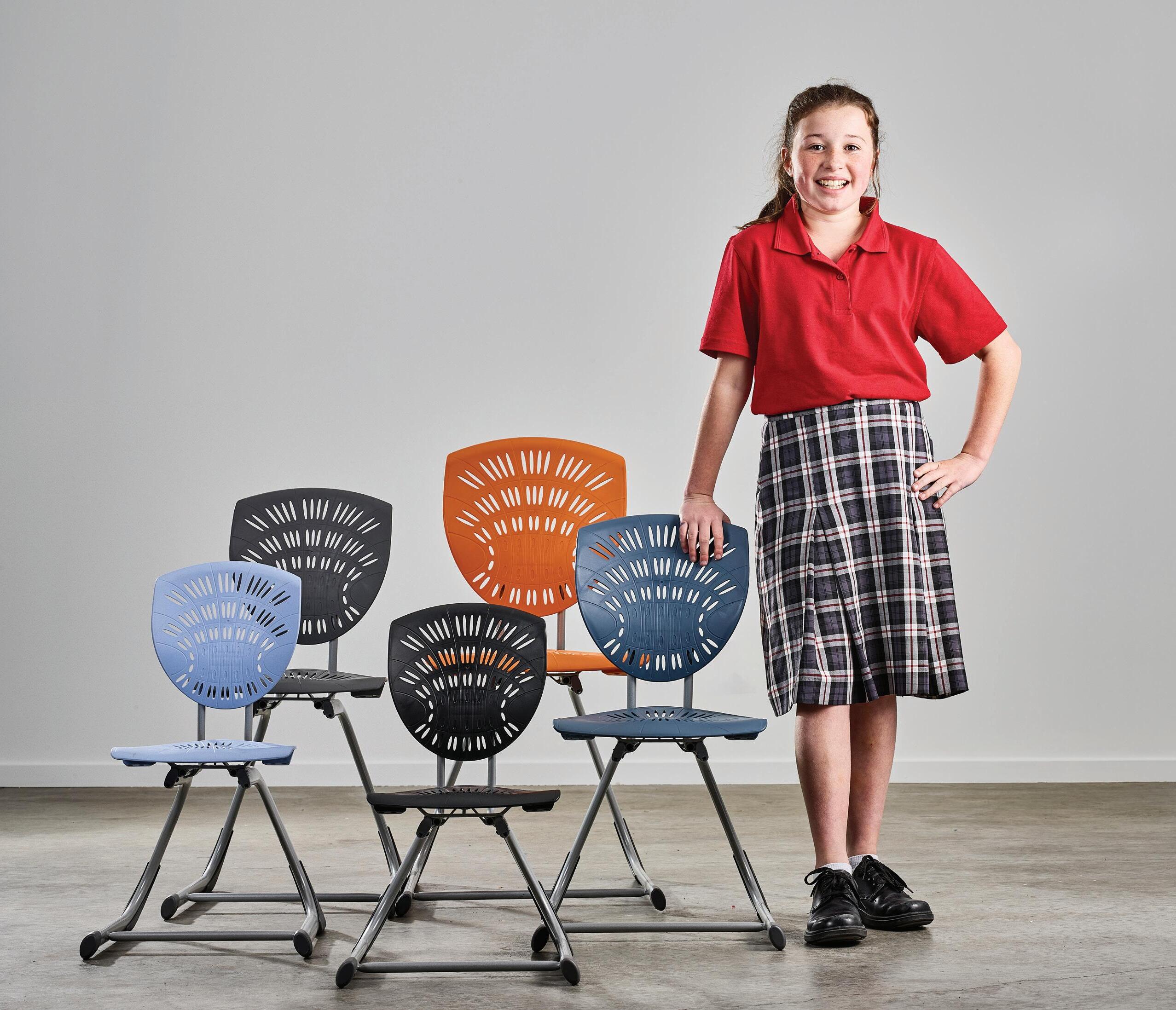
The health benefits of Bodyfurn® extend beyond ergonomic comfort for its user. Today, over a million Bodyfurn® Sled Chairs are in schools around the globe making a world of difference to students. We asked principals, teachers and business managers why they’ve made such a difference in their schools.
“From our research, between 75-80% of off-task time was actually reduced as a result of the furniture.”

“If you gave the students a choice between Bodyfurn® and a traditional chair, there’s just no competition.”– Neil O’Reilly, Former Principal, Kowloon Junior School, Hong Kong. – John Chalvatzis, Dean of Students Ipswich Grammar School, Queensland
can make a world of difference!
learn more



The health benefits of Bodyfurn® extend beyond ergonomic comfort for its user. Today, over a million Bodyfurn® Sled Chairs are in schools around the globe making a world of difference to students.






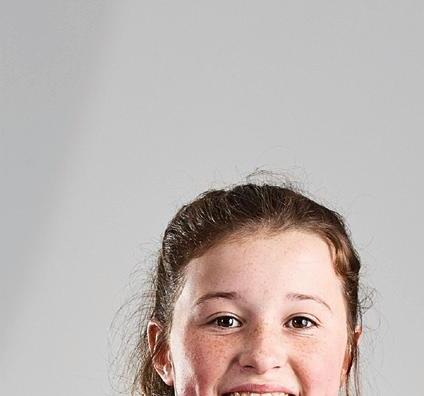















Increasingly, seating design is being recognised for its potential to boost learning engagement.

Flexible seating is an emerging trend, and is a movement away from the traditional desk-and-seat arrangement which faces the teacher.
In some classrooms, this can mean diff ering zones, defined by seating options including beanbags, couches, floorcushions or therapy balls.
Some options have proven benefi ts to student concentration and engagement, particularly for neurodiverse students or students with disability. For example, students with ADHD benefi t from the increased movement of therapy
balls or wobble stools. Seating with this type of movement also benefi ts students who have a “kinaesthetic learning” style.
Seating options in a diverse classroom arrangement mean students can choose whatever type of seating may help them stay on task. In one small scale study from the American midWest, a teacher conducted a mixed-methods inquiry into student and teacher perception
of flexible seating. Findings showed that students will selfselect which zones enable the best performance and focus depending on the task. Having, the study’s author, noted that of the various options, some students would prefer certain options for certain subjects. However, she also noted that some students would always choose the traditional desk and seat option were they available.
Sett ing up flexible seating in the class may also provide other benefi ts in line with the principles of the New Zealand curriculum. Students may feel more agency and choice over their learning when provided with flexible seating options. Additionally, for tamariki who need lots of movement, flexible seating means short, built in “brain breaks” when switching between tasks.
However, teachers should also be mindful of some drawbacks to new seating designs. Another study, which surveyed teacher perceptions of flexible seating, found that teachers recommended introducing flexible seating slowly, and making expectations clear. Without guidelines, students could be prone to misusing the flexible furniture. With appropriate supervision, though, flexible seating did not seem to impact students’ on- and off-task behaviour negatively. Additionally, teachers noted that each class is diff erent, meaning diff erent flexible seating options may be needed for each cohort.
But this kind of flexible seating may not be feasible for every classroom. Versatile forms of seating that may mimic the flexible classroom setup, though, can be used.
Flexible seating is an emerging trend
For example, stools are a popular choice for science and computer labs, technological subjects and more. They can come in an adjustable height design, all diff erent colours and with flexible bases.
For large communal spaces such as gyms and auditoriums, there are a variety of seating options available to maximise space. Bleachers and other kinds of moveable or stackable seating can be utilised so that spaces can be converted for any occasion: performance, sports-games, assemblies, and prize-givings. To find out more about the latest trends in seating, we spoke to some industry insiders
Michael Hellyer from Sebel said that modular furniture is important in designing a classroom layout, as it allows educators to create sett ings for all ages.

“Ensure that the products selected are fun, flexible, and comfortable. When picking the right seating for classrooms, schools generally opt for
easy to move, lightweight and stackable chairs. This allows for the classroom to be altered easily based on the learning mode being used.
“Flexible furniture in the classroom can include modular seating that can be configured in a multitude of ways, with castors which make creating new spaces within minutes easy for both students and teachers,” Mr Hellyer said.
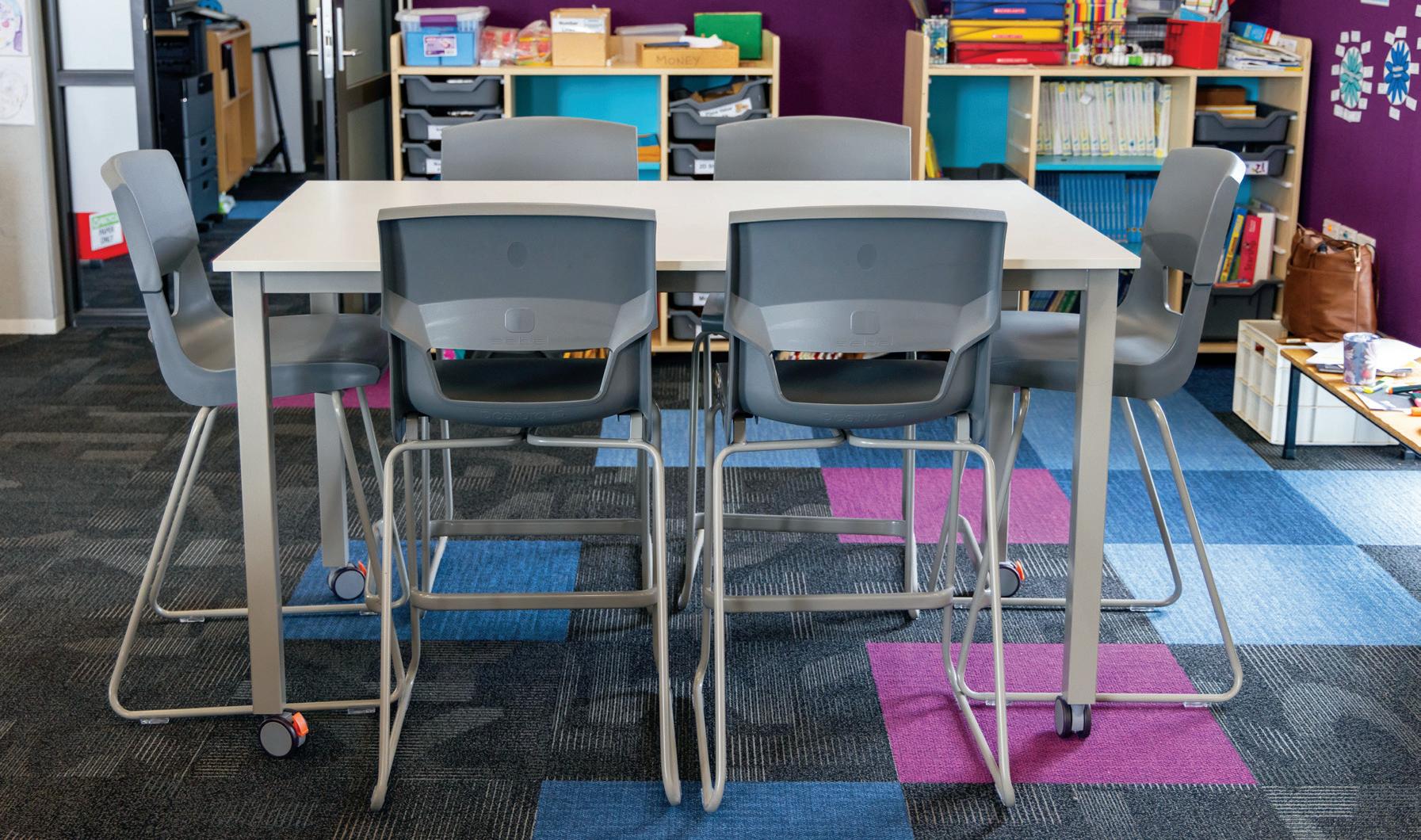

“We’re seeing schools opt for darker colours when it comes to selecting colourways for their seating. This is because they are easier to keep clean. There is also a trend toward furniture that is environmentally friendly.
“Active seats that allow students to rock and move easily in diff erent directions are a great tool to make the learning environment fun and are a perfect option to
help keep active children focused on learning.
“Round seating pads and large square cushions are great floor seating options for breakout spaces, reading zones or relaxation time. Sitto-stand solutions are ideal for collaborative work around benches for learning spaces like science labs, food tech rooms, STEAM rooms and art rooms.”
Check out our FULL RANGE 09 523 4092
T M
Helen Jones from Furnware advises that for focussed work and extended periods of sitt ing, a good ergonomic student chair that fi ts students correctly is important. “For more casual, collaborative learning soft furniture items such as couches or ottomans are a great addition, either positioned around a central table or booth style. For maximum flexibility
and future proofing, modular designs with larger items on castors ensure sett ings can be reconfigured as required. “Tiered seating continues to be a prevalent feature in modern learning spaces, achieved by adding high tables and stools into spaces. This varied approach to seating height creates interest, making
a space more dynamic and providing good line of sight for both students and educators.

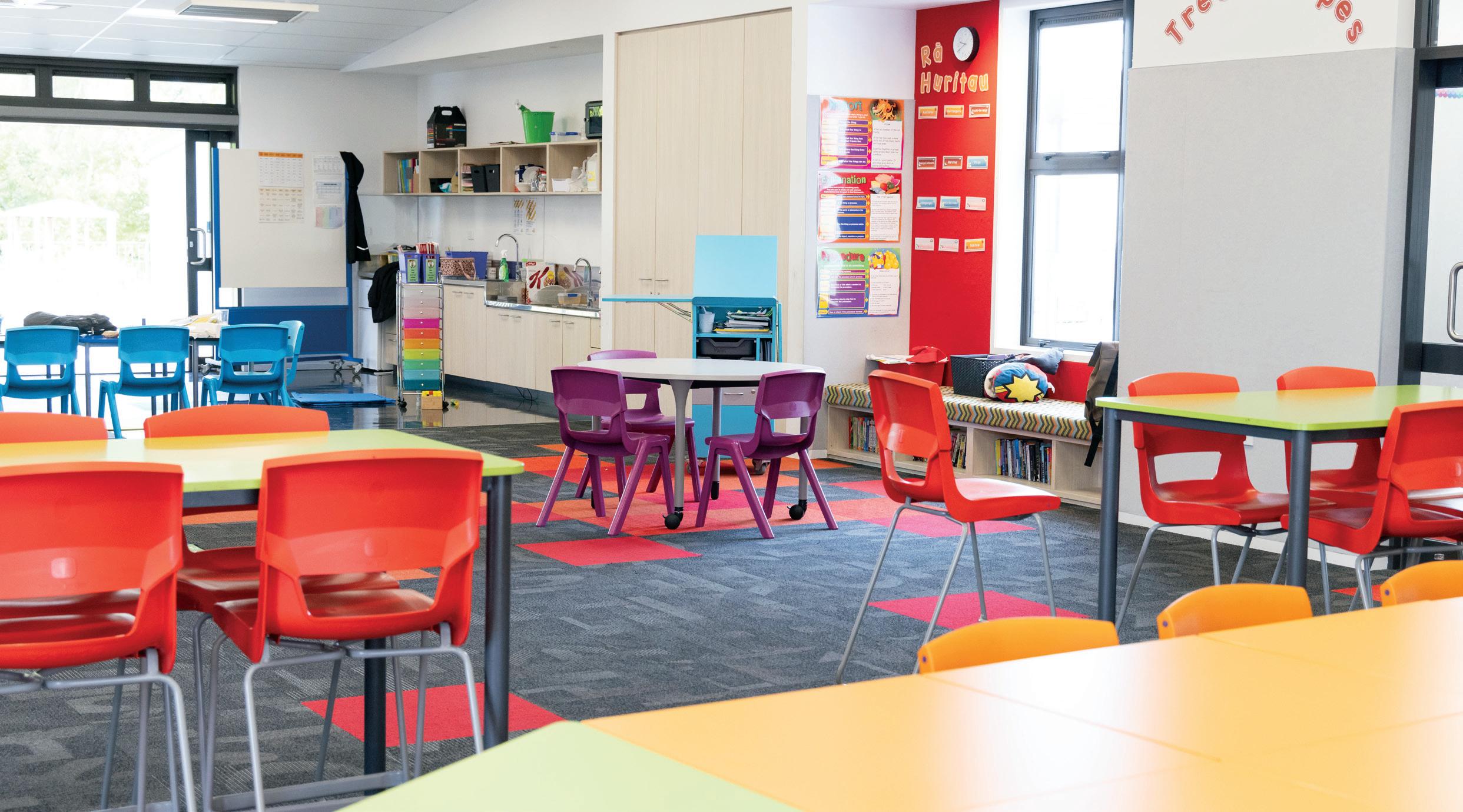
“For younger students, bean bags are a great casual option for individual reading or quiet time, although it pays to check the filling is not too noisy as this can create distraction. Shaped upholstered items also continue to be popular,
adding an element of fun and increased postural support to low seating. Floor cushions allow younger students to move seating to the activity or to a space where they feel safe and ready to learn. Floor cushions also work well when combined with low kneeling tables as an aff ordable solution for collaborative learning for younger students.”
In
Schools in Australia face unique challenges when it comes to ensuring the safety and security of their students, staff, and valuable assets. Upgrading to smart electronic access control systems can significantly improve security, but the upfront expenses can be a concern. This article explores budget-friendly strategies for implementing access control upgrades while maximising the impact on school security.
To overcome the apprehension associated with implementing a new access control system, schools can conduct a no-risk trial. By installing electronic locks

in a high-traffic area, such as the main administrative building, administrators can assess the system’s suitability, ease of use, and compatibility with existing infrastructure. This hands-on experience helps evaluate its effectiveness in meeting the school’s specific needs.
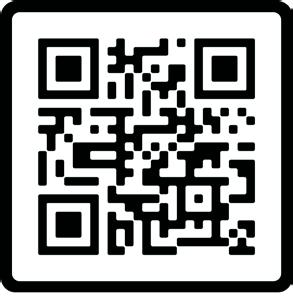
Budget constraints need not prevent schools from enhancing security. A phased approach can be adopted, starting with high-traffic areas like main entrances, administrative offices, and critical facilities. This incremental implementation allows schools to improve security in a cost-effective manner.
Modern access control technologies offer scalability, ensuring the system can grow alongside the school’s budget. As
the budget expands, additional access points, features, and accommodations for a growing student population can be integrated into the existing access control system.
When security concerns or personnel changes necessitate re-keying locks, consider reallocating those funds into smart access control because it provides superior security, convenience, and traceability, eliminating the need for physical keys and their associated risks.
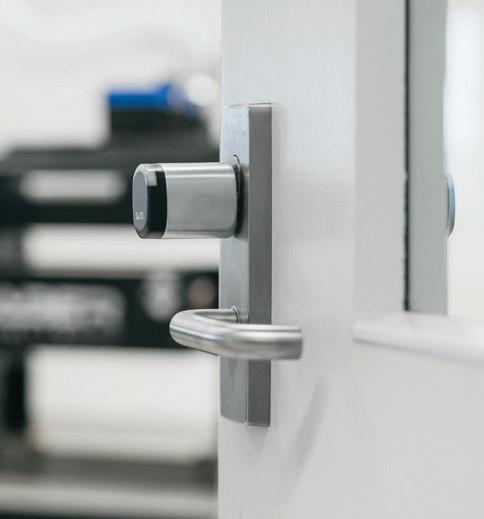



Depending on a school’s policies and circumstances, it may be possible to utilise insurance funds for access control upgrades. By contacting the insurance provider, schools can explore
redirecting funds to invest in a robust system that significantly enhances school security.
Enhancing the access control system in schools is not only a matter of convenience but also a crucial investment in the safety and well-being of the entire school community. By employing strategies such as no-risk trials, gradual implementation, scalability, and re-keying fund reallocation, schools can overcome budgetary concerns and ensure effective security measures. Proactive security solutions not only protect students, staff, and valuable assets but also provide peace of mind in an increasingly uncertain world. SALTO Systems is a trusted smart access control provider for over 800 Australian and New Zealand schools. SALTO’s electronic locks cover all access points such as doors, gates, servers and more. The software can integrate with many existing systems, and incorporates a feature set that will make school management easier. See below for our contact details, we’d love to help.
today’s rapidly evolving world, security concerns have become paramount, and educational institutions
exception.
Yes, we face many issues, but there is one place that our librarians know we are winning. That’s access to research sources for our students. It’s not just using Google anymore, we know that it can’t always be trusted, instead in our quest to create thoughtful and smart researchers we have to provide trustworthy and credible resources to use.
Thanks to the Ministry of Education and the National Library, our schools and students have access to an amazing range of electronic resources for free. These cover all the learning areas of our primary and secondary school curriculum, and they’re accessible at school and at home.

From Gale to EBCSO’s MasterFILE™ Complete with access to a range of international publications, art, music and Te Tiriti o Waitangi resources, and so much more.
There are likely answers to the questions they are asking.
Our schools have access to an amazing range of resources, now all we just need is to get students using them. That takes access and searchability. Ideally you need to have these resources in one place that can be accessed anywhere. The answer should be your library software, it comes (or it should) built in with powerful search functionality that links up with all your learning resources and should be accessible online.
For the team at Accessit Library, the aim has been to make research accessible and undaunting when students are using their library software, either at school or at home via the web. Search has been at the forefront of that goal, and by making a search that understands students of all literacy levels, so more students can get the answers they need. Autocomplete is the most common form of assistance you would think of, but it’s the more technical search assistance that really helps learners reach the results they need. Phonetic and truncated searching is what really stands out in systems like Accessit Library, whether it’s spelling Giraffe (i.e. jiraff ) the way it sounds or using partial words when looking for The Lion the Witch and the Wardrobe (i.e. Lion witch ward), the software can rationalise and identify the most relevant books or words to use, so the student can get to the end result rather than be disheartened by subpar results.
A growing number of schools are also using visual search
which leads students to the right genre or area of resources they are looking for, even if they might not have the words to get there at the start.
Beyond this, Proquest’s new trial of AI search ‘Talpa Search’ is now available to subscribers of their Syndetics Unbound offering. Talpa gives students the chance to search for things such as the type of book and its cover colour and will pull up the most relevant result based on its range of databases and then match it to what you have access to in your library. It’s truly amazing!
Now we know they can get the help they need when searching, how do we get them to use all the resources available to them, especially the EPIC resources we get for free? Well, that’s where your library system should come in. Within Accessit Library it’s called One Search, and it goes beyond the books and resources in your school’s library. One Search can search the linked online databases to find the relevant results, to help them find the answers in the places you deem to be credible.
Nothing makes homework easier while empowering students to build their research skills at the same time.


The resources are free, are you and your students getting the most out of them?
Find out more about EPIC resources at natlib.govt.nz/ librarians/epic and find out more about Accessit Library at accessitlibrary.com/great









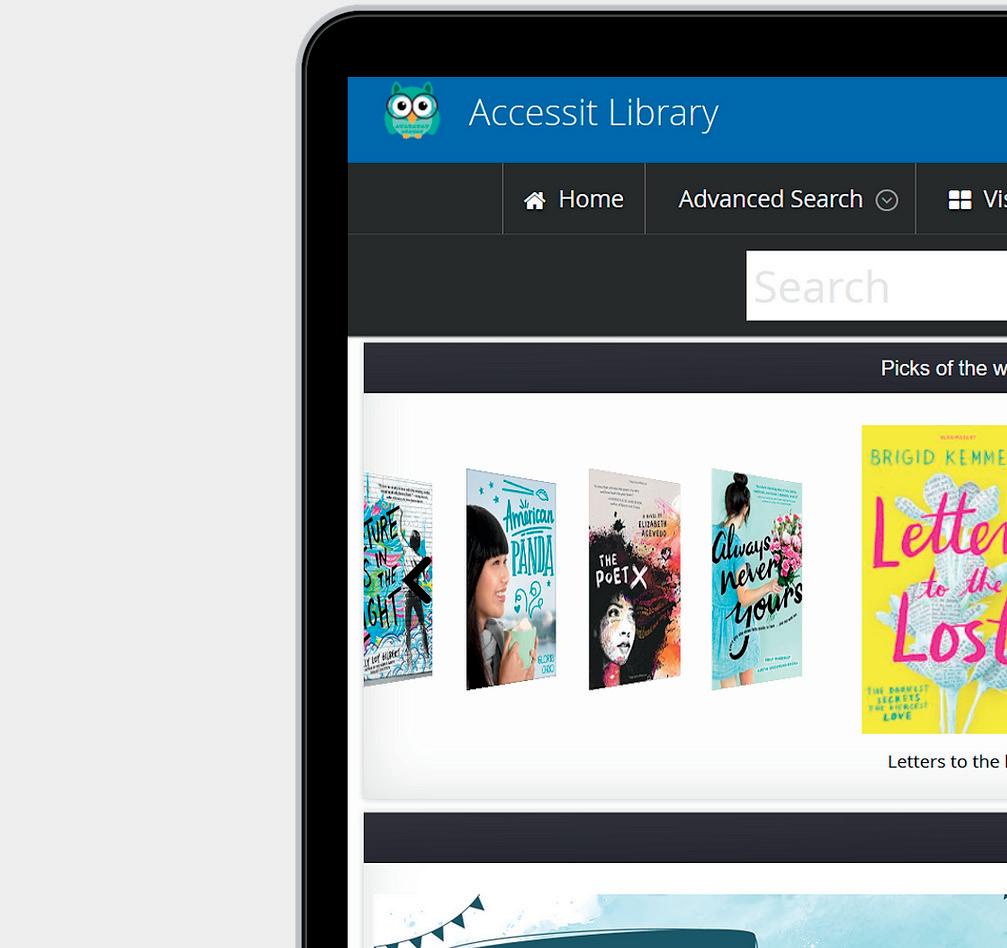


























Timely school-wide communication is important as we rely on bells and other notices to stay on schedule; in an emergency, an effective PA system is crucial.
School-wide communication is important in a variety of scenarios. Each time a bell rings to tell students and staff a period is beginning or ending, that’s a school-wide communication. Announcements, particularly for large schools, are often delivered over PA systems for efficacy and minimal disruption. Instant school-wide communication is also important for safety and security reasons. Should an urgent announcement need to be made, a PA system can ensure students and staff are prepared for any emergency.
As schools grow both physically and in roll size, efficient schoolwide communication becomes

increasingly important. For smaller schools, it may be time to start considering a PA, while larger schools might need systems upgrades, especially if they are still expanding. There are several solutions, and the most efficient and cost-effective PA systems may vary depending on your school’s needs.
First, audio over IP (Internet Protocol) could be a convenient
way to extend school PA networks. It simply means using (often existing) IP network to connect a speaker system. These systems could include software to help schedule alarms or bells, voice messages, announcements and more. The scheduling function is particularly convenient for any staff in charge of the PA system. It also centralises the control of the system.
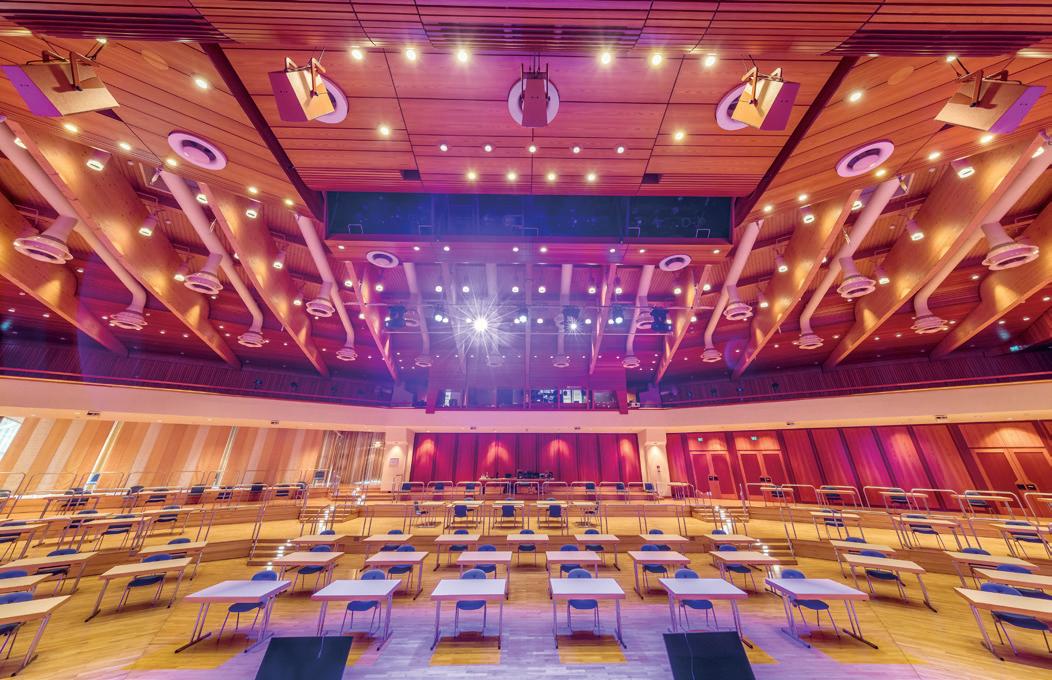
This form of speaker-system is also a secure and stable way to make broadcasts. It can reach all areas of campus and ensure that coordination is efficient and immediate. For example, if there is an intruder or other danger, schools can be quickly locked down and the appropriate authorities alerted. A PA system also makes coordinating resources easier for any emergency management purposes, like a storm, earthquake, or tsunami response.
There are also more everyday advantages of using a PA system for school-wide communications. School bells, for example, can be changed from a harsh ringing to almost any noise imaginable. This is particularly advantageous for children or young people with sensory needs who may be sensitive to loud noises. It could also facilitate school bonding, especially for younger children, if there is a song or a jingle to mark periods and lunchtimes.
With some software, an IP PA system could be organised into discrete areas of the school, so that what happens in one part of the campus doesn’t disturb another class. An IP PA system, then, could be useful for occasions such as sports games, where score or commentary could be read out over the localised zone without disturbing other parts of campus.
Portable PA systems may be important for some schools. These are particularly handy for sports days or outdoor teaching as well as events and fundraisers. Some are even wireless, and have extended battery lives. When not out and about, these portable systems can be stationed around the school and hooked into the existing PA system.

Euan Mackenzie from NAS Solutions said infrastructure is an important consideration in designing any muti-building system. “Paging systems can require specific field cabling to facilitate local volume control, and restoration for important announcements. Modern paging and PA system designs can take advantage of existing IT network infrastructure, providing a significant cost saving,” Mr Mackenzie said.
“Modern PA systems can offer more power efficiency and better control than previously possible, greatly increasing intelligibility and therefore reducing listener fatigue. This controlled design can also lessen noise transmission between rooms, reducing distraction from adjacent classrooms.

“The control system at the heart of modern PA designs can control and monitor video, window blinds, and lighting systems if desired. One touch can ready everything needed for a class.

“IP networked paging systems can be setup with redundancy fail safes which can be cheaper and more practical to achieve over IT network infrastructure.
Pre-recorded emergency messages can be triggered by fire alarm systems, and the monitoring function can be useful in reporting the systems performance following drills.
“Touchscreens can be custom designed to limit user access by passcode, and simplify controls for exactly what each user needs. Interfaces can even be run on a network computer where remote access has been enabled by the school’s IT department.”
Modern PA designs can control video, window blinds, and lighting










and supporting students with pastoral and additional needs, many educators are feeling burnt out. Besides the professional demands placed on educators, many are also experiencing the recent general stressors of the pandemic, raising families and the increasing cost of living.
This is especially true of schools, where teacher and student wellbeing can have significant impacts on each other.
Education can be a stressful industry. In recent years, the demands of the job have increased for teachers and support staff at all levels. Between increased workload, covering for absent colleagues, juggling deadlines, class plans


On the other side of the coin, it isn’t easy to be a young person in the modern age. For some tamariki, the “new normal” of the pandemic years may make up the bulk of their memories. For older children, coming of age during COVID was likely difficult, and many may be feeling like they’ve missed out on crucial experiences. Online learning can be disenfranchising, and




Although wellbeing is often thought of as an individuals’ responsibility, it can be contingent on the community.
the rising cost of living means many rangatahi are taking on part-time jobs to help make ends meet for their families.
In such high stress circumstances, it can feel like an impossible task to both maintain one’s own and support others’ wellbeing. Still, contrary to how it might seem, supporting others’ wellbeing doesn’t need to be incompatible with supporting one’s own. In fact, one can often lead to the other.

The Australian & New Zealand Mental Health Association recognises that educator wellbeing is invaluable because it is directly tied to their ability to educate. Children and young people’s wellbeing and achievement have been found to correlate with educator wellbeing. The wellbeing of the individual therefore shapes the wellbeing of the community and vice versa. This means that ensuring educator and student wellbeing is not just about individual strategies, but also community-wide systems that prioritise wellbeing.
The first step in addressing health and wellbeing is getting in touch with one’s own emotions. How does someone recognise they’re stressed, and how does one recognise stress in others? Stressors can be any number of things, and a big one is often change of any sort. Even positive events can be stressful, resulting in physical responses that are your body’s way of telling you to slow down. Learning to recognise and manage these can be a positive first step in ensuring wellbeing.
Physical symptoms of stress may include unexplained aches and pains and increasing fatigue. Exhaustion and issues with sleep can be self-perpetuating symptoms of stress. Digestive issues, headaches and feeling run down or becoming easily ill are other tell-tale signs of stress. A decrease in wellbeing could also lead to symptoms such as being anxious, irritable or becoming depressed.
Learning to recognise the symptoms of stress in yourself



can mean it’s easier to identify stress in others. School leaders and educators may wish to look out for people becoming suddenly withdrawn or disengaged compared to their usual selves. Stressed individuals may also be more easily irritable or frustrated. Missing deadlines or important engagements can also be a sign that something is wrong, as can lateness and absence. Any of these signs, though, need to take an individual’s usual baseline behaviours into consideration.
Our Niu Wave wellbeing programme aims to empower and equip Pasifika youth with the right tools and skills to nurture their wellbeing

The overall goal for our Niu Wave team is to support our Pasifika youth to unleash their full potential by feeling connected, celebrated, and inspired throughout the programme and where necessary, referred on to further wellbeing support


For more information please contact: niuwave@leva co nz or visit: www leva co nz

Being in tune with your own feelings, as well as the feelings of those around you is the first step. But that doesn’t mean that educators need to wait until something is wrong to prioritise wellbeing. Improving wellbeing in a school community can be a proactive exercise. The National Mental Health Commission (2022) from the Australian & New Zealand Mental Health Assocation found that there are three pillars to communal wellbeing in any workplace: Promote, Respond and Protect.
On the first, educators’ wellbeing improves when leadership provides an example. Supportive leadership that promotes inclusivity, open communication and clear direction can have a huge impact on promoting the wellbeing of educators. Leaders can also promote wellbeing by role-modelling appropriate behaviours and prioritising their own needs. Leaders should keep in mind that structural factors such as resourcing and behaviours can have a marked impact on community wellbeing.
The school community should encourage connections between people to build a strong foundation for wellbeing. A positive workplace culture can both result from and

reinforce positive leadership, creating a positive feedback loop that bolsters wellbeing.
Of course, culture is shaped not only by people, but also by policy. Again, there are structural factors that can either benefit or detriment individual or community wellbeing. Policies that ensure educators’ time and boundaries are honoured, as well as supporting their professional and personal development can boost educator wellbeing. Access to counselling or other support through the workplace is a structural factor that impacts educator – and therefore student – wellbeing. There is some national policy that takes some of these structural factors out of a schools’ individual control. Where possible, though, it is important to consider the structures in place at the school-level.
Wellbeing strategies can be employed by individuals within this supportive context to boost personal mental health. These include exercise, a balanced diet, healthy boundaries and helpseeking. When one is stressed, an effective intervention may be as simple as going for a short walk. Educators may also like to practise and share wellbeing strategies with their class in a spare moment. These could include practising gratitude, short meditations or time set aside for journaling.
To implement these interventions, educators will need the support and understanding of school leadership. Educators may wish to extend this to young people in their care. This is part of creating a healthy, thriving school environment which prioritises health and
wellbeing, and ensures people feel seen, heard and respected. Some schools and educators may need some additional support in creating a culture of wellbeing and a robust community. There are many programmes – some backed by government education departments – that can help educators and school leaders support themselves, and their staff and students. Some programmes involve a wellbeing professional who can provide coaching sessions to students with the supervision of staff. These can be like group counselling where a broad overview on general wellbeing management strategies is provided. Strategies could then be incorporated into class-time. Other programmes may be akin to a PLD course, where educators and school leaders themselves are coached on stress management and implementing structural wellbeing strategies.
While we can all take proactive steps to manage our wellbeing, it is important to know when to reach out for extra help. If you need support, please talk to a friend, or visit your GP or health professional.
Education can be a stressful industry.© Adobe Stock, stock.adobe.com
SMART$ Online is a free, interactive tool to help students develop financial literacy.




“I ran a financial literacy lesson using SMART$ Online yesterday and found those resources excellent.”
Four key topics are explored in fun, informative videos: Debt, Savings, Credit cards and KiwiSaver. Each video is followed up with a short quiz to reinforce key learning points.
Designed for use in mentor/ health/ form time or across several lessons.
POWERED BY:

Encouraging and fostering an appreciation for reading remains a key focus for educators of all students.

The ability to read and comprehend text is vital for students throughout their educational journey, across all year levels and subject areas. For young students, reading can increase vocabulary and comprehension skills. As students grow, improved focus, empathy and memory are all achieved through reading. There is also evidence to suggest that reading reduces stress and improves mental health.
Reading exposes people to new ideas and experiences. Cultural awareness, environmental conservation, recognising and celebrating individual skills and abilities, dealing with difficult situations, coping with change, and caring for your community can all be understood through reading widely and often.
Books, then, are a powerful resource for teachers. Offering more than a basic breakdown of the facts, books combine relatable characters, engaging imagery, and storytelling to help children learn about and interpret the world around them.

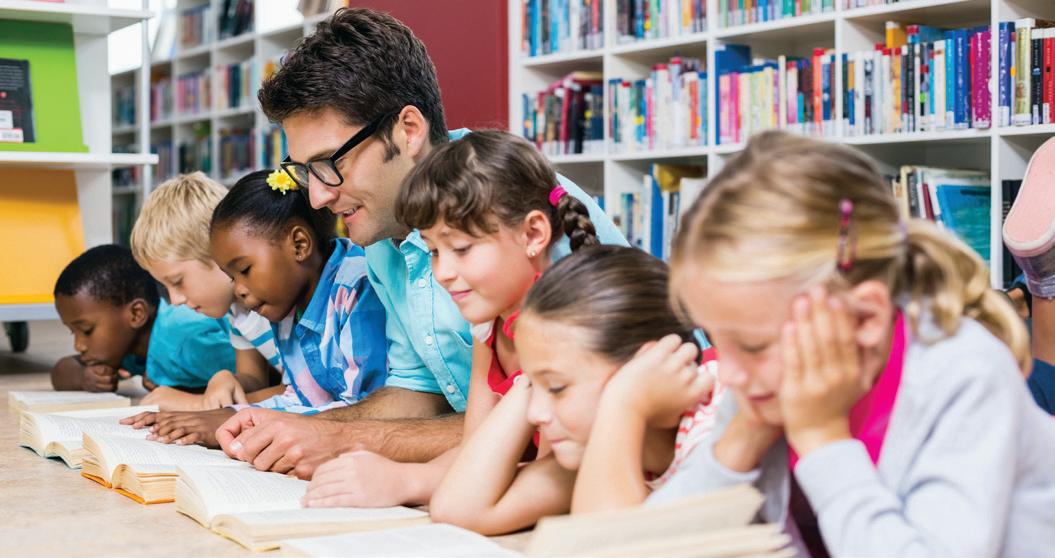
Here, we explore some upcoming releases across all age categories to complement the teaching of concepts in the classroom.
Nova’s Missing Masterpiece, by Brooke Graham and Robin TatlowLord, helps children recognise body cues that indicate they are starting to feel frustrated or angry, for example, stomping feet, crying, racing heart and funny tummy. The text incorporates current evidence-based strategies to help self-regulate and calm down, including belly breathing, listening to music, drinking water, and stretching.
Sandra Severgnini’s Meet Mim teaches children about the camouflage skills of the mimic octopus. Realistic illustrations depict the many strategies the octopus employs to impersonate the other creatures in its ecological niche. Young readers are taken on a journey through the natural world, with illustrations conveying the beauty and diversity of that ecosystem. Children
are encouraged to observe the transformations shown and guess what kind of creature can mimic other animals so well.
A creative non-fiction picture book, Monet Chases the Light, by Jenny Gahan and Patricia Ward, tells the story of Monet’s pursuit of aesthetic perfection in capturing light in his beautiful oil paintings. Highlighting the ingenuity of creating a masterpiece, children are given a visual appreciation of the challenges an artist must meet and overcome.
Explaining historical events can be made accessible through storytelling. When Grandma Burnt Her Bra, by Samantha Tidy and Áska depicts the world as seen by a child whose own grandma, a loud and proud feminist, was part of the revolution that now benefits us all. The book
uses humour to tell the story of multiple generations slowly overcoming long-held patriarchal views and traditions, emphasising that the feminist movement is not over and that there is still work to be done by the generation reading the book. Framing social history in an approachable manner with humorous illustrations, the book helps open up discussion in the classroom. Reluctant readers and learners may benefit from books which weave fantasy and reality. Game On: Glitched (Emily Snape), is packed with historical facts against a backdrop of adventure, comedy and fantasy. The story sensitively depicts sibling relationships and the themes of self-belief and forgiveness. Delightful illustrations by the author add to the fun.
Butterfly Girl, by Ashling Kwok and Arielle Li, illustrates urban life with its cultural diversity, while emphasising the need to make space for animals. The book shows children they do not need material objects or large properties to be happy; they can add a touch of magic to their lives, whatever their situation may be. Highlighting that one small person can make a big difference to the environment and to the lives of others, loneliness and the need for friendship is shown to cross all age groups and cultural boundaries. The story includes instructions for establishing a butterfly garden.
MOTAT Education brings exciting, hands-on science learning experiences into your classroom, without you having to spend a fortune on resources or hours of your time on planning.
Hire a MOTAT Learnables kit and give your students an opportunity to experiment and learn about computing, coding, electricity, magnetics and more. Learnable kits are delivered free of change to your door.
Ngā Paruauru Iti – Little Gardeners kit is specifically designed for early childhood learners and is based around gardening and learning about planting and garden wildlife.
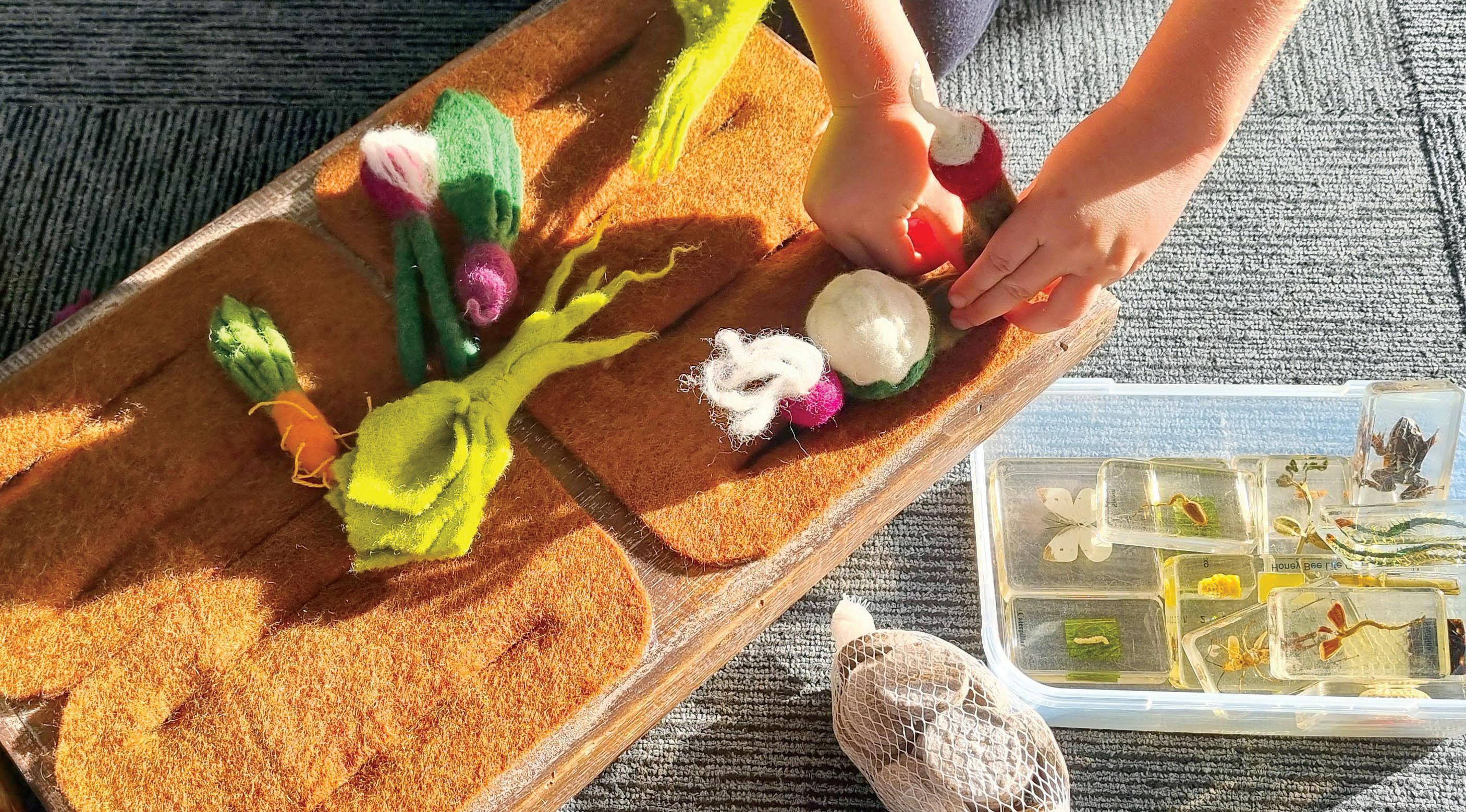
All kits are fully supported with suggested learning activities which are in line with classroom curriculum to help with planning.
Speak to a MOTAT Educator today and get your class learning with Learnables.
How can we get technology to work with us in the classroom rather than against us?
School News investigates the latest in classroom tech and unpacks how it can be used to strengthen teaching practices, and improve student outcomes.
Modern teaching and learning rely heavily on technology. Interactive whiteboards and smart screens, VR headsets, iPads, and of course computers, are commonplace. Along with pen, paper and books, these items are essential tools for learning.
Technology, though, can sometimes feel like the enemy of learning, especially for older ākonga. How can teaching possibly compete with the allure of the internet and all its distractions? Although a teacher’s first instinct may be to ban technology, a more effective solution could be harnessing the potential of technology to increase student engagement and even improve learning outcomes. Just think – is there any better student engagement than when the Kahoot! quizzes come out?
This increased engagement comes not only from technology’s ability to gamify activities, but also by helping students gain a sense of agency and control over their learning. In today’s digital world, it makes sense that students should learn how to navigate the internet to find reliable information on a given topic, and make the most of available resources.
One small scale study conducted in a tertiary US context demonstrated the potential of technology to improve student
engagement. The study found that student participation in class, preparation for class, attentiveness, learning and impression of the course and instructor tends to improve when technology is well utilised.
Technology can even increase collaboration between students in the classroom. Brainstorming has always been an engaging
method of generating ideas and discussion around a given topic. When it’s done on an internet platform connected to a cloud system, all ākonga can contribute to and see ideas generated as they’re put up on the screen. With this model, teacher supervision and feedback can be provided in realtime, and instant feedback can be invaluable to student learning.
For younger ākonga who may not be able to use technology unsupervised, and who may still be developing motor skills, technology such as touch tables can create an engaging learning experience that retains collaborative and feedback benefits.
Learning can become self-paced, with software options to facilitate self-directed progress. Some programs will prompt a student to practise a concept until they fully understand it, ensuring each student meets required standards. Programs can also alert teachers to students who may need extra support to understand a learning activity.
For teachers, technology such as smartboards, projectors and touchscreens can combine the best of traditional methods and the benefits of technology. Presentations can come to life as teachers demonstrate working in front of students and annotate passages that students could have access to in real-time.
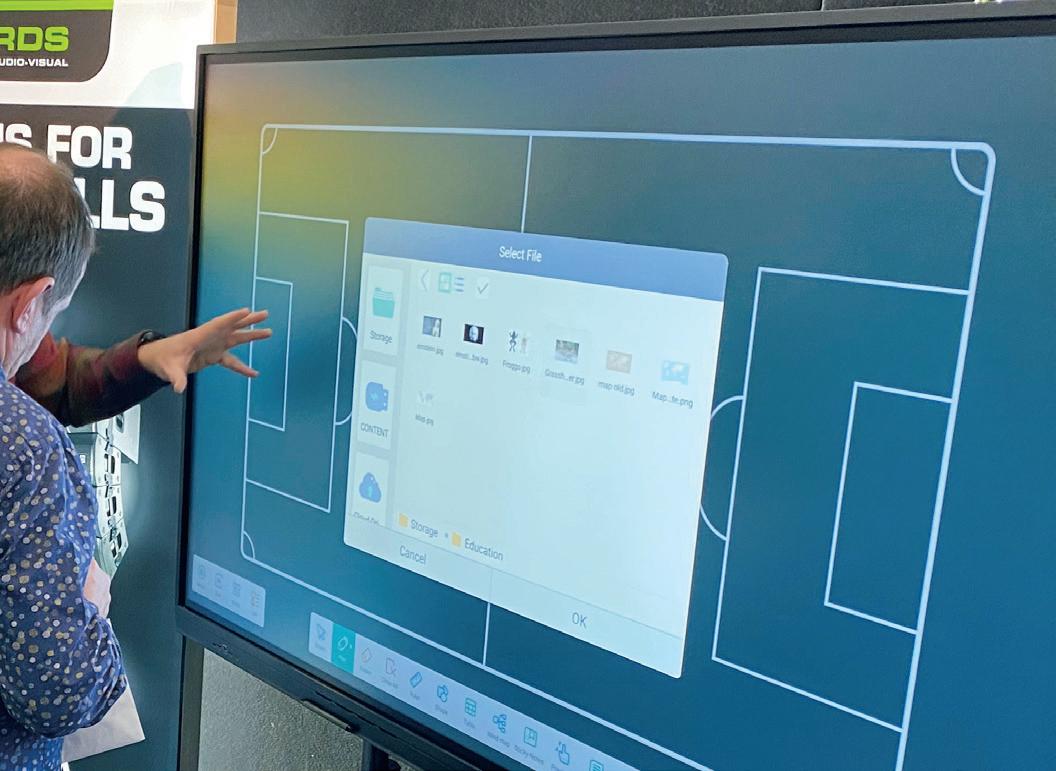
































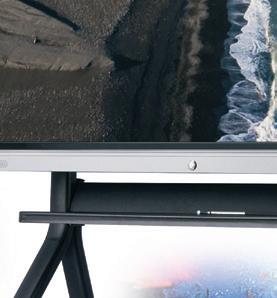
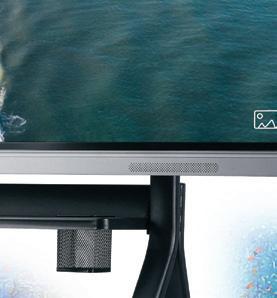



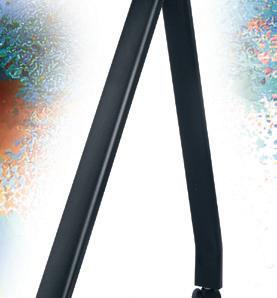






Benefits of PowerPoints and PDFs over traditional whiteboard working could include easy access to links, embedding of video resources, images and more! Plus, with a working document online, files are easy to share between students, and working can be easily accessible for any students who are away at any given time, or need to learn from home.
Additionally, working on touch screens or interactive smartboards can retain all the benefits of traditional teaching methods and handwriting, while harnessing the convenience of an online solution. Brainstorming on a touch table or interactive whiteboard can trigger those neural pathways so useful for
processing information for students. However, the final document can be easily shared around. And again, any learners that are absent can easily access the information and classwork for easy revision.
With technology and connectivity an inevitable part of young people’s lives, it is important students are taught digital literacy. This can be taught in house, on a regular basis, for example each time students browse the internet to find a reliable research source, or teaching a balance between screen time and offline time. Your school may wish to engage the services of an outside provider to teach safe technology use to students. This can be extended
to staff as a professional learning opportunity.
Importantly, technology can only improve pedagogical outcomes if teachers are well-versed and able to implement technology in their classrooms. We know and dread the sometimes-inevitable technological fumbling at the beginning of a class. Precious time which should be spent learning is wasted on figuring out how to use a projector, for example, with its many buttons and confusing interface.
To avoid these scenarios and maximise the benefits of technology, it’s imperative that teachers receive PLD whenever technology is upgraded, and that support remains ongoing. Often, the company that has provided devices or software will provide training and support to ensure staff can use technology efficiently. Specialist companies can also be engaged, to teach students and staff how to use technology to study efficiently, keep notes digitally and organise files.
One unexpected and invaluable source of support could be student help, especially in high school contexts or where ākonga are older.
Children of this generation are “digital natives”, and often find technology intuitive. For more on how technology could improve your classroom, School News asked some industry insiders for their insights.

Dr. David Parsons, research director, and a programme lead on the Postgraduate Certificate in Digital and Collaborative Learning at Acadamyex said teachers should consider the contexts in which technology can assist with learning. “They might look at what technologies students can use when they are not in the classroom. Interactive technologies are helpful here - for example, instead of just asking students to watch a video, there are digital tools to add interactions such as quizzes and student feedback.
“Teachers can think about how to use technology themselves in the classroom, and consider how technology can best be used by students in the classroom. Creative tasks, where students produce digital outcomes themselves, are best, such as creating virtual tours of culturally important places, or writing code to animate a dramatic scene
It makes sense that students should learn how to navigate the internet.Image courtesy of Academyex
“Professional learning and development are essential to help teachers use technology confidently and effectively. Having an expert facilitator is a more efficient way of upskilling than trying to work out everything on your own. Undertaking professional development with colleagues is even better - adding collaborative learning to the mix will increase motivation and mutual support, as well as foster conversations.
“When considering PLD options for incorporating technology, the most important aspects to understand are the overall strategies and pedagogies that ensure technology is used in positive ways in learning, and is not a distraction or a time filler. An effective form of PLD is where teachers select a formal qualification that reflects their own interests and allows them to engage in assessment activities that are embedded in their practice. This is more likely to result in sustainable learning and practice change than a short training course in one specific aspect of learning with technology.”
Jonathon Neil from Edwards Sound, Lighting and AV said the coming of age of Interactive TV technology is significant, particularly as older projector-based solutions are due for replacement.
“Projectors have limitations such as dim lighting conditions, lamp life, limited resolution, and the need for regular maintenance whereas interactive TV panels offer brighter and crisper visuals. They require little or no maintenance, and provide a more reliable and durable solution.”
Mr Neil said schools can take advantage of this opportunity to upgrade their outdated systems and provide students with a cutting-edge learning environment.
“This new generation of panels delivers on what the last fell short on and really will facilitate collaborative learning in the classroom.
“The high-res 4K display of panels brings content and videos to life, making content more realistic and engaging. The responsive touch-screen functionality allows students to actively interact

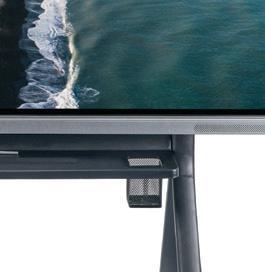

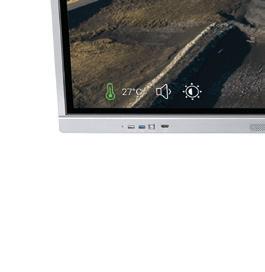

with the content, enabling them to manipulate, annotate, and explore in a hands-on manner.


“Visually appealing and captivating for students it’s like a giant iPad in a package we


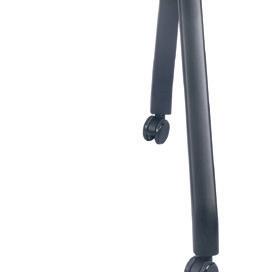




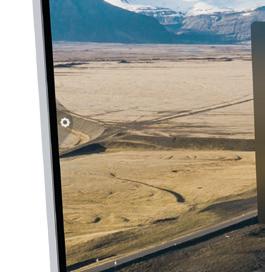


all intuitively understand how to use. With multiple touch points, students can collaborate in real-time, working together on projects, problem-solving activities, and presentations.”

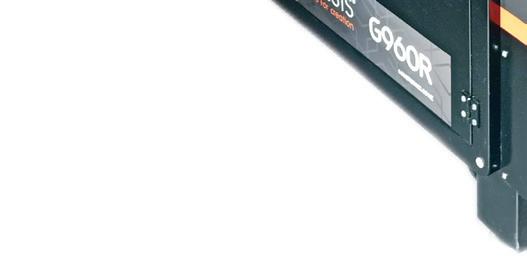


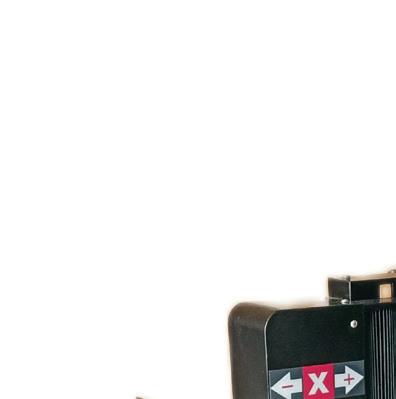 By Naomii Seah, Industry Reporter
By Naomii Seah, Industry Reporter
As technology advances, so does the nature of the job market and the skills that rangatahi need to learn – why not set them up with an education in the manufacturing tools of the future?
The woodwork shops of the 21st century, and metal-working and other hands-on subjects in schools, look significantly different than they did even a few decades ago. With technology becoming more accessible, available and userfriendly, machines that were once regulated to specific and specialised manufacturing purposes are now becoming more multi-use and ubiquitous.
Both laser cutters and CNC routers are cutting tools that can take the place of many machines used in a typical technology class. Computer controlled, they can work with various materials including wood, composite materials, metal, acrylic, glass and foam.

CNC routers can also be used to make intricate carvings, and laser cutters can be used for engraving metal, plastic and wood. Laser cutters are highly accurate, though there are limitations on the thickness of material that can be used with one. In the modern classroom, both laser cutters and CNC routers are common and can be used to teach across any number of subjects. The type of cutter – router or laser –will depend largely on the uses your school intends.
CNC routers and laser cutters lie at the intersection of art and science, and can be utilised for both creative expression and a more scientific method of learning, which makes them perfect for STEAM subjects. Any project that is realised with the
CNC router or laser cutter will involve design principles, which means accurate measurement and computer skills as well as application of social science and arts concepts. For example, students making jewellery will have to consider materials and dimensions, as well as the more abstract concept of jewellery design – who is it for, and what does it represent?
Both CNC routers and laser cutters run on computer programmes, which means that older ākonga who learn the programmes required for their use are learning digital competencies too. But even for
younger ākonga, who may run their design through a teacher who inputs the relevant codes, CNC routers and laser cutters are creating an opportunity for hands-on, kinaesthetic learning. There’s nothing more satisfying than holding a product you made with your own hands.
CNC routers and laser cutters are very safe methods of manufacturing due to their computerised, hands-off nature. Each model of CNC router and laser cutter will, of course, come with its own safety guidelines, and teachers may wish to consider their school’s health and safety policies.


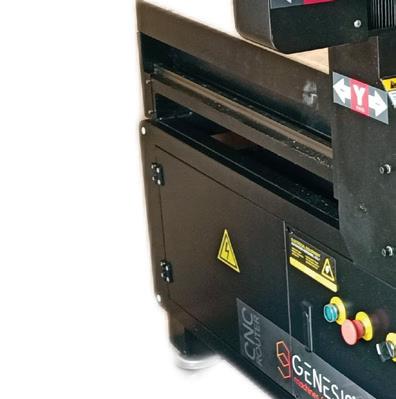
Marcus Lund from Makerspace NZ said laser cutters and CNC routers are machines for creation. “Projects involving laser cutters/engravers could be as simple as a paper silhouette or basic wooden or acrylic key ring, through to complex mechanical devices. We’ve seen student created work from basic recycled timber earrings to stunning table lamps to architectural models of buildings. “CNC routers enable the third dimension in subtractive digital cutting when compared with 2D technologies like laser cutting. Conventional three axis CNC routers are able to create simple 2D items, 2.5D models such as topographic relief models and full 3D pieces by slicing the project into component pieces for final assembly into a three-dimensional creation.”
Mr Lund said digital fabrication technologies are an essential tool in classroom technology, as they incorporate learning across multiple curriculum strands including concept design sketches, digital design, prototype creation, design testing and adjustment, model creation, assembly and finishing. “We have even heard of maths and physics standards being achieved via a laser cutter!” he said.
“Educators should have a good understanding of the risks associated with the equipment and how to mitigate these risks. CNC routers are not typically located in student accessible areas, to eliminate the risk of harm to students. Laser cutter access, while the laser is in operation, would typically be restricted to only students wearing laser safety glasses within one metre of the laser cutter for example. Suppliers can provide full safety information for the machines they supply - this is one of many reasons that it is not recommended for schools to purchase equipment directly from overseas manufacturers.”
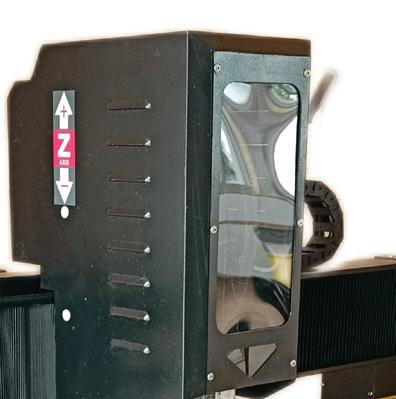

Palmerston North Public Library has two laser cutters, one supplied by Makerspace NZ. Used extensively by the public, the machines run six hours a day, five days a week. As a learning and projectbased space, the library’s “Blueprint makerspace” staff teach people how to use the lasers safely, before letting them use the machine freely.
Alice Lund from Makerspace NZ said there are several factors to consider when selecting a CNC router or laser cutter. “Cost, bed size, space requirements, safety measures, ease of use, software compatibility, and support in respect to spare parts and servicing will all impact equipment decisions,” Ms Lund said. “The complexity of programmable variables with CNC routing means
that training staff on software and machine operation does require more from both the trainer and trainee when compared with that of a laser cutter.”


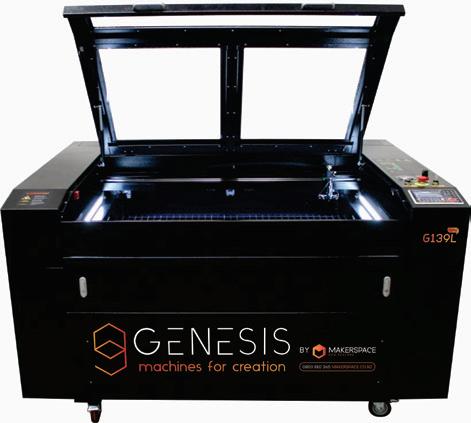
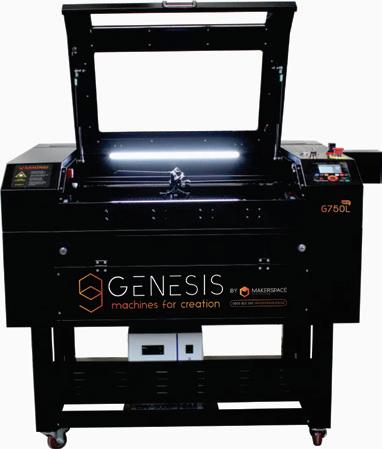

Harley Bell from Palmy Library said Makerspace NZ made it extremely easy for them to accomplish their
goals. “From initial purchase and set-up of the machines to the odd questions we’ve sometimes text to them at random hours, and restocking consumables, they’ve always had our backs and resolved it beyond our expectations.

















“The lasers are easy to use and








































teach to the public, and our goal is to make sure our patrons have the tools to succeed with minimum fuss. People use the lasers to create a wide range of jewellery, signage, storage, and prototyping. We often start first-time users with a simple project, like an engraved keychain or school bag nametag, then as they realise what the machines can do you see the gears start to turn as they realise what they can now make.
“Makerspace NZ has supplied lasers to several schools around us in the Manawatu and we’ve helped train teachers use, and maintenance as well. Teachingthe-teachers is one of our favourite things to do and has far reaching implications for their students. We often have kids coming into the space with their parents in tow, and the surprise on the parents faces when the kids start whipping up a quick design on the lasers is wonderful to see.”

Take a walk on the wild side with your students at the local zoo or wildlife park! With so many rich ecosystems available to explore, there’s sure to be an experience that’s just right for your class.

Zoos and wildlife parks have long held special favour in classroom excursions. Despite educators’ best eff orts, there are few more engaging activities than an EOTC excursion, and none more so than a trip to the zoo or wildlife park. Perhaps it’s the novelty of a new location,
or a multisensory stimulus that in-class activities simply lack. At the zoo or wildlife park, an enriching sensory experience can certainly be counted on, with each enclosure off ering a new environment for tamariki to interact with.


Whether it’s an imitation of the endless savannah, the microclimates of the ngāhere floor, or even a fresh- or salt-water environment, there’s a new and exciting world around each corner. Then, there’s the potential for interactions with animals themselves. Zoos and wildlife parks off er tamariki and rangatahi an up-closeand-personal experience with a given species or habitat in a
controlled environment which they otherwise might not have access to. Touch-tanks, hearing animal calls in the wild, and simply observing their natural behaviours and habitats provide lasting learning experiences. Interacting with these new environments might lead to an increased understanding of ecology and ecosystems among students. Although students may be able to memorise theories of how animals interact with the environment and one another, it’s another experience altogether to see bugs in leaf litter, for example, or animals interacting with props and other objects in their enclosures.
These sensory stimuli off er even the most reluctant of learners an engaging experience that helps to facilitate learning pathways.
One small-scale study looking at a classroom visit to the London Zoo described the impacts of a zoo visit on children’s understanding of habitat. It found that the students “developed new knowledge and refined existing knowledge about animals in their habitats as a result of participating in London Zoo educational activities.” The study also found that students put their newfound knowledge to immediate use, attempting to mimic meerkat calls when close to the enclosure. P50
Every year, their living classroom offers students the chance to explore and connect with nature and learn about the animal world.

It’s easy to walk around, and a perfect day out rain or shine, as 75% of their exhibits are undercover. Popular attractions include Dinosaur Kingdom, the Butterfly House, Mythical Creatures, Buttermilk Farm, Kiwi Forest, and a playful train ride.

With more than 50 life-size models including animatronics that roar and move, Dinosaur Kingdom is a great way to bring prehistory to life for young palaeontologists. Their Mythical Creatures exhibits are perfect for supporting tamariki who are learning about myths and legends from around the world, with dragons, serpents, and other legendary creatures to discover.
The tropical Butterfly House is filled with over 700 butterflies providing an immersive experience for students interested in insects and lifecycles. Kiwi Forest is home to young kiwi that are part of a national breeding programme, and provides an amazing opportunity to see our national bird in a special nocturnal environment. Students will enjoy being able to pat and feed friendly farm animals including goats, rabbits, alpacas and guinea pigs.
Groups can plan their visit around several free animal encounters including an impressive crocodile show! Schools can also book 15 minute education sessions to help students learn about dinosaurs, butterflies, kiwi, wētāpunga or eels.

A fantastic collection of free educational resources can be downloaded from www.butterflycreek.co.nz/ education-hub.




















For more information on how to plan and to book your visit www. butterflycreek.co.nz/school-visits.
Save up to 25%
lliiv
FREE Animal Encounters






FREE Education Resources







Dinosaurs and Mythical Creatures




Tropical Butterflies
Kiwi and Wētāpunga

Farm animals and more!
www.butterflycreek.co.nz/school-visits
P48
When asked, children clearly understood the “meaning” of each call they were making as they attempted to gain the meerkats’ attention. This study shows that the interactivity aspect of a zoo visit facilitates deeper learning and synthesis of knowledge in ākonga. Another study, which looked at primary aged students in Germany, found that a zoo excursion had many other benefits over classroom learning, including raising achievement. The study found that out of the classroom,
gender inequities were less pronounced, with girls stating that they felt less pressure and tension learning in the zoo context. It also found that an EOTC learning experience was associated with learner agency.
Zoos and wildlife parks will often offer educational programmes tailored to the needs of specific year groups and learning objectives. Kaiako can take advantage of the specialist knowledge that these educators have, and their knowledge of the facilities and resources available to enhance student learning during the excursion.
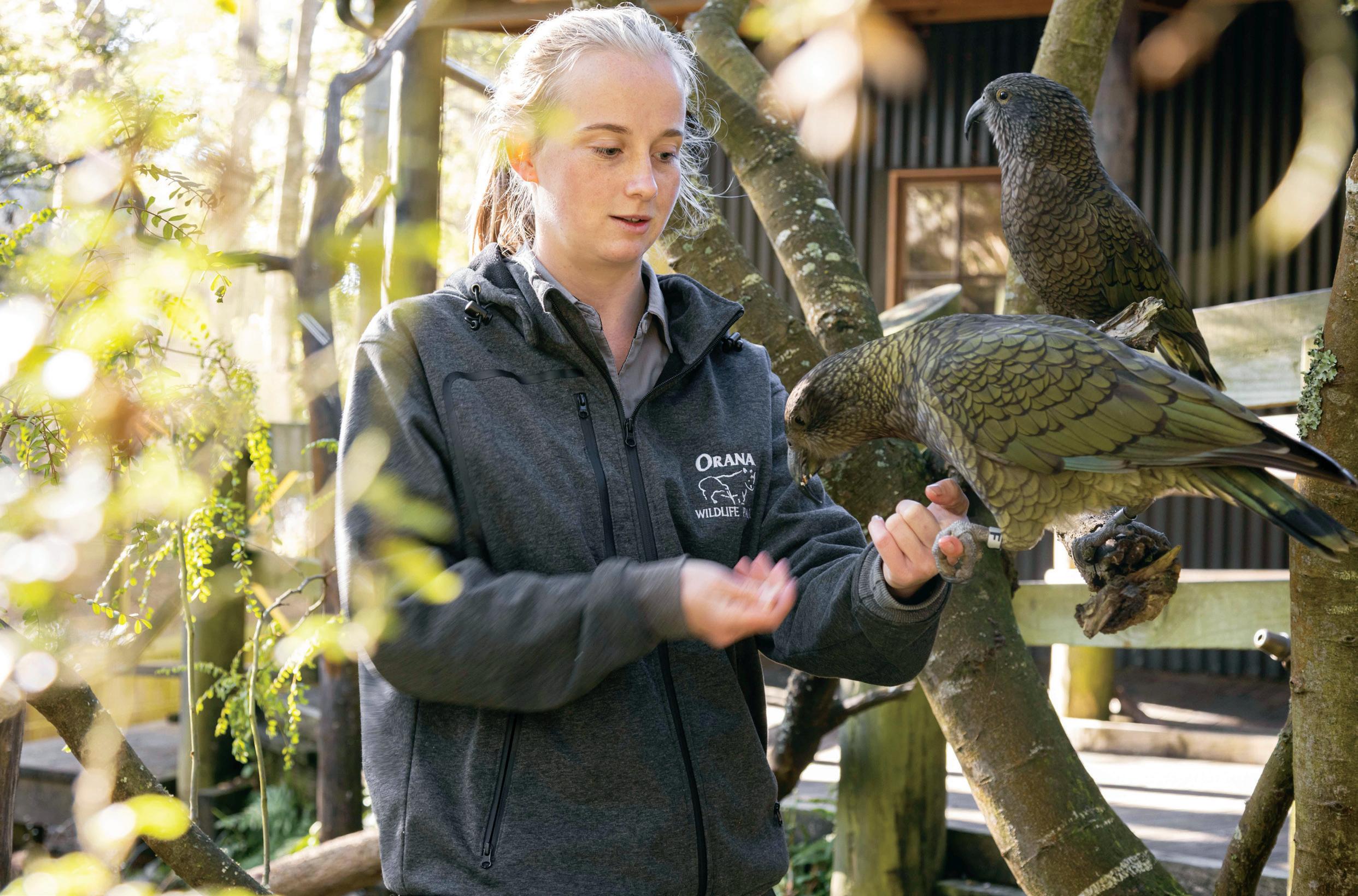
Many zoos and wildlife parks will also have their own resources available for use before, during and after the excursion to maximise learning retention. Worksheets, treasure-hunts, short and long answer questions, potentially even video, audio and visual formats for the modern learner. There’s no shortage of tasks and scenarios to get your ākonga more involved in their learning.
In the Aotearoa New Zealand context, zoos and wildlife parks have the added benefit of tying in neatly with modules on our unique flora and fauna, and can give students an opportunity to understand the myriad of
ongoing conservation efforts. Zoos and wildlife parks are often sites of captive breeding programmes, as well as a way to raise funds for conservation and environmental causes. Ready to plan a trip to a zoo or wildlife park? We asked some providers what they offer for school groups.

Butterfly Creek’s living classroom offers students the chance to connect with nature and learn about the animal world. The site is easy to walk around, and a perfect day out rain or shine, with 75 percent of the exhibits undercover.

Several different exhibits are on offer at Butterfly Creek, providing varied learning experiences.




With more than 50 life-size models including animatronics that roar and move, Dinosaur Kingdom is fun for all ages. The Mythical Creatures exhibits are perfect for learning about myths and legends from around the world. The Butterfly House is filled with hundreds of tropical butterflies, providing an immersive experience for students interested in insects. Kiwi Forest provides an amazing opportunity to see our national bird in a nocturnal environment. Students will enjoy being able to pat and feed friendly farm animals including goats, rabbits, alpacas, and guinea pigs. Groups can plan their visit around several free animal encounters including an impressive crocodile show! Schools can also book education sessions to learn about dinosaurs, butterflies, kiwi, wētāpunga or eels.
Set in 185 hectares, Orana Wildlife Park is Aotearoa’s only open range zoo. The team is passionate about connecting ākonga with nature in unique biodiverse settings.


Orana’s education programmes provide truly authentic, inclusive, and enriching learning experiences where ngā ākonga can observe and learn about the plight of Aotearoa’s and the world’s endangered species. Unique experiences that cannot be replicated inside a classroom, include hand-feeding the majestic giraffe, meeting Aotearoa’s only gorillas and encountering mischievous kea. The experienced team provide ready-made and bespoke programmes for Years 1 to 13 that support a diverse range of curriculum learning areas and themes including the Key Competencies, Values and Principles. Learning takes place through appropriately themed programmes that use the zoo as the ‘classroom’.
Key take-home conservation messages are incorporated into programmes to support knowledge and encourage discussion. The team at Orana are committed to inspiring children, encouraging them to conserve the natural environment and becoming confident, contributing future citizens.






Please ask us about funding for active recreation,








leadership.

Kokako Lodge
surrounded by 17,000 hectares of tranquility, challenge (high ropes) and adventure.

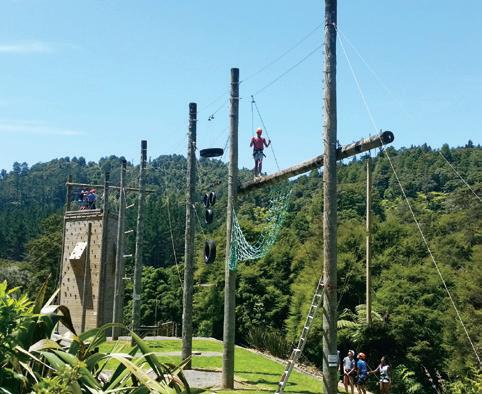
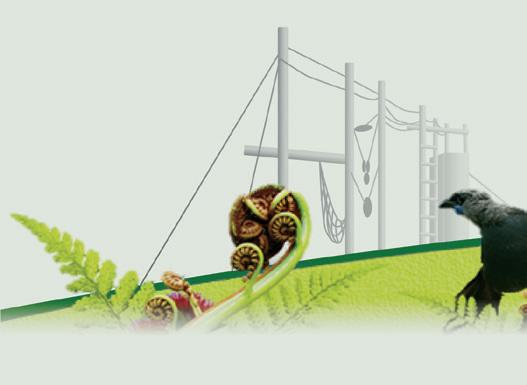
Spoken Word, Reflection Journals, team building games and personal challenge (by choice).











Trees beautify school grounds, provide nesting spaces for our native birds, offer shade and shelter from sun and rain, and produce fresh oxygen. Trees take care of the soul – but is it time to take care of your trees?
Trees can be vital members of the school community. Established trees can provide shade and shelter, and an opportunity for cheeky tamariki to climb. In their branches, trees can hold swings, treehouses, charms, even lights, as well as birds’ nests, fruits, and nuts. Schools with large grounds or long histories may even have trees planted by former students and staff. And in Aotearoa New Zealand, we are often blessed with pockets of ngāhere (forest) and bush around our public parks, playgrounds and schools, which means your kura is probably home to a native tree or plant.
In Māori tradition, all of humankind whakapapa (descends) from the land and


the trees. Trees are truly taonga. Like all natural resources, trees must be cared for and maintained to preserve them for future generations. Given proper attention, the trees around your school grounds could live for decades, even centuries to come, and provide shade and shelter to generations of children and young people.
To make sure you are caring for trees at your school, the first logical step is a professional assessment or inspection. Tree assessments or inspections could be particularly beneficial if you have large trees that overhang property such as classrooms, covered walkways or playgrounds.
Trees that occupy such spaces can become hazards if their branches are affected by rot, or disease. Trees that have such conditions pose a fall-risk, and falling branches could cause significant damage to any school property nearby. Additionally, trees that overhang walkways could be a health and safety hazard if not properly assessed.
Of course, being close to infrastructure may not be the only reason to request an assessment.
If a tree is looking worse-for-wear, or exhibiting unknown symptoms, a tree assessment may also be in order. An arborist can identify the problems and recommend the best course of action to preserve the tree. Schools may also wish to give significant trees – older or native species – special attention.

For peace of mind, schools may wish to consider an annual audit of all trees on site, which can be arranged with professional arborists. An audit of this sort ensures your kura is meeting workplace safety standards. A professional may also be able to identify future hazards, like a growing branch, a weak spot in a tree and encroaching roots. This will help your school plan for the future, including building additional infrastructure, applying for resourcing consents and removing hazards before they escalate. This is particularly important for kura in areas prone to storms or earthquakes, which could amplify the risk of falling branches and debris.

As for maintenance, trees should be trimmed regularly to prevent them becoming too big and hazardous. Though trees provide shade, this can


sometimes veer into the opposite problem, where they block natural light to parts of your school or kura. Fortunately, the Ministry of Education’s property maintenance grant covers the costs of pruning trees each year. There may be cases where trees will need to be removed. If the tree in question is protected –being a naturally established native, tree with cultural, historical or botanical value, or a tree protected on the certificate of title – schools may need to seek the permission of the council or obtain a resource consent to work with or around the tree, including removal and maintenance. If in doubt, it’s best to check with the local authority.
With some trees, potential hazards can be minimised with cabling and bracing. This is an attractive option for trees that are structurally weak or close to important infrastructure. Again, schools in areas prone to storms, high winds or other natural forces could consider tree bracing, which can save taonga trees without sacrificing the safety of students and staff and risking costly repairs to buildings or other structures.
Cabling trees works by providing external structural support to trees – either their branches, trunks or both. Cabling and bracing involves installing one or both of flexible and solid steel bracing to branches of concern. A degree of flexibility is important as the tree is allowed to grow stronger over time. However, a brace will prevent breakage.
A knowledgeable arborist will suggest cabling or bracing trees following an assessment for any structurally weak points. To be effective, the tree must otherwise be healthy. Bracing and cabling can last for some decades when installed correctly and maintained well through regular inspections. For more on proper tree maintenance and care, School News spoke to Senior Arborist Ryan Kneebone from Tree Fellas Ltd.
Mr Kneebone notes that “engaging with a professional arborist is important because things like incorrect pruning based on bad advice is most times irreversible and can lead to poor health and safety issues in trees down the line.
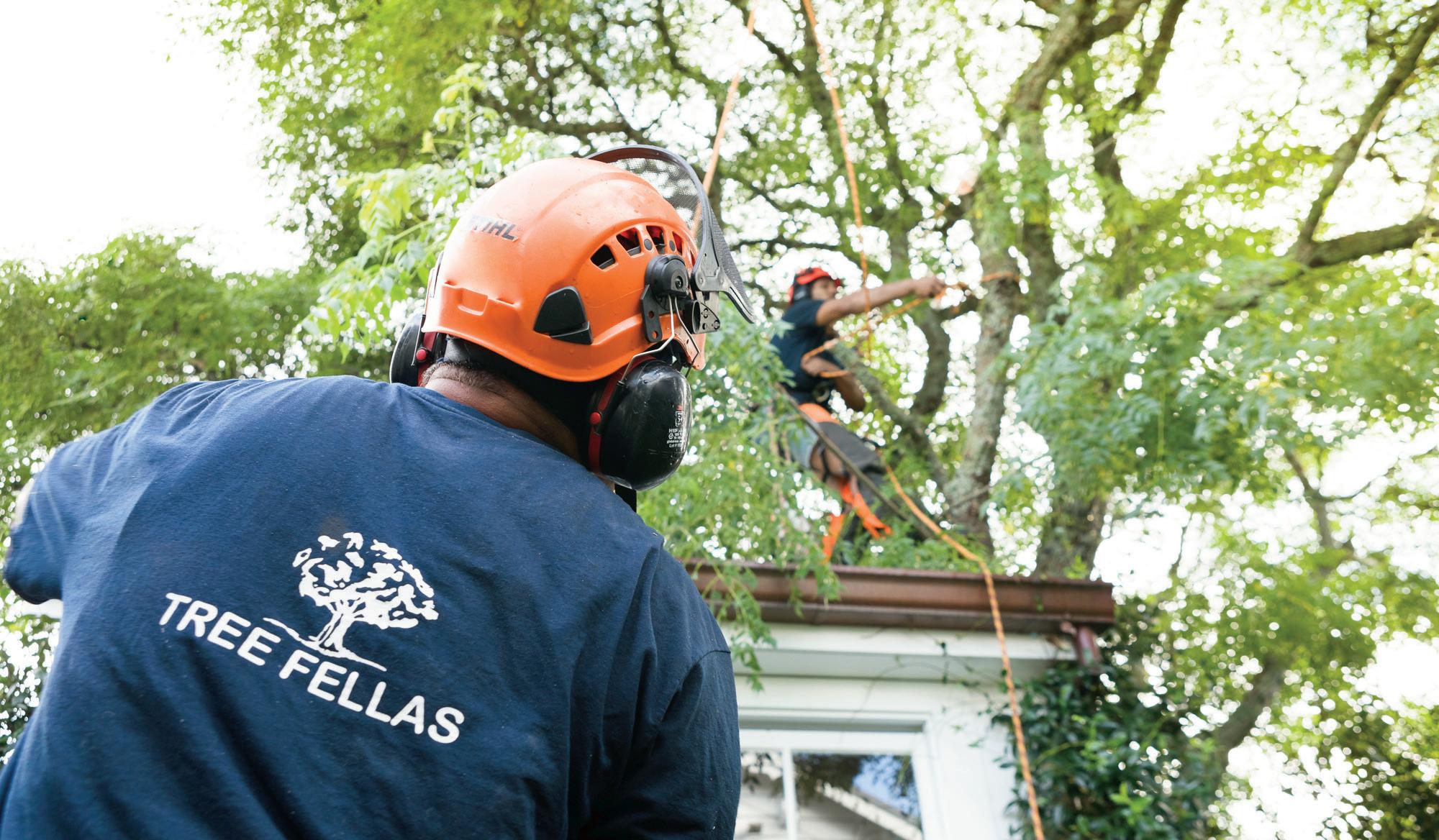
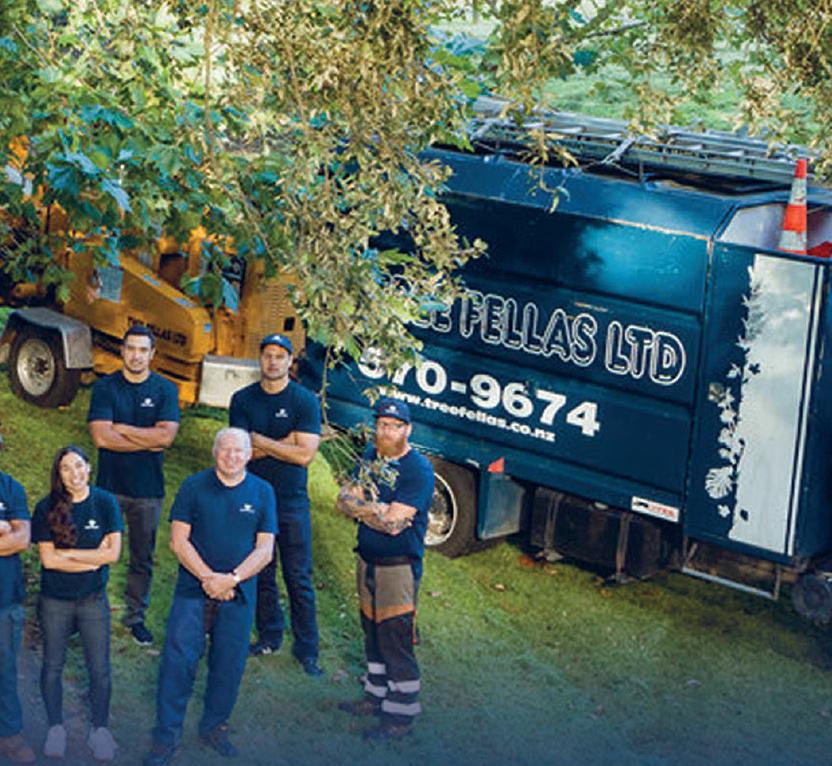

“If the school and board view the trees as assets then the trees should be managed by a professional much like other property assets would be handled.
“Having a detailed schedule and map for the trees on a property is a great idea. With large properties it’s hard to keep up with which trees have had visual tree risk
assessments done and what pruning has subsequently been carried out over the years. With a schedule, you can plan and prioritise what needs to be done and ensure trees continue to be safe, flourish and benefit generations of students to come,” Mr Kneebone said.
“Cable bracing can add supplementary structural support
to trees that may be showing signs of weak branch unions or potential branch failure. The outcome of installing bracing is to minimise risk that may be caused by extreme weather events like high winds and heavy rain. Only a qualified arborist should identify trees and areas where bracing is possibly required and the bracing itself should also only be installed by a qualified arborist.”
Digital signage is useful for keeping parents, students and teachers informed. It can also be a tool for community building through celebrating achievements and effective communications.
Once-upon-a-time, there was paper circulars, newsletters and the good old-fashioned school notices for students to bring home to caregivers. Of course, paper adverts and school notices still exist, but there’s no guarantee that they’re read once they’re delivered or posted in a public space. Beyond this, producing, printing and distributing paper communication can be time consuming, and increase your schools’ environmental footprint. Paper communications can become lost or damaged, so the message is not effectively communicated.
Enter digital signage. Depending on its position, digital signage can be an appealing, engaging and fuss-free way to notify the school community (including whānau and caregivers as well as teachers and students) of recent achievements, deliver notices –including emergency alerts – and boost the sense of community and togetherness in your kura.
Large screens near the entrance of the school, or the pick-up and drop-off points may be a good option. Screens could also be placed around the offices, or other areas where there is a high volume of parents and caregivers. This makes digital signage into a community-building exercise, ensuring that whānau remain engaged and informed about their tamariki and the wider goings-on of the school.

Notices displayed on screens could include meeting times and available extracurricular activities, student achievements, and important school information and dates to remember. Digital signage could even be used to point parents and caregivers to other communications. A message could be displayed, for example, saying ‘check your emails’, or ‘more information soon’.
For new or potential students, digital signage can be an effective way to showcase opportunities at the school. Photos or videos of students participating in school activities, or a welcome message from the Principal could be displayed in reception areas.
An easy to administer software solution to manage digital signage is essential. Most work through a cloud system, where educators can control signage from their computers. Systems are also becoming increasingly user-friendly, with drag-and-drop designs and pre-formed templates for educators to use.
There are also sophisticated scheduling systems that can be utilised. One-off notices or recurring reminders can be set so that the system runs with minimal supervision. Displays can also be programmed to turn on and off at designated times.
Digital signage can be multipurpose, depending on
its position. A digital display in a gymnasium, for example, can double as a scoreboard during games. For senior students, signage could be used to stream news broadcasts during break times, helping students to remain up to date with news and current affairs. Finally, a digital signage network could present a learning opportunity. Ākonga of all yearlevels could learn graphic design principles, for example, creating their own notices for events like school fairs, art shows and musical performances. With older students, snippets of these performances could be aired, or a selection of images displayed, creating a shared experience within the school community.
As for the actual hardware, a variety of sizes and screen options are available. Digital signage can be complex with an LED display, or the screen can be much simpler, depending on its purpose and your school’s needs. Your school may choose to install one digital sign at the entrance to the school, or a serious of networked displays around the school. Software solutions can divide signs into zones. Bespoke messages can then be broadcast on different screens around the school. This may be particularly useful if different content needs to be displayed to different year levels or cohorts.
Walid Hadi, Managing Director and Chief Engineer at WiPath Communications Ltd, said the most important consideration when purchasing digital signage is selecting the right provider. “Whilst there are some suppliers offering cheap solutions these typically have very short lifetimes as, in most cases, do the suppliers.
“With an expected life for a quality sign of between 12 and 20 years you need to be sure the supplier is going to be around to service the sign. There are very few compatible parts between different sign factories and therefore when a supplier goes out of business,
all access to parts is lost. The supplier should be able to guarantee parts availability for at least 10 years and they can’t do this if they have only been in business for five minutes.
“The supplier should have an engineering focus. Any company that is heavily sales focussed in this industry does not last. They should have ancillary business lines so that when the sign business slows as it did during COVID, they will survive to continue providing the service you need,” Mr Hadi said.
“It is easiest to think of an electronic sign as just another computer monitor. Practically anything that can be displayed on a computer can be displayed on an LED sign. The only restrictions tend to be regulatory not technological. Options are available for controlling signs directly from a computer, from a smart phone or via an application that sits in the cloud and can be addressed from any browser (with appropriate security).
“Modular construction means that almost any size and shape of sign can be built. A huge variety of different designs can be achieved, from simple signs generally used for short text messages to large electronic billboards. Design is only limited by imagination.”
In June 2023 WiPath installed the rst of our new super high resolution school signs at Kaurilands school.

The sign is double sided, 2 sqm each side with 3.91mm pixel pitch giving it a resolution 3 times that of the high resolution signs we have been installing in the last 3 years and over 6 times that of the majority of school signs that had been installed prior to that.

All sign orders placed before the end of August 2023 will receive a 10% discount on the LED sign. This includes schools that have current proposals.
09 302 1142 info@wipath.co.nz
www.ledsigns.co.nz
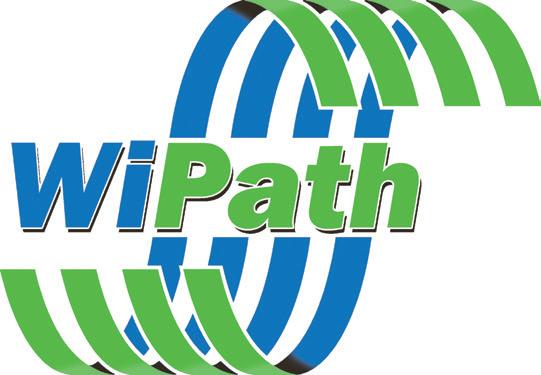


 By Naomii Seah, Industry Reporter
By Naomii Seah, Industry Reporter
Did you know poor acoustic environments could be affecting your students’ academic performance, and the wellbeing of teachers and students?
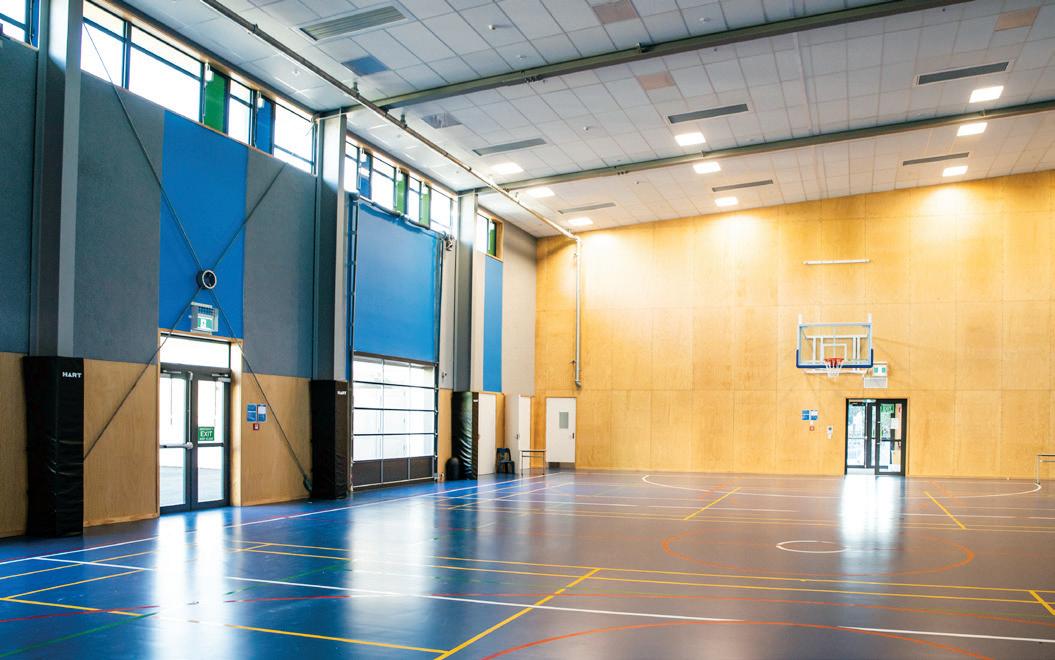
Classroom acoustics can play a significant part in the learning experience for ākonga, and may be more crucial than educators realise.
For one, a lack of soundproofing could mean extraneous noise becomes distracting. Without
balanced acoustics, tamariki may simply be unable to hear instructions or calls to attention.

Children are more sensitive to noise and reverberation when they are required to undertake a task that involves listening comprehension. This can affect literacy levels in young
children who are just beginning to acquire these skills.
The most common way to measure acoustic performance is with a microphone. A variety of factors are included, such as reverberation time, sound pressure level and speech transmission index. Reverberation time is often used as a primary indicator of classroom acoustic quality. It’s measured as the time taken for a given sound to fade to 60 dB after the sound-source stops. When reverberation time increases, teachers need to raise their voices to be understood, as regular indoor noise is amplified due to sound reflection. This can have negative effects on educators’ wellbeing, as well as children, who find it harder to listen to instructions.
The World Health Organisation (WHO) has noted that the physical environment of schools can be a stressful environmental factor, with high levels of noise contributing to adverse behaviour and moods such as increased irritability and aggression. The effects are amplified for children with learning difficulties.
So, how does a good acoustic environment measure up?
Reverberation time should be shorter, and sound pressure level should be high during teaching time, but lower during independent activity. To achieve this, schools can investigate installing sound absorbing materials, like ceiling tiles, carpet, and acoustic wall-panels. Another consideration when designing acoustic environments of the classroom is the Lombard effect. It describes the process whereby one child speaks, and as more join their voices grow steadily louder to ensure they can be heard over others. A good acoustic environment prevents this, as speech is intelligible at a lower volume.
Schools or kura undergoing

A well-insulated classroom creates a more comfortable space for students and teachers. Use GreenStuf® thermal and acoustic insulation to design quality learning environments that stand the test of time.


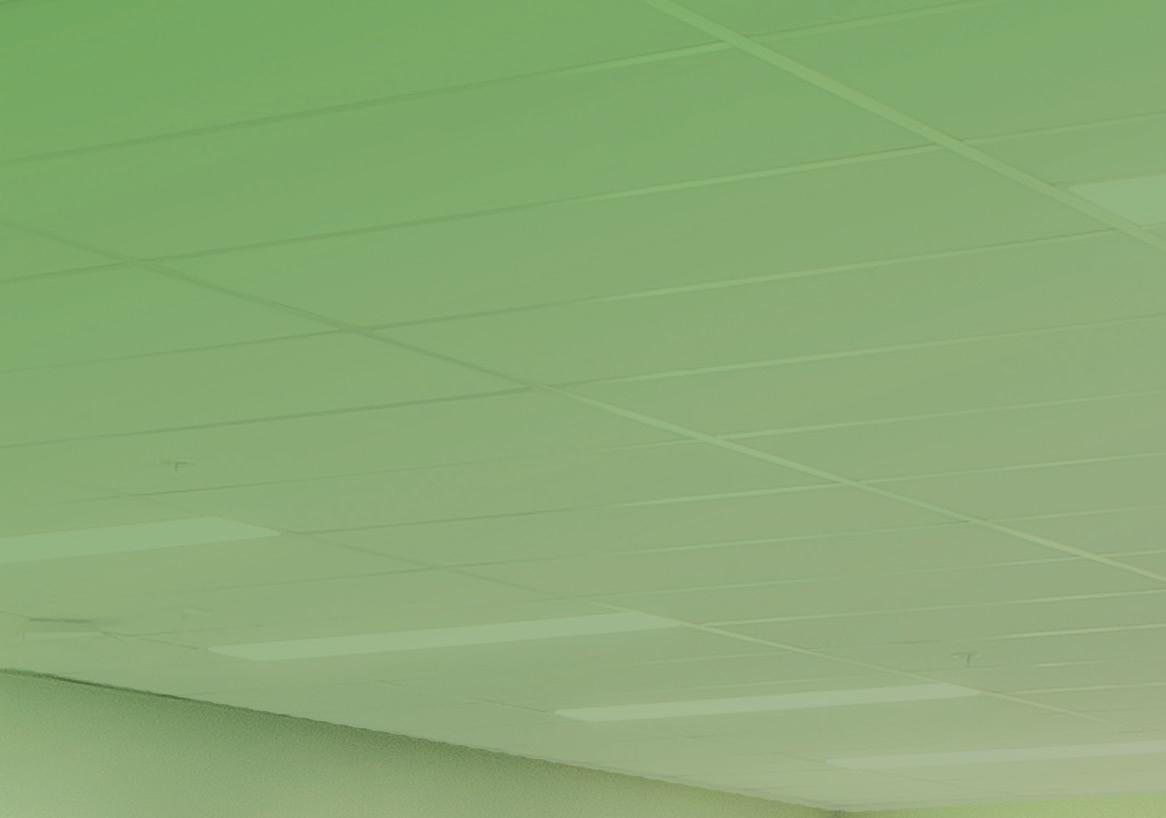




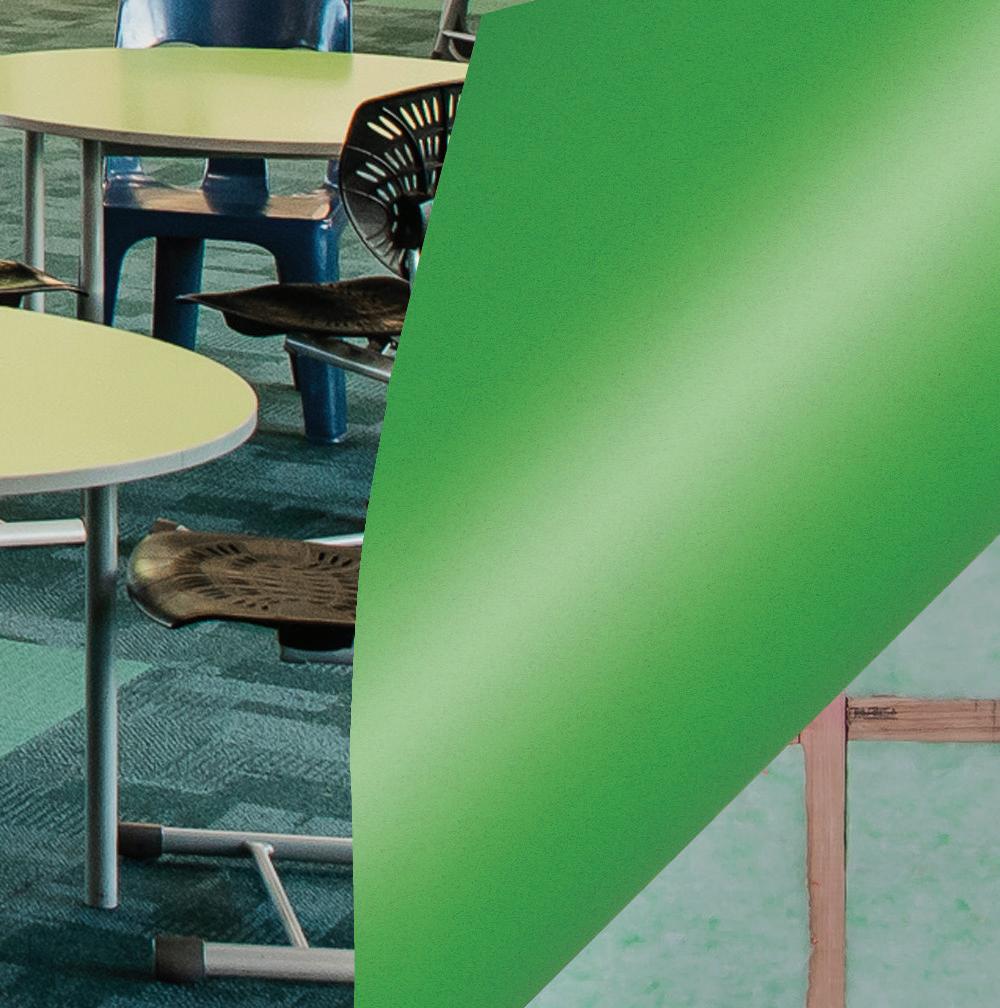
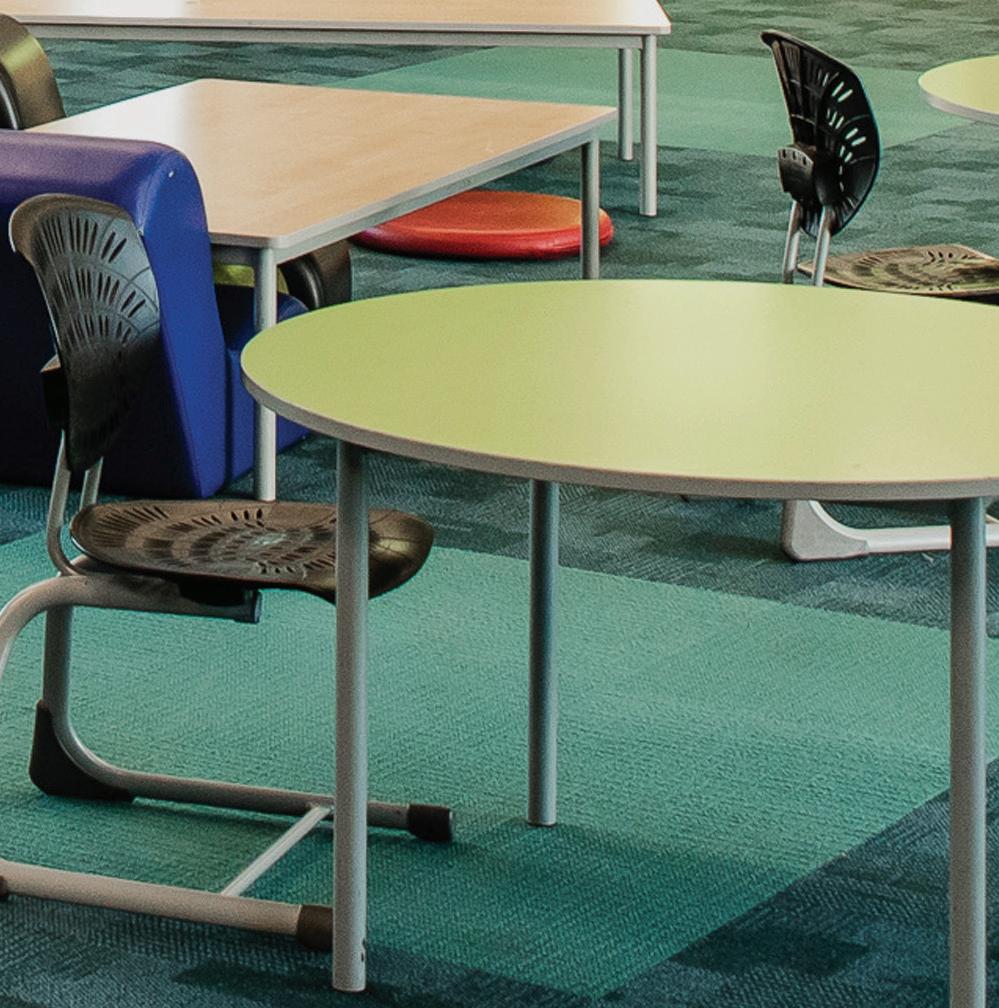
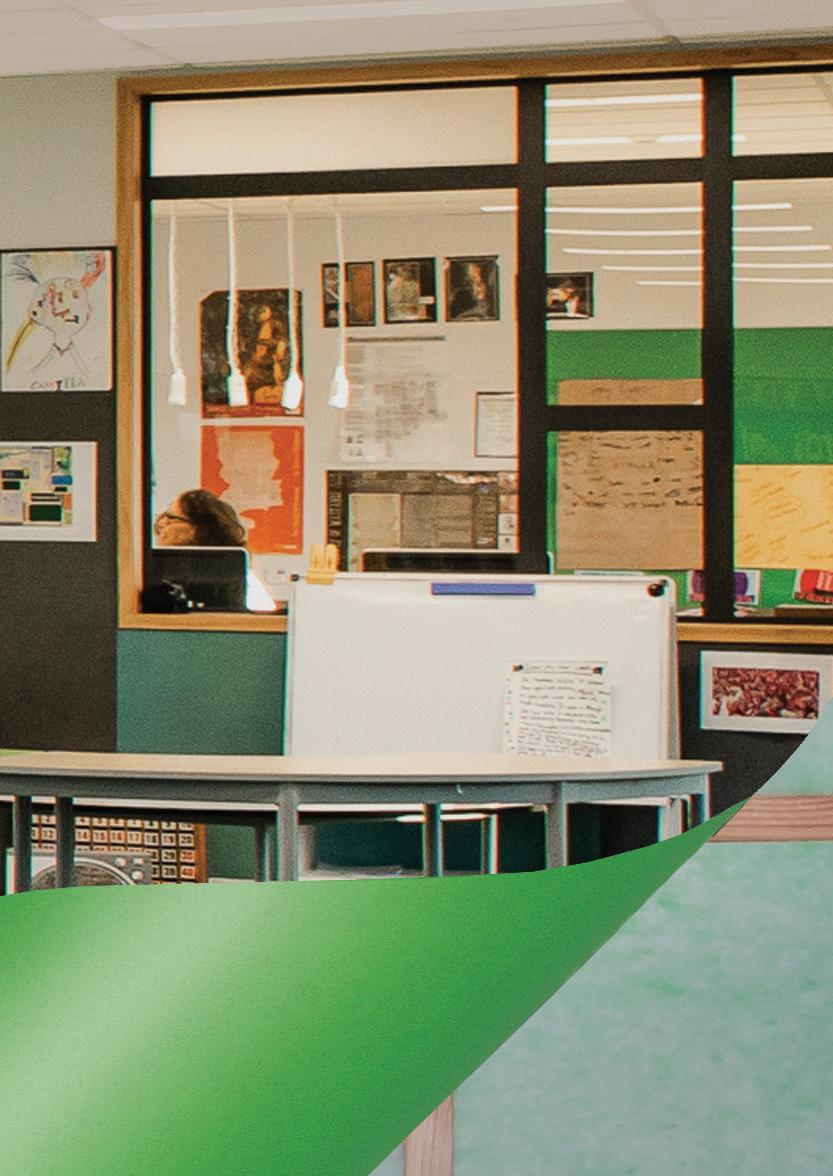

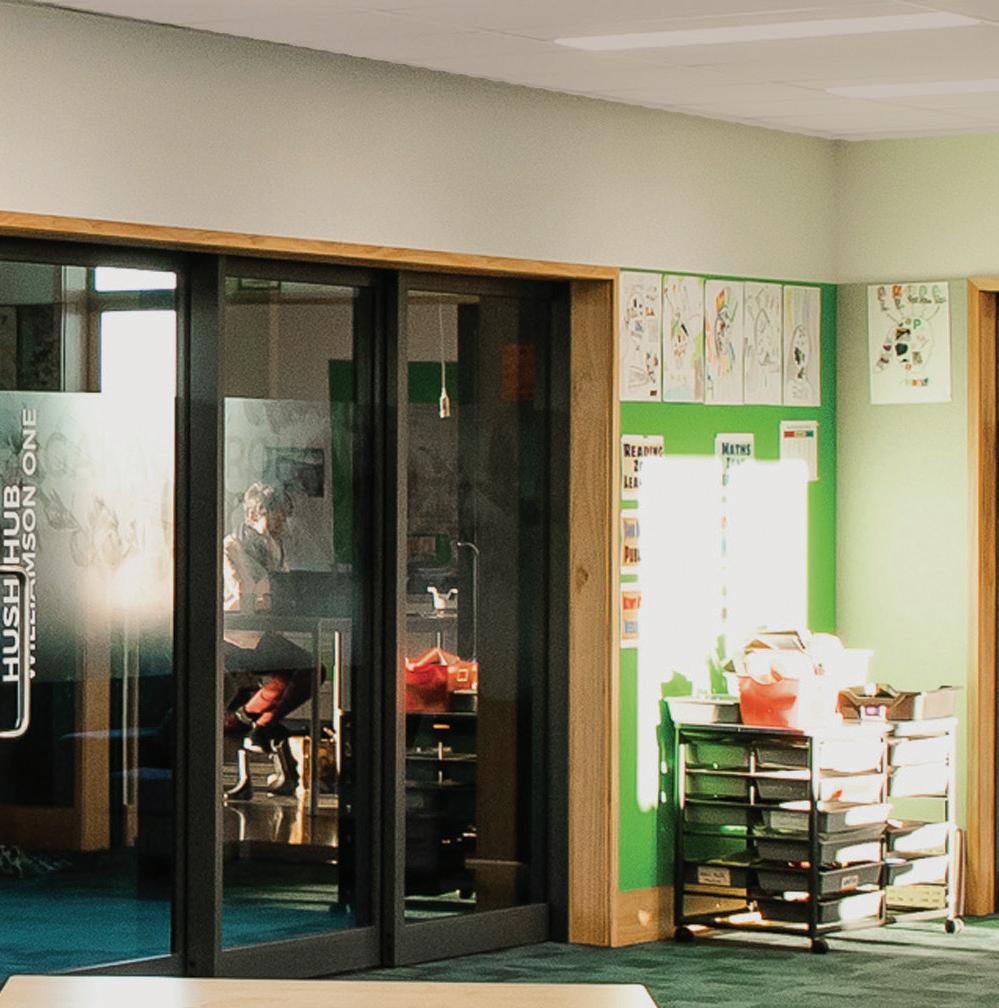
renovations or additions might wish to consider acoustic performance in the initial design. For one, the physical location of new buildings should be carefully considered. Is it by the road, for example, or too close to another classroom? Is it beside a sports complex? What sort of learning will happen in this classroom?
Depending on these factors, floors should be carpeted, and the acoustic environment could be modelled before the class
is constructed. Adjustments to design plans could be made to ensure an optimal environment for teaching and learning.
In other school contexts, such as auditoriums, acoustics can be notoriously difficult to manage. Ideally, auditoriums should be constructed with both macro and microenvironments in mind.
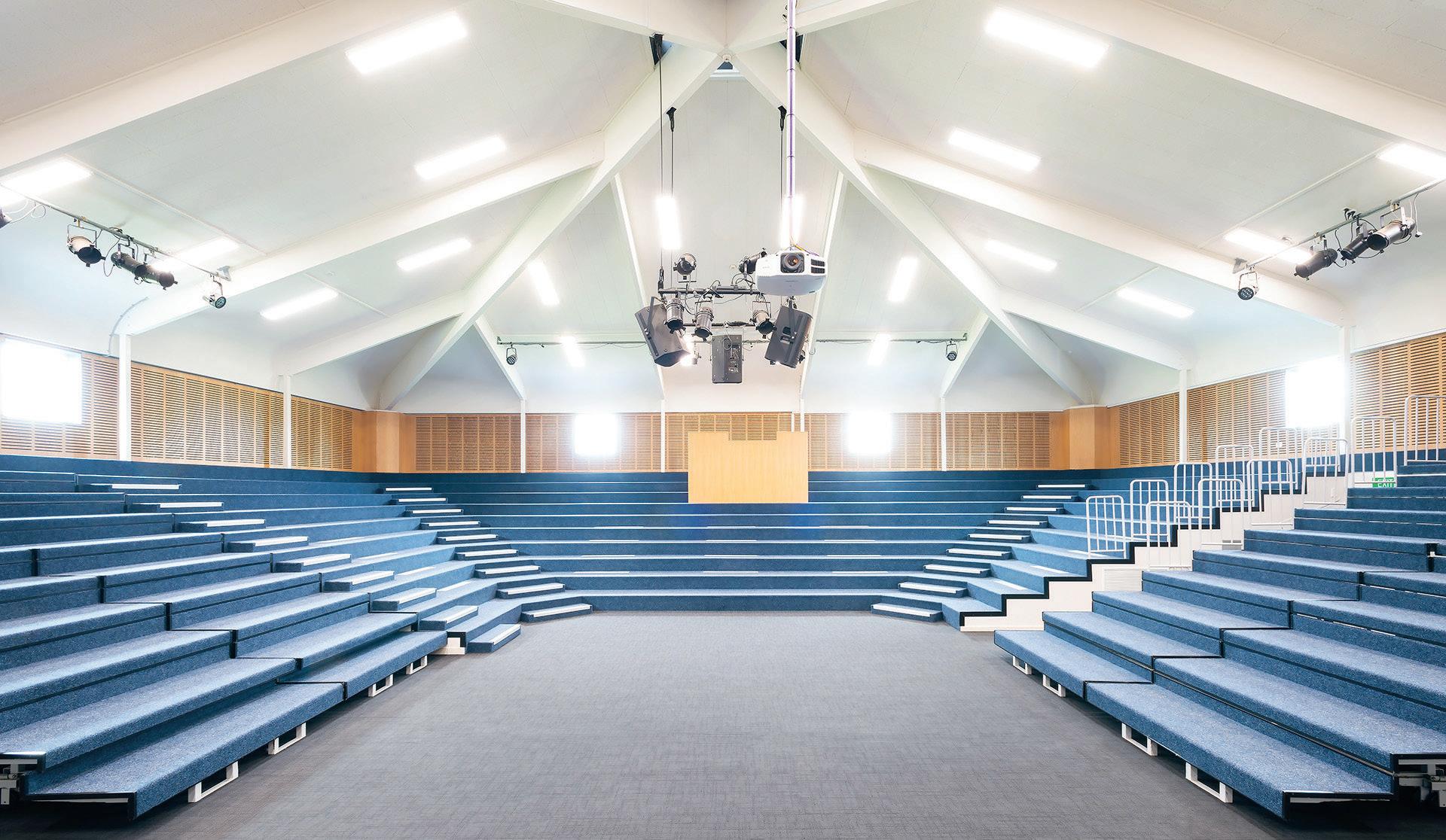
Macroenvironment management refers to ensuring that the surrounding site is not near an
unwanted noise source; and microenvironment to the inside of the auditorium providing a sufficient acoustic environment for the requirements of the space. There are acoustic standards that auditoriums can be measured by, that is, the level of ambient sound inside the auditorium should not exceed a certain level. Like classrooms, speech intelligibility is important, especially when addressing a larger audience. These factors
can be controlled via sounddampening materials, the shape of the auditorium and stage, and the height of the ceiling.
For more on designing an optimal acoustic environment, School News spoke to some experts in acoustics.
Ben Hutter, National Sales Manager at Autex, said acoustics play an incredibly important role in the modern classroom.
“A classroom with inadequate acoustics will be a space full of distractions for students,” he said.
“One of the big issues for children is background noise. This can make it hard for them to focus on work and negatively impact voice intelligibility from their teachers and peers. As a result, there is an increased chance of them missing or incorrectly understanding what their teachers are telling them.
“For years now people have known of the importance of sound absorption in classrooms, but the most recent Designing Quality Learning Spaces standard shows that there is a need for different types of absorption for different sound frequencies and the positioning

of these materials. For instance, using thicker materials to absorb a broader range of frequencies and the placement of these products makes for wellbalanced spaces for learning.”
Spaces like auditoriums pose a separate issue, Mr Hutter said. “Acoustic products with high performance sound absorption should be used to help reduce what is often a larger amount of noise at a range of different frequencies. The positioning of these products is critical to make sure sound can travel clearly to the audience.”
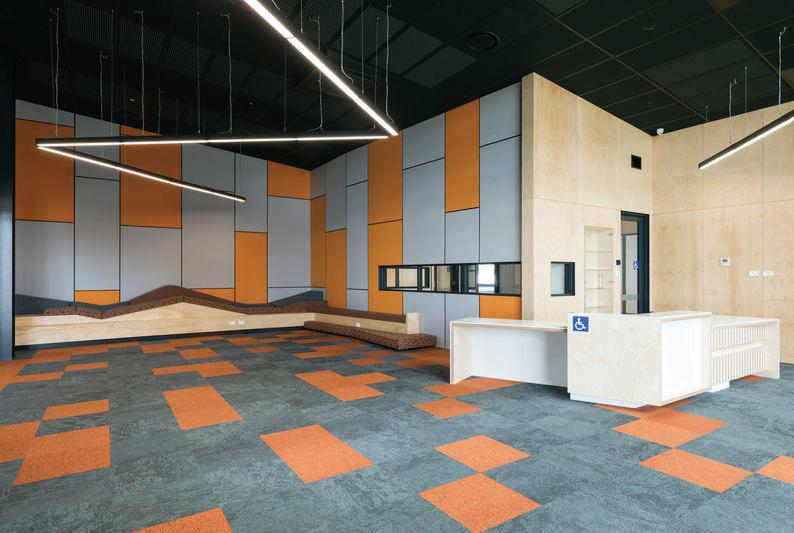

Mike Latimer, Acoustic LabLead at Canterbury Acoustic Testing Services, consultant to T&R Interior Systems, said good acoustic design is critical in a learning environment, and should be carried out by an acoustic consultant.
“Long reverberation times lead to a noisy teaching environment. Reflected sound builds up, and pupils and teachers start to raise their voices to be heard, increasing the noise level in the room. Reverberation can be controlled with the correct quantity of sound absorption
materials. This is often calculated by an acoustic consultant, using AS/NZS 2107:216 AcousticsRecommended design sound levels and reverberation times for building interiors, or Designing Schools in New Zealand, Design for quality learning spaces (DQLS),” Mr Latimer said.

“Commonly used materials are suspended ceiling tiles, carpet, acoustic wall panels, curtains, and soft furnishing. Placement and type of absorber is critical, and must be distributed evenly around the room.





“High background noise can interfere with communication. This can come from HVAC, roads, aircraft, and other school activities. There are design levels that should be followed and are available from the AS/NZS standard and DQLS mentioned above.
“In large open learning environments, managing class activities can help keep internal noise levels to an acceptable level. This can be done with the use of breakout spaces, scheduling noisy activities
so they don’t coincide with quiet activities, and the use of absorbent screens.

“Often large open spaces such as auditoriums and gymnasiums are combined to form a multipurpose space. This makes selection and placement of sound absorption more critical. Other acoustic products such as reflectors or diffusers may be required.”
Andre Cowan, NZ Acoutic Manager at Asona, said speech intelligibility in classrooms is crucial as students need to hear and understand the teacher. “To address factors which may impede this, schools can implement sound-absorbing materials, such as 50mm thick acoustic ceiling and wall panels, to provide balanced sound absorption across the 500 to 2000 Hz. These materials help reduce noise reflections and improve speech intelligibility. Proper insulation and sealing of doors and windows can minimise external noise intrusion. Additionally, strategic classroom layout and design can help optimise sound distribution and minimise disruptions.
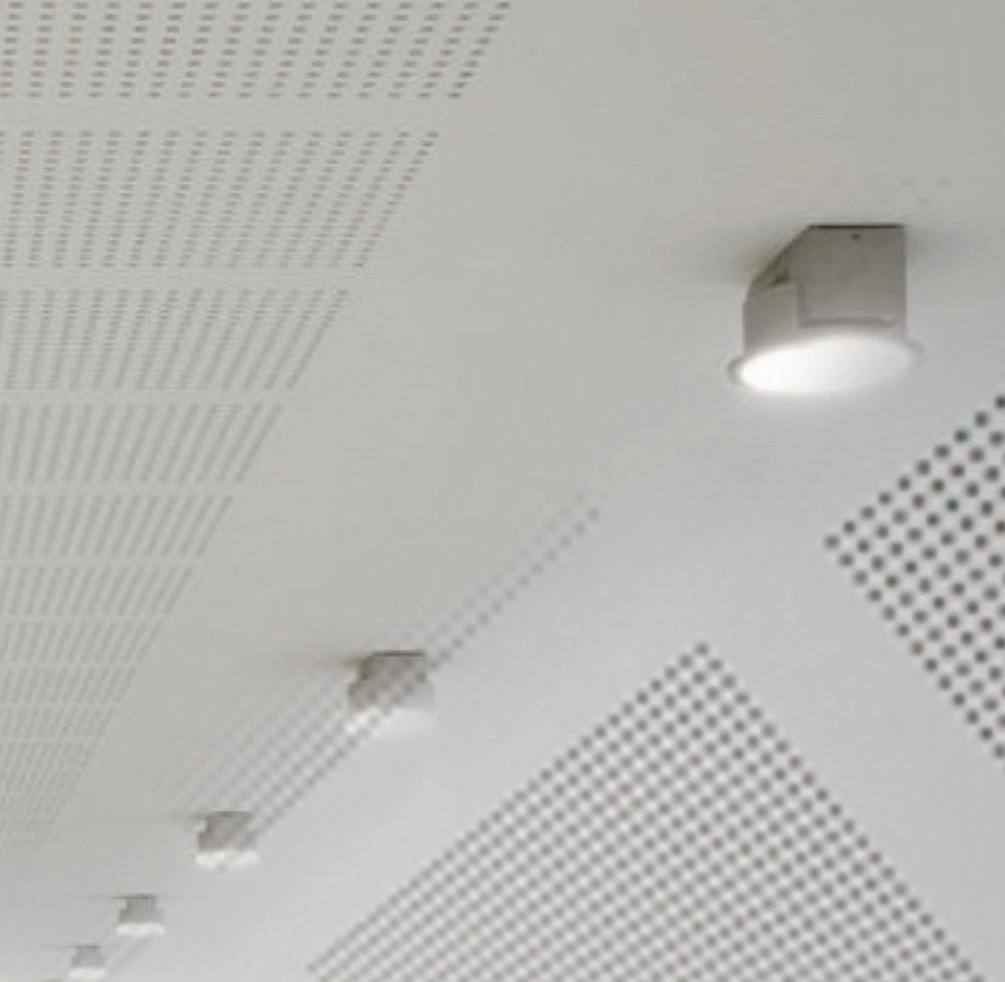
“When building or refurbishing a learning space, proper design and layout is important. The shape and dimensions of the classroom should be planned to minimise sound reflections and optimise sound distribution.
“Employing soundproofing techniques, such as insulation, double-glazed windows, and solid doors with acoustic seals can effectively minimise external noise intrusion. Educating teachers and students about the importance of maintaining a quiet learning environment is also important,” Mr Cowan said.
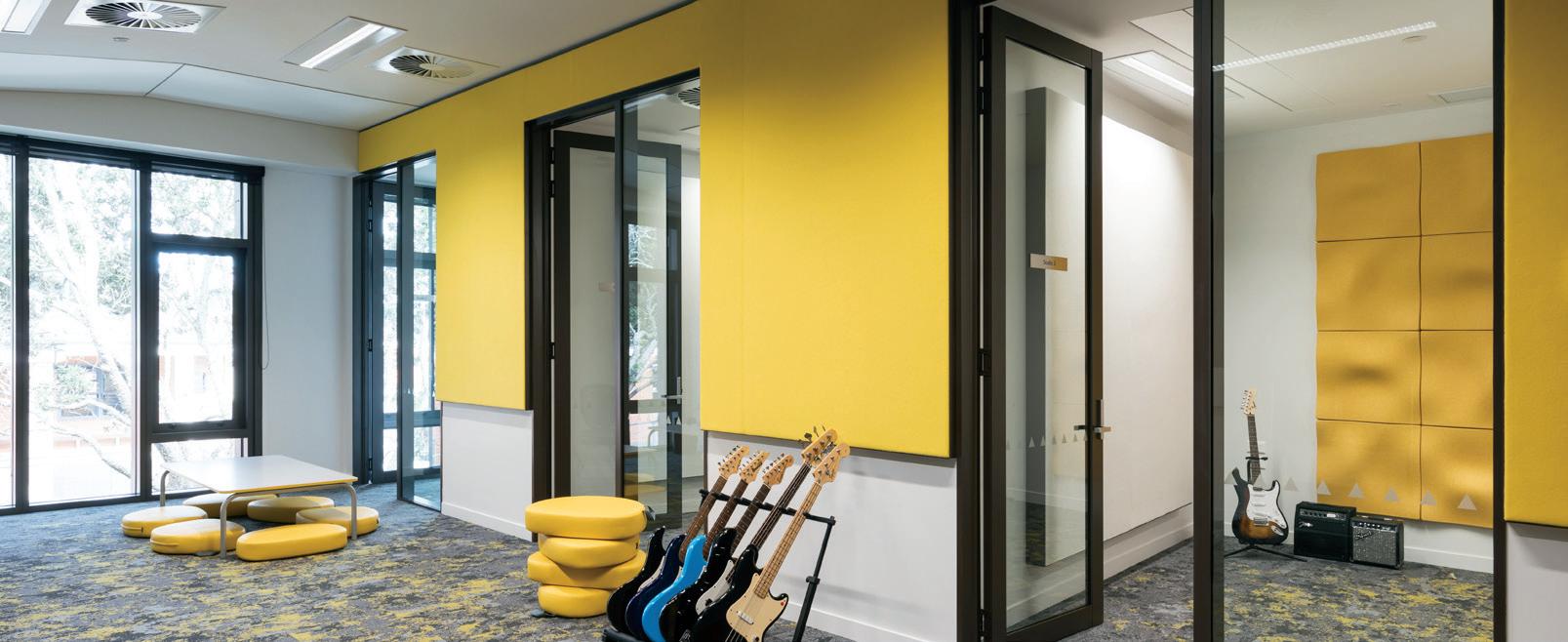
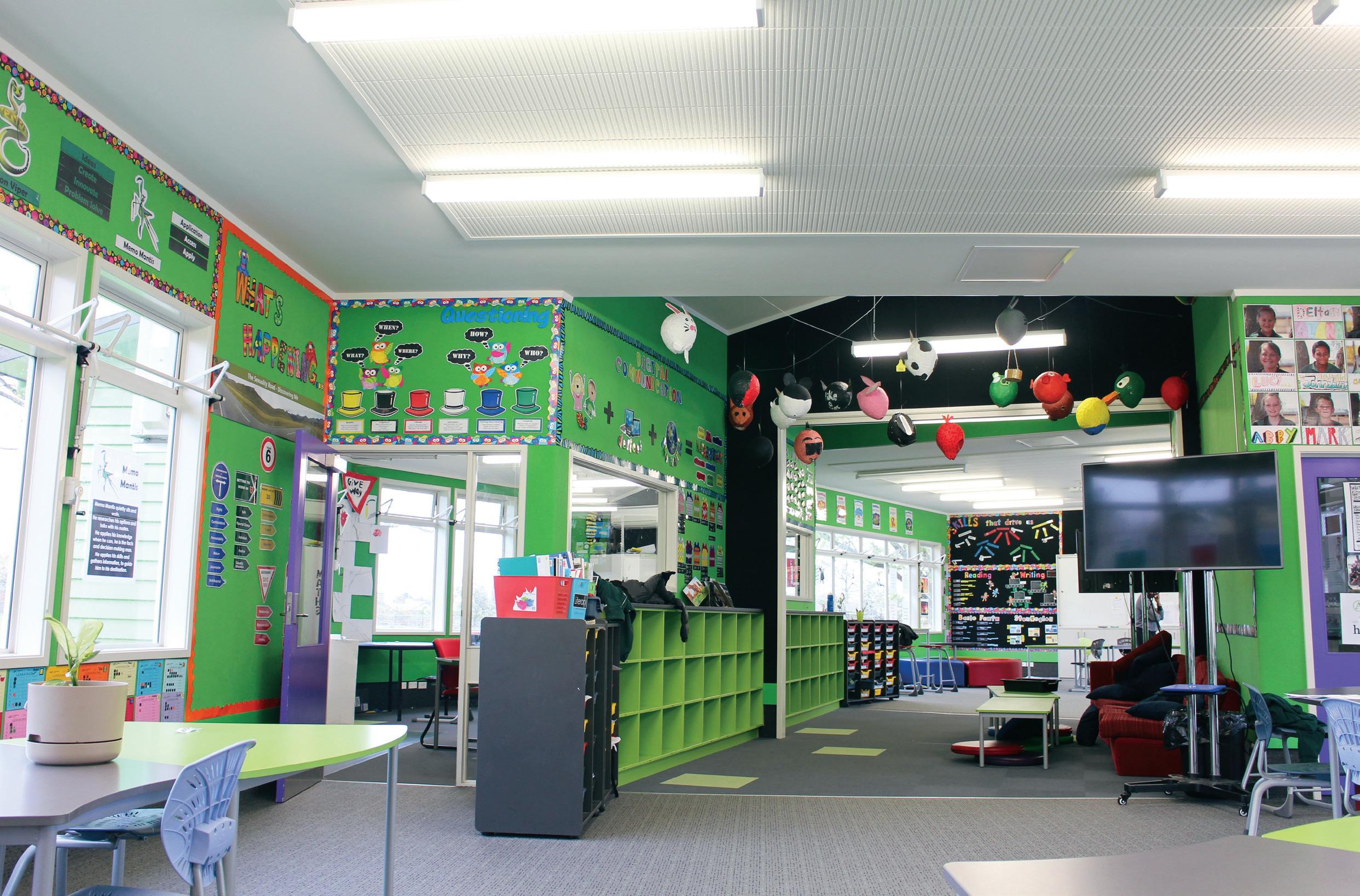
“Large spaces like auditoriums and gymnasiums present challenges due to their size and high occupancy. To ensure optimal sound quality, acoustic design should be considered, including the use of diffusers, absorbers, and reflective surfaces. Installing professionalgrade audio systems, including microphones, amplifiers, and speakers, designed specifically for large spaces can ensure even sound coverage and clarity. Portable sound-absorbing panels or curtains can also be strategically placed to reduce reverberation and
enhance speech clarity during events or performances.”
GreenStuf spokesperson Ben Hutter said when working with educational spaces the reverberation within a classroom is often the first issue people think of.
“While this is an important area to focus on, we also need to think of the ambient noise levels within the space. Sounds from traffic, rain noise, and people outside of the classroom can also cause distractions.”
Acoustic treatment, then, is important in both the
external envelope of the school and indoors through partition systems.
“One of the considerations when looking to achieve balanced acoustics within a classroom is location. Is the space near a busy road or even high traffic areas of the school? Do your partitions indoors meet the minimum requirements of the Designing Quality Learning Spaces standards? These are the types of questions to start with. You also need to investigate the weak points of a wall or ceiling. Using products like a baffle block are a cost-effective way to remove sound transfer between classrooms, and for retrospectively improving acoustic privacy,” Mr Hutter said.
When dealing with larger space likes auditoriums and gymnasiums, there are a few factors to consider. “Keeping noise from entering the space is important, but due to their purpose, these spaces often create a lot of noise too. Through adding mass and insulation into your external envelope, you can help keep noise inside while removing any additional noise from external sources.”

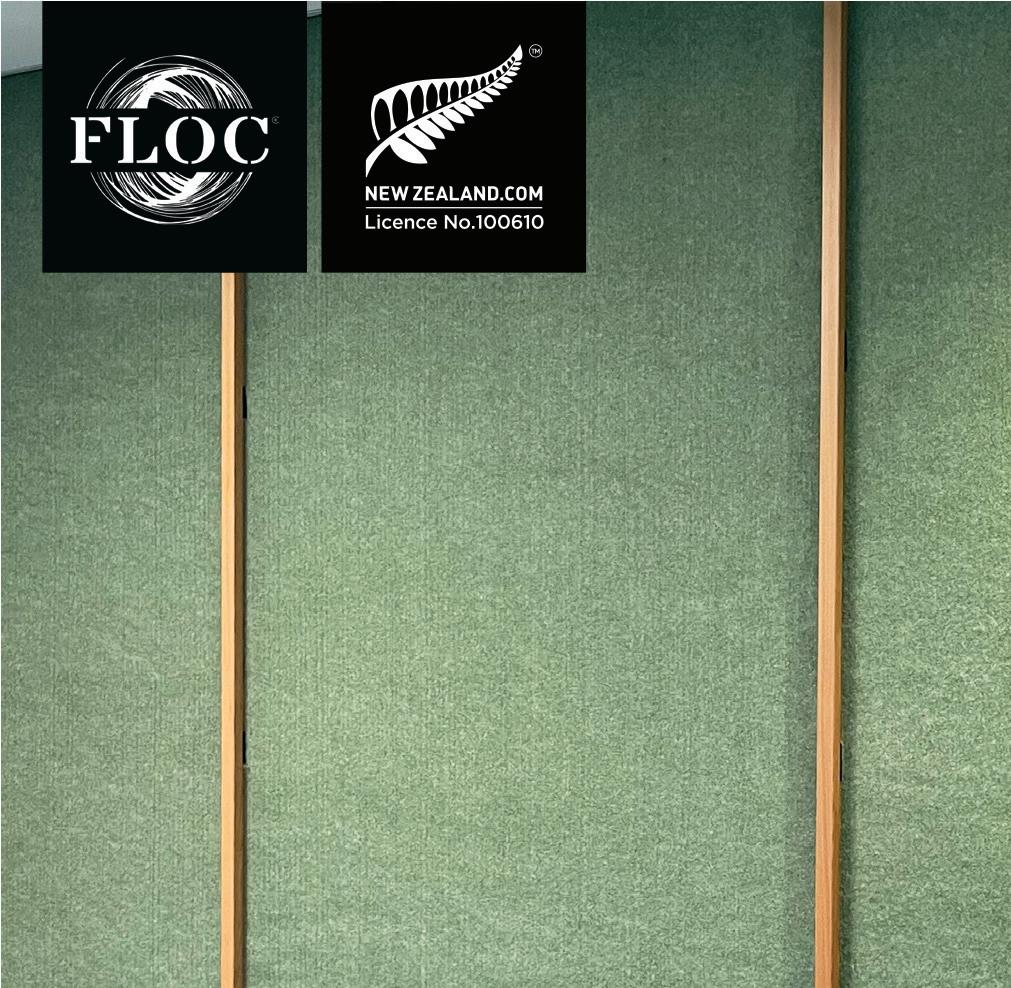




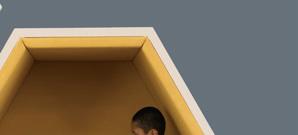
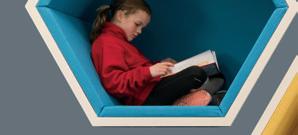
(ILE), also known as Modern Learning Environments or Flexible Learning Environments, are quickly becoming the standard for New Zealand Schools. Put simply, an ILE is a collaborative, flexible, futurefocused environment designed to evolve and adapt to changes in educational practices –supporting a modern approach to teaching and learning. While increasingly common, ILEs are complex, requiring meticulous planning and consideration.
The majority of schools in New Zealand were built during the 1950s to the 1970s, many of which are still in use to this day. Historically, students would be taught the same subjects by the same teacher using a traditional teaching method – focusing on the mass rather than the individual. Now, as research conducted on effective learning environments strongly indicates that students learn best when they are actively involved in decision making, initiate their own learning, collaborate, and make connections across learning areas, learning requirements and teaching methods have evolved significantly.
In order to provide better learning environments for Kiwi students,
the Ministry of Education started implementing ILEs throughout the country. In 2008, five schools were selected to participate in the Learning Studio Pilot Project. The studios were carefully designed to facilitate modern learning with specific emphasis placed on social and structural elements. Though slightly different in design, each studio consisted of a central learning area with modular walls connecting surrounding smaller rooms to the shared space. The openness and flexibility these spaces provided allowed students to work in both large and small groups, as a class, or individually.
When designing an ILE, it is important to consider how the







structural, social, and pedagogical attributes will function together. The eight structural design elements needed for ILEs are acoustics, insulation, air quality, heating, lighting, accessibility, sustainability, and health and safety. Vital to the success of ILEs, acoustics support clear communication and speech intelligibility— ensuring both students and teachers benefit from group and individual work. The Ministry of Education Designing Quality Learning Spaces guide states that, “Learning is about communication, and most people communicate using speech. If a classroom isn’t well designed for sound, speech can be hard to understand. Too much noise or reverberation may cause students to miss keywords, phrases and concepts… good acoustic design supports all students and creates a better place in which to learn and teach in.”
The pilot had a lot of positive feedback from students, parents, teachers, and principals; one school even claimed that their year seven student retention rate had increased significantly from 48% to 98%. When asked about the acoustic performance
of the spaces, teachers commented that outside noise from adjacent activities was not a distraction, and there was no need for their students, or themselves, to raise their voices to be heard effectively.
With the success of the Learning Studio Pilot Project, many established schools started the transition from traditional to modern ILE as part of their 10 Year Property Plan, while new schools incorporated ILEs into their campus design and construction. Auckland Normal Intermediate, who converted their specialist area into a ILE, have commented that since the transition attendance rates are high, behavioural issues are almost non-existent, students are motivated and engaged, and achievement levels have improved. The Education Review Office further commented saying that, “Achievement information shows that most students are achieving above national norms in many areas of the curriculum. This high achievement has been sustained over several years and students show good progress in their time at the school, especially in writing.”
